- Share full article
Advertisement
Supported by

Is It Safe to Travel to Mexico? Here’s What You Need to Know.
A spate of incidents, including a kidnapping and the death of two Americans near the border, have prompted travel warnings from the U.S. government.

By Elisabeth Malkin and Isabella Kwai
Two Americans found dead after they were attacked and kidnapped near the border. Airports shuttered amid gang violence in Sinaloa. Turmoil among taxi drivers in Cancún.
A number of recent security incidents have raised concerns about the risks of traveling to Mexico, where more than 20 million tourists flew last year to visit the country’s beaches, cities and archaeological sites, or to obtain health care .
Ahead of the spring break holiday, a popular time for American tourists to visit the country, the U.S. Embassy issued a travel alert , urging visitors to exercise caution by avoiding dangerous situations and drinking responsibly, among other recommendations. “Crime, including violent crime, can occur anywhere in Mexico, including in popular tourist destinations,” the alert said. And the State Department has warned tourists to steer clear of six states, including the state of Tamaulipas, where the recent kidnapping occurred — and to exercise increased precautions in other popular destinations like Playa del Carmen, Cancún, Tulum and Mexico City.
An overwhelming majority of visitors enjoy a safe vacation in Mexico, and tourists are largely sheltered from the violence that grips local communities. But the attack and kidnapping of four Americans in the border city of Matamoros, two of whom were later found dead, along with recent disorder in Cancún and violence in early January that forced the closure of three airports in northwest Mexico, is prompting questions about whether the country’s broader unrest is spilling into other destinations.
What happened on the border?
On March 3, four Americans from South Carolina traveling in a white minivan crossed the border from Brownsville, Texas, into the city of Matamoros, in the Mexican state of Tamaulipas. One of the Americans was scheduled for cosmetic surgery.
Soon after the Americans crossed the border, gunmen fired on their vehicle and then abducted the group in a pickup truck. Officials later said that two of the group were found dead at a rural location alongside the other two, who had survived.
The Americans were attacked as a result of “confusion,” according to Irving Barrios, the state prosecutor in Tamaulipas. Matamoros has a long history of violence and highway shootouts, though that reputation has partially subsided in recent years. Then, in late February, one gang moved into the city to wrest control of drug sales from another, said Eduardo Guerrero, the director of Lantia Intelligence , a security consulting company in Mexico City.
“There are places in the country where the situation can change abruptly from one week to another,” he said. While the motives in the attack remain unclear, the Americans had “very bad luck,” Mr. Guerrero said, because they likely stumbled into a battle between the two gangs.
What happened earlier this year in Cancún?
Uber has been challenging the taxi unions for the right to operate in Cancún and won a court decision in its favor on Jan. 11. The ruling infuriated the powerful unions, which are believed to have links to local organized crime figures and former governors. Taxi drivers then began harassing and threatening Uber drivers.
The conflict generated widespread attention after a video of taxi drivers forcing a Russian-speaking family out of their rideshare car went viral, and after unions blocked the main road leading to Cancún’s hotel zone. That prompted the U.S. Embassy in Mexico to issue a security alert .
Mr. Guerrero said that the authorities will try to negotiate some kind of compromise, but there was a probability of more violence ahead.
Have authorities curbed violence that might affect tourists?
As a rule, criminals in Mexico are careful not to kill tourists, Mr. Guerrero explained, because doing so “can set in motion a persecution that can last years,” the consequences of which can be “very dissuasive,” he said.
But the rule doesn’t always hold. And in two popular destinations for foreign tourists — Los Cabos , at the tip of the Baja California peninsula, and the Caribbean coast — local and state officials have recently sought help from the United States to take on organized crime that threatened to drive off tourists.
A spasm of violence at the end of 2021 and early 2022 rattled the tourist industry along the Riviera Maya, the 80-mile strip of Caribbean resorts south of Cancún. Two visitors were killed in crossfire between local gangs in Tulum; a gunfight on a beach in Puerto Morelos sent tourists running for cover into a nearby hotel; a hit man gained entry to a luxury hotel in Playa del Carmen and killed two Canadian tourists believed to have links to organized crime.
The federal government sent National Guard units to patrol the beaches, and Quintana Roo state authorities asked U.S. law enforcement agencies, including the Federal Bureau of Investigation and the Drug Enforcement Administration, to provide intelligence, Mr. Guerrero said. Local authorities, flush with tourism revenues, invested in the police, which is typically the weakest link in Mexican law enforcement.
The joint approach led to a lull in gangland gun battles in Quintana Roo’s tourist areas, and experts say that drug sales to meet foreign demand no longer take place on the street, although they are continuing more discreetly.
The success in tamping down drug violence in Quintana Roo follows a similar improvement in Los Cabos a couple of years ago when U.S. authorities also collaborated with local officials in the state of Baja California Sur. The murder rate soared in Los Cabos in 2017 amid cartel wars, and although tourists were not targeted, that year police chased gunmen into the lobby of a luxury hotel in San José del Cabo, and a cooler containing two heads was left in a tourist area.
What about tourist areas in other states?
Even in states where crime is very high, tourist areas have generally been spared. San Miguel de Allende, a haven for U.S. retirees, is an island of relative peace in a state, Guanajuato, that has been riddled with cartel violence .
The Pacific Coast state of Jalisco, home to the resort of Puerto Vallarta, picturesque tequila country and the cultural and gastronomic attractions of the state capital, Guadalajara , is also the center of operations of the extremely violent Jalisco New Generation Cartel . The cartel’s focus of violence is in the countryside; Puerto Vallarta and the beaches to its north, including the exclusive peninsula of Punta Mita and the surfers’ hangout of Sayulita, are all booming — and, despite drug sales, the cartel’s control seems to limit open conflict.
Mexico City has become a magnet for digital nomads and shorter term visitors , and concerns about violence there have receded. The city’s police force has been successful in reducing violent crime, particularly homicides, and the number of killings has been cut almost in half over the past three years.
Are there any other safety concerns?
Street crime is still a problem almost everywhere, especially in bigger cities and crowded spaces. Kidnapping and carjacking are a risk in certain regions and many businesses that cater to tourists operate under extortion threats. While tourists may not be aware of underlying criminal forces, their power sometimes spills out into the open in spectacular shows of violence.
The attack in Matamoros is only the most recent example. Mexican border cities, which have long endured waves of violence, are not typically tourist destinations, although Americans often cross the border to visit family, seek out cheaper health care or dine at restaurants.
Three airports in the state of Sinaloa, including the beach destination Mazatlán, were closed on Jan. 5 amid gang violence after Mexican security forces arrested Ovidio Guzmán López, a son of Joaquín Guzmán Loera, the crime lord known as El Chapo, who is serving a life sentence in the United States. A stray bullet fired by cartel gunmen shooting at a Mexican military plane as it landed at the airport in the state capital, Culiacán, clipped an Aeromexico plane preparing to take off for Mexico City. Nobody was hurt and the plane returned to the terminal.
In August, gunmen positioned burning cars and buses to block roads around Guadalajara in response to a military raid on a meeting of criminal bosses. In October, a local politician was shot and killed in an upscale steakhouse in suburban Guadalajara as terrified diners crawled to safety.
Pierre de Hail, the president of Janus Group Mexico, a risk management company in Monterrey, is skeptical that security has improved. “There is too much random risk,” he said. “It’s all about being in the wrong place at the wrong time.”
What precautions should tourists take?
Mr. de Hail recommends researching the resort and news from the area you’re visiting. The U.S. State Department provides state-by-state information about travel risks in Mexico. As of early March, the department had issued its strongest possible warning — Level 4: Do Not Travel — for six states, including Tamaulipas and Sinaloa. Quintana Roo and Baja California Sur are at Level 2, indicating that visitors should exercise increased caution. (By comparison, the same Level 2 advisory is applied to France and Spain.)
The Matamoros incident shows how violence can flare up in places that have been quiet recently. Mr. Guerrero suggests searching on the internet before traveling for news of recent outbreaks.
Mr. de Hail also suggests buying travel insurance in case of a medical emergency or theft, and recommends that tourists keep a low profile to avoid attracting attention, he said, warning that it is easy to misread situations.
As anywhere, common sense should prevail, Mr. de Hail said: Don’t wear expensive watches or jewelry, and avoid dark and deserted places. He recommends making a copy of your passport, remaining alert while walking home at night and not leaving your drinks unattended. “I have had numerous cases of people asking for help because they were extorted coming back from bars,” he said.
He added: “If you’re staying in a place that has a report of strikes or demonstrations, don’t go there. You’re a fish out of water.”
Follow New York Times Travel on Instagram , Twitter and Facebook . And sign up for our weekly Travel Dispatch newsletter to receive expert tips on traveling smarter and inspiration for your next vacation. Dreaming up a future getaway or just armchair traveling? Check out our 52 Places to Go in 2023 .
Isabella Kwai is a breaking news reporter in the London bureau. She joined The Times in 2017 as part of the Australia bureau. More about Isabella Kwai
Open Up Your World
Considering a trip, or just some armchair traveling here are some ideas..
52 Places: Why do we travel? For food, culture, adventure, natural beauty? Our 2024 list has all those elements, and more .
The Alaska Highway: On an epic road trip, a family plots a course from Alaska to the Lower 48, passing through some of Canada’s most spectacular scenery .
Minorca: Spend 36 hours on this slow-paced Spanish island , which offers a quieter and wilder retreat than its more touristy neighbors.
Japan: A new high-speed train stop unlocks Kaga, a destination for hot springs, nourishing food and traditional crafts , as an easy-to-reach getaway from Tokyo.
London: The Victoria and Albert Museum is a treasure trove of art and design. Here’s one besotted visitor’s plan for taking it all in .
Should travelers worry about being kidnapped in Mexico? Travel experts discuss safety in Mexico.

The high-profile case of four U.S. citizens being kidnapped in Mexico sent shock waves through the nation. Two were killed last week after getting caught in the crossfire of cartel violence in the border city of Matamoros.
Many are wondering what's next for the popular tourist destination, and whether Mexico is safe for travel.
The four Americans – one woman and two men from South Carolina – crossed the southern border for cosmetic surgery last Friday when a cartel shootout erupted.
Social media videos show the gunmen pulling the Americans from their car and driving away, all during daylight. Mexican officials announced Tuesday that they had found two dead. the other The two survivors were escorted back to the U.S.
Is it safe to take a taxi in Cancun?: Here are the safest ways to get around, per travel agents.
Learn more: Best travel insurance
With 2 Americans dead in Matamoros: A cartel-scarred Mexican border town wonders what's next
Violence around border cities is not unusual and can involve Mexicans or migrants with little public attention, but it typically doesn't involve Americans. Officials said the abduction was probably a case of mistaken identity , but the FBI is investigating further.
Meanwhile, questions arose on how the Mexican and U.S. governments will respond, which could affect regular travel to Mexico. A heavy-handed response could likely mean "a wave of violence where it gets worse before it gets better," said Michael Ballard, director of intelligence at Global Guardian , a firm that specializes in travel security.
Currently, the travel advisory for Mexico warns Americans of crime and kidnapping. On Tuesday, White House press Secretary Karine Jean-Pierre said the State Department takes it "seriously" when it comes to providing "clear, timely, and reliable information about every country in the world ... so they can make informed travel decisions."
Is Mexico safe to travel to?
In 2021, nearly 29 million American travelers headed down to Mexico. That same year, about 75 American citizens died by homicide in Mexico, according to the most recent U.S. State Department statistics.
Mexico is "a tricky place" when it comes to travel and safety because "the security landscape and the security dynamic is so different state to state and city to city," according to Ballard.
Unlike some other countries, Mexico's travel advisory assesses each state individually.
The agency issued a "do not travel to" warning for the Colima, Guerrero, Michoacan, Sinaloa, Tamaulipas and Zacatecas state because of violent crime.
"You probably don't want to go to one of these border cities" because cartels "contest these ports of entry pretty heavily and fight for their economic control," Ballard said.
When it comes to the "do not travel to warning," Jean-Pierre said, "We've been very clear about that. The State Department, again, has put that out. We urge Americans to read these alerts before traveling."
Popular tourist spots like Quintana Roo, Nayarit and Mexico City have warnings of "exercised increased caution when traveling to" and Jalisco, where Puerto Vallarta is, has a "reconsider travel to." Travelers can "exercise normal precautions" when traveling to Yucatan, which includes the popular attraction Chichén Itzá.
How likely is it to encounter cartel violence?
"I don’t think anyone can ensure 100% clearance on (avoiding cartel violence), unfortunately. We know that Mexico has been plagued by drug violence, and cartels are in many parts of the country, just as in other nations," said Vanessa Karel, a Latinx entrepreneur who founded Greether , a travel startup that helps women travel with fewer risks.
"However, it is well documented that some areas have a higher presence of violence. Please do your due diligence on which areas these are," she said. Steer clear of these areas and avoid taking part in anything drug-related, Karel advised.
Ballard agreed and offered this analogy: "Getting struck by lightning is a really rare occurrence, but if you are standing on top of a tree in a thunderstorm, those odds go up. That's how I view being in and around some of these higher-risk cities in Mexico, the border cities."
Getting caught in cartel activity is less common somewhere like Cancun than it is in Colima.
Because Mexico's economy heavily depends on tourism dollars, cartels "tend to stay away from harming or hurting Americans because they know the response would be pretty severe," Ballard said.
The Mexican government has also implemented several initiatives to maintain safety in high-tourist areas, like deploying tourist police forces to high-traffic visitor areas. These officers are easy to spot and usually speak English.
"Travelers will have fewer risks by staying at highly rated hotels, areas and booking tour guides to show them around," Karel said.
Should people be worried about being kidnapped in Mexico?
Being "in the wrong place at the wrong time" is the main risk for Americans and cartel activity, Ballard said. It's rare for Americans to be kidnapped by cartels for ransom.
He does warn of occasional "express kidnappings," which happen not just in Mexico but in other countries too. In this situation, a tourist who is likely drunk and wandering around downtown gets kidnapped, driven around to ATMs and forced to withdraw money. Usually, they end up being let go.
As long as you stay in resort areas and use common sense, it should be relatively easy to keep safe.
Check out USA TODAY's 17 travel safety tips from the CIA .
What should you do if you witness or encounter cartel crime?
If you do witness or encounter cartel crime such as an express kidnapping or carjacking, Ballard said, you should report the case to the U.S. Embassy or to the local equivalent of 911. "You definitely want to have a record of something like that out there." Unfortunately, response times can be slow depending on where you are, he said.
According to the State Department , if something happens, you'll probably be relying on local resources.
Global Guardian clients, he pointed out, have a 24/7 panic button on the Global Guardian app, which will connect users to a safe haven, like a hospital.
In some cases, he said, your response depends on the situation, and it may be best to cooperate.
Top safety tips
Karel's top rule for traveling to Mexico is "to plan on going to places that are designed for you to go. If you are trying to visit an area that not even locals feel comfortable going to, don't attempt it, and please, simply avoid it," she said.
She also advised people to have situational awareness. "We are concerned that travelers going to Mexico think they can go just about anywhere, especially when they don’t blend as a local," she said. Visitors "should be aware of how much they stand out and how little or how much they know about the area they are going to."
Here are some other safety tips when traveling in Mexico:
- Travel during daylight hours and avoid walking around unknown areas, especially at night.
- Don't walk around with jewelry or your head down looking at your phone because that makes you an easy target to get robbed, Ballard said.
- "Please ask trustworthy travel businesses and, most importantly, check travel advisories and what the tourism boards say. T they are there for a reason, and a lot of us are fighting to make cities safer and more sustainable," Karel said.
- Enroll in the Smart Traveler Enrollment Program , a free service for U.S. travelers to receive safety alerts about their destination from the U.S. Embassy in real time.
- Before departing on your trip to a high-risk area, the State Department recommended you share important documents and points of contact with someone at home, and create a communication plan if something were to happen.
- Share your location via your smartphone with someone at home while you are abroad.
- Consider purchasing travel insurance for kidnapping or ransom. Depending on the plan, it can cover ransom payments, emergency evacuation costs, and payment for any negotiations needed.
Contributing: Michael Collins, USA TODAY
Kathleen Wong is a travel reporter for USA TODAY based in Hawaii. You can reach her at [email protected].
- Skip to primary navigation
- Skip to main content
- Skip to primary sidebar
- Skip to footer
TravelAwaits
Our mission is to serve the 50+ traveler who's ready to cross a few items off their bucket list.
U.S. State Department Renews Warning About Travel To Mexico — Where It Says Visitors Can Travel This Spring

- News and Tips
- Travel News
Mexico is one of the most popular international destinations for American travelers. Cancun, Tulum, and Playa del Carmen particularly draw high numbers of tourists from the U.S.
However, as the spring break and Easter travel season approaches, anyone planning a trip to Mexico this spring must reckon with the sobering news of four Americans who were recently attacked by gunmen while traveling in Mexico.
The four individuals had traveled to Mexico so one could have a medical procedure. Then, in the city of Matamoros in Tamaulipas state, just south of Brownsville, Texas, the four were shot at and kidnapped. Two of them were killed in the gunfire. The other two, one of whom was also shot, have now been returned to the U.S., according to NBC News .
The U.S. Embassy & Consulates in Mexico issued a statement reminding U.S. citizens that it previously issued a travel advisory listing Tamaulipas state as a “Level 4: Do Not Travel” area in Mexico.
The natural inclination for anyone planning to travel to Mexico, as well as for family and friends of those prospective travelers, is now to question whether or not it’s safe to visit Mexico.
Zachary Rabinor, founder and CEO of the travel company Journey Mexico, says it’s important to remember that the Americans were killed and kidnapped a long distance from popular tourist destinations in Mexico.
“To put things in perspective, Matamoros is about 1,360 miles away from Cancun,” Rabinor said, according to CNN . “That’s about the equivalent distance from the Texas side of the border to Chicago, Illinois.”
Jaime Lopez-Aranda, a senior security manager at travel risk management firm International SOS, agrees that popular resort areas are still fairly safe.
“It is relatively safe for travelers to head to tourist destinations and major urban centers such as Mexico City, Guadalajara, and Monterrey,” Lopez-Aranda told CNN Travel.
Importantly, the U.S. State Department has issued a number of advisories for U.S. citizens traveling to various Mexican states in recent weeks. Now, as violent crime and kidnapping rates increase across Mexico, Americans considering travel to all but two of the states in Mexico should be aware of renewed and increased warnings, the State Department cautions.
“Violent crime — such as homicide, kidnapping, carjacking, and robbery — is widespread and common in Mexico,” the State Department explains .
“The U.S. government has limited ability to provide emergency services to U.S. citizens in many areas of Mexico, as travel by U.S. government employees to certain areas is prohibited or restricted,” the State Department continues. “In many states, local emergency services are limited outside the state capital or major cities.”
Here are the State Department’s travel advisories for each of Mexico’s states.
Do Not Travel To
The State Department advises U.S. citizens to not travel to five states in Mexico due to increasing levels of crime and kidnapping.
Those states are Colima (where Manzanillo is located), Michoacan, Sinaloa (where Mazatlán is located), Tamaulipas, and Zacatecas (home to Zacatecas City).
Guerrero — where Acapulco, Zihuatanejo, and Ixtapa are located — is also on the State Department’s “Do Not Travel” list because crime is widespread in those areas.
Reconsider Travel To
The State Department advises U.S. citizens to “reconsider travel” to five states in Mexico due to crime and kidnapping.
Those states are Baja California (where Tijuana is located), Chihuahua, Guanajuato (where Guanajuato City is located), Jalisco (home to Guadalajara and Puerto Vallarta), and Sonora.
The states of Durango and Morelos are also on the State Department’s “Reconsider Travel To” list due to high crime rates.
Exercise Increased Caution When Traveling To
The State Department advises U.S. citizens to “exercise increased caution when traveling to” 17 areas of Mexico, primarily due to crime rates but also due to the threat of kidnapping in some places.
Those states are Aguascalientes, Baja California Sur (where Cabo San Lucas , San Jose del Cabo, and La Paz are located), Chiapas, Coahuila, Hidalgo, Mexico State, Nayarit, Nuevo Leon, Oaxaca (home of Oaxaca City and Huatulco), Puebla, Queretaro, Quintana Roo (where Cancun , Cozumel, Tulum, and Riviera Maya are located), San Luis Potosi, Tabasco, Tlaxcala, and Veracruz.
Mexico City is also on the list due to high crime rates.
Exercise Normal Precautions When Traveling To
The State Department advises U.S. citizens to “exercise normal precautions when traveling to” Campeche and Yucatan, where Chichen Itza and Merida are located.
Know Before You Go
If you decide to travel to Mexico, the State Department offers some guidance.
“Exercise increased caution when visiting local bars, nightclubs, and casinos,” the State Department recommends. “Do not display signs of wealth, such as wearing expensive watches or jewelry. Be extra vigilant when visiting banks or ATMs.”
U.S. citizens with an emergency are also reminded that they can call the U.S. Embassy & Consulates in Mexico for help.
U.S. citizens on their way to Mexico are also advised to make a note of U.S. Embassy & Consulates emergency contacts in the area where they will be traveling.
Finally, the State Department recommends international travelers enroll in STEP, the Smart Traveler Enrollment Program .
Doing so enables U.S. citizens and nationals traveling and living abroad to enroll their trip with the nearest U.S. Embassy or consulate. That way travelers can receive important information from the Embassy about safety conditions in their destination country, make it easy for the U.S. Embassy to contact travelers in the event of an emergency, and also make it easier for family and friends to contact travelers in case of an emergency.
For more about changing travel conditions in countries around the world, be sure to read our Travel News content, including:
- New Cost To Travel To Europe Delayed Until 2024 — What Visitors Need To Know
- Traveling To Europe This Spring? 5 Countries Where Strikes Could Affect Your Trip
- TSA Is Asking Travelers With Pets To Stop Doing This One Thing — Here’s What It Is

Jim Fulcher has been a writer and editor his entire career. In addition to writing, he also enjoys traveling--particularly in an RV. Over the course of numerous trips, Jim has driven an RV through West Virginia, Virginia, Tennessee, Kentucky, Indiana, Illinois, Wisconsin, Iowa, Nebraska, South Dakota, and Wyoming. His favorite national park is Yellowstone, which he has visited three times.
Travel | Mexico danger map: Six states under ‘do not…
Share this:.
- Click to share on Facebook (Opens in new window)
- Click to share on Twitter (Opens in new window)
- Click to print (Opens in new window)
- Click to email a link to a friend (Opens in new window)
- Click to share on Reddit (Opens in new window)
Today's e-Edition
Things To Do
- Food & Drink
- Celebrities
- Pets & Animals
- Event Calendar
Breaking News
Travel | crews battle new blaze northwest of corral fire, travel | mexico danger map: six states under ‘do not travel’ warning.
Amid announcements of new safety concerns in Mexico at the start of 2023, the official U.S. State Department travel advisories remained as they had been for several months, with six states in the “do not travel” classification.
The map above shows the advisory level for each Mexican state.
Level 4 : The six states with the “do not travel” advisory, because of kidnappings and other crimes, are the northern border state of Tamaulipas, the central state of Zacatecas and the Pacific coast states of Sinaloa, Colima, Michoacán and Guerrero.
Level 3 : The seven states for which visitors are advised to “reconsider travel” because of crime are Baja California (Norte), Sonora, Chihuahua, Durango, Guanajuato, Jalisco and Morelos.
Level 2 : Except for the two Level 1 states, travelers to all the rest are advised to “exercise increased caution.” They are: Aguascalientes, Baja California Sur, Chiapas, Coahuila, Hidalgo, state of Mexico, Nayarit, Nuevo Leon, Oaxaca, Puebla, Queretara, Quintana Roo, San Luis Potosi, Tabasco, Tlaxcala and Veracruz. Mexico City (Distrito Federal) is Level 2.
Level 1: The State Department advises “normal precautions” when traveling to Campeche or Yucatán, shown in green.
In addition to the general tourist warnings, specific prohibitions are issued to U.S. government employees staying or traveling in Mexico. The State Department advises that all U.S. travelers adhere to those rules.
On Jan. 12, 2023, Mexico City’s mayor announced that more than 6,000 National Guard officers would be posted in the city’s subway system after a series of accidents that officials said could be due to sabotage. The previous week, in-person services were suspended at the U.S. Consular Agency in Mazatlán because of violence across Sinaloa .
Click here for the full document on the warnings.
- Report an error
- Policies and Standards
More in Travel

Travel | Booze with a view: 8 rooftop bars to check out in Las Vegas

SUBSCRIBER ONLY
Travel | rafting through the grand canyon is every bit as magical as it sounds.

Restaurants, Food and Drink | Meet the chef with Michelin cred who runs the kitchen at Healdsburg’s Jordan Winery

Travel | Travel Troubleshooter: I canceled my airline tickets months ago, so where’s my money?
- Skip to main content
- Skip to "About this site"
Language selection
Search travel.gc.ca.
Help us to improve our website. Take our survey !
COVID-19: travel health notice for all travellers
Mexico travel advice
Latest updates: Safety and security - removed information on general elections
Last updated: June 3, 2024 13:28 ET
On this page
Safety and security, entry and exit requirements, laws and culture, natural disasters and climate, mexico - exercise a high degree of caution.
Exercise a high degree of caution in Mexico due to high levels of criminal activity and kidnapping.
Regional Advisory - Avoid non-essential travel
- Chiapas, excluding the cities of Palenque via highway 186 from Villahermosa, San Cristobal de las Casas and Tuxtla Gutiérrez
- Chihuahua, excluding Chihuahua City
- Colima, excluding the city of Manzanillo if accessed by air
- Guerrero, excluding the cities of Ixtapa/Zihuatanejo if accessed by air
- Jalisco, within 50 km of the border with Michoacán state
- the Lagunas de Zempoala National Park in Morelos
- Michoacán, excluding the cities of Morelia and Patzcuaro
- in Nayarit, within 20 km of the border with the states of Sinaloa and Durango
- Nuevo León, excluding the city of Monterrey
- Sinaloa, excluding the cities of Los Mochis and Mazatlán
- Sonora, excluding the cities of Hermosillo, Guaymas/San Carlos and Puerto Peñasco
- Tamaulipas, excluding the cities of Tampico and Recce
- all Zacatecas, excluding Zacatecas City
Back to top
Levels of crime, particularly violent crime, are high throughout Mexico. Arrest and detention rates are low and don’t deter criminal activity.
Criminal groups, including drug cartels, are very active. Clashes between cartels or gangs over territory, drugs and smuggling routes are common.
In some parts of the country, military, navy and federal police forces have been deployed to combat organized crime and improve security conditions. They maintain a visible presence by:
- patrolling the streets
- setting up roadblocks
- conducting random vehicle checks
If you plan on travelling to Mexico:
- remain vigilant at all times
- stay in tourist areas
- be very cautious on major highways
- avoid travelling at night
- monitor local media closely
If you’re the victim of a crime, you must report it immediately to local authorities. No criminal investigation is possible without a formal complaint. Complaints must be made in person before leaving Mexico. You should hire a local lawyer to represent your interests and follow up on your case after you return to Canada. Failure to do may result in incomplete investigations or long delays in bringing cases to trial.
Violent crime
There are high rates of violent crime, such as homicides, kidnappings, carjacking and assaults, including in popular tourist destinations such as the Mayan Riviera (Cancún, Playa del Carmen, Puerto Morelos and Tulum), and Acapulco.
Criminal groups and drug cartels are present in tourist areas. Inter-gang and cartel fighting has taken place in restaurants, hotels and nightclubs frequented by tourists.
Innocent bystanders have been injured or killed. You may be in the wrong place at the wrong time and become a victim of violent crime.
Border areas often see higher criminal activity and violence, including in rural areas. Confrontations between organized criminal groups and Mexican authorities continue to pose a risk. Shootouts, attacks and illegal roadblocks may occur without warning.
You should travel to Mexico by air to avoid international land border crossings, particularly along the border with the United States, in the following cities:
- Ciudad Juárez
- Nuevo Laredo
If crossing an international land border:
- remain extremely vigilant
- use only official border crossings
Armed robbery
Armed robbery occurs. Foreigners have been targets of robberies that sometimes involve assault.
Robbers will follow a victim after they exchange or withdraw money at airports, currency exchange bureaus ( casas de cambio ) or ATMs.
- Stay in hotels and resorts with good security
- If you are threatened by robbers, stay calm and don’t resist
- Avoid withdrawing or exchanging money in public areas of the airport
Canadian travellers have been physically and sexually assaulted. In some cases, hotel employees, taxi drivers and security personnel at popular tourist destinations were involved. In some cases, hotel staff are not helpful and try to dissuade victims from pursuing the incident with police.
- Avoid walking after dark, especially alone
- Avoid isolated or deserted areas
- Avoid excessive alcohol consumption
Are you a victim of sexual violence? – Government of Canada and British Embassy Mexico City
Credit card and ATM fraud
Credit card and ATM fraud occurs in Mexico. When using debit or credit cards:
- pay careful attention when others are handling your cards
- use ATMs located in public areas or inside a bank or business
- avoid using card readers with an irregular or unusual feature
- cover the keypad with one hand when entering your PIN
- check for any unauthorized transactions on your account statements
Overcharging
Some bars and nightclubs may try to charge exorbitant prices. Discussions about overcharging may lead to threats of violence and security guards may force you to pay. Avoid running a tab or leaving your credit card with bar or restaurant staff.
Overseas fraud
Police officers
Legitimate police officers have extorted money from tourists or arrested tourists for minor offences such as :
- drinking alcohol on the street
- urinating on public roads
- traffic violations
They have requested immediate cash payment in exchange for their release. Travellers driving rental cars have been targeted.
If this occurs:
- don’t hand over your money or your passport
- ask for the officer’s name, badge and patrol car number
- ask for a copy of the written fine, which is payable at a later date, or insist on going to the nearest police station
Virtual kidnappings
Extortion, including virtual kidnappings, is the third most common crime in Mexico. Criminals use a variety of tactics to gather information about potential victims for extortion purposes, including using social media sites or eavesdropping on conversations
In a virtual kidnapping, criminals contact the victim’s hotel room landline and threaten the victim to stay in their room. The criminals then instruct the victim to provide information needed for the caller to use to contact family and friends, to demand the immediate payment of ransom for their release.
- Don't discuss travel plans, your room number or any other personal information around strangers
- Never leave your cellphone unattended
- Ensure your cellphone is password protected
- Don't divulge personal business details to strangers in person or over the phone or on social media, especially when using hotel phones
- If you're threatened on the phone or hear screams, hang up immediately
- When you answer the phone, wait for the caller to speak. If the caller asks who is speaking, hang up immediately.
- Don’t answer unrecognized or blocked phone numbers
- Don’t answer hotel landlines
Kidnappings
Mexico has one of the highest kidnapping rates in the world. Kidnapping, including virtual and express kidnapping, is a serious security risk throughout Mexico.
Kidnappers target all classes. Canadian citizens and contractors working for Canadian businesses have been kidnapped, mostly in areas that are not under the control of police and security forces.
If you're kidnapped:
- comply with the kidnappers’ requests
- don’t attempt to resist
Express kidnappings
Express kidnappings occur in large urban areas. This is a method of kidnapping where criminals ask for a small and immediate ransom.
Thieves most commonly work in cooperation with, or pose as, taxi drivers. They force victims to use their debit or credit card to withdraw money from ATMs in exchange for their release.
- Use only a reputable taxi company or a trusted ride-sharing app
- Book taxis through your hotel or an authorized taxi stand ( sitio )
Petty theft
Petty crime, such as pickpocketing and purse snatching, is common in Mexico.
- Be aware of your surroundings at all times, even in areas normally considered safe
- Ensure that your belongings, including your passport and other travel documents, are secure at all times
- Avoid showing signs of affluence, such as flashy jewellery, cell phones, headphones and designer bags
- Carry only small amounts of money
- Be cautious when withdrawing cash from ATMs
Home break-ins
Tourists staying in rental homes have been the victims of break-ins and burglaries. Whether you're staying in private or commercial accommodations, make sure you lock windows and doors securely.
Women’s safety
Women travelling alone may be subject to some forms of harassment and verbal abuse.
Some incidents of assault, rape and sexual assault against Canadian women have occurred, including at beach resorts and on public buses.
- Exercise caution when dealing with strangers or recent acquaintances
- Be wary of rides or other invitations
Advice for women travellers
Spiked food and drinks
Never leave food or drinks unattended or in the care of strangers. Be wary of accepting snacks, beverages, gum or cigarettes from new acquaintances. These items may contain drugs that could put you at risk of sexual assault and robbery.
Unregulated alcohol
Some bars, restaurants and resorts have served counterfeit alcohol. Some travellers have reported getting sick or blacking out after drinking alcohol.
- Be cautious if you choose to drink alcohol
- Seek medical assistance if you begin to feel sick
Alcohol, drugs and travel
Height standards for balcony railings in Mexico can be considerably lower than those in Canada. Falls have resulted in deaths and injuries.
- Exercise caution when standing close to balcony railings
Demonstrations
Demonstrations take place regularly throughout the country. Protests and roadblocks are common in:
- Mexico City, including to and from the airport
- the states of Chiapas, Guerrero, Michoacán and Oaxaca
Such incidents may last a long time, leading to shortages of fresh food, medicine and gasoline.
Even peaceful demonstrations can turn violent at any time. They can also lead to disruptions to traffic and public transportation.
- Avoid areas where demonstrations and large gatherings are taking place
- Follow the instructions of local authorities
- Monitor local media for information on ongoing demonstrations
Mass gatherings (large-scale events)
Water activities
Coastal waters can be dangerous. Riptides are common. Several drownings occur each year.
Many beaches don’t offer warnings of dangerous conditions and they don’t always have lifeguards on duty.
Rescue services may not be consistent with international standards.
- Consult local residents and tour operators for information on possible hazards and safe swimming areas
- Always obey warning flags at beaches
- Follow the instructions and warnings of local authorities
Water sports
Tour operators may not adhere to international standards. Many operators don’t conduct regular safety checks on their sporting and aquatic equipment.
Also, Canadians have been involved in accidents where operators of recreational vehicles, such as watercraft, have demanded compensation exceeding the value of the damage caused to the vehicle or equipment.
If you undertake water sports, such as diving:
- choose a well-established and reputable company that has insurance
- ensure that your travel insurance covers the recreational activities you choose
- wear the appropriate safety equipment, such as helmets and life jackets
- ensure that equipment is available and in good condition
- don’t consume alcohol before the activity
If in doubt concerning the safety of the facilities or equipment, don’t use them.
Water safety abroad
Adventure tourism
Outdoor activities, such as white water rafting, kayaking, scuba diving, snorkelling, bungee, zip lining, paragliding, hiking, mountain biking, etc and other adventure activities can be dangerous if unprepared. Trails are not always marked, and weather conditions can change rapidly, even during summer.
Tour operators may not always adhere to international safety standards.
If you intend to practice adventure tourism:
- consider hiring an experienced guide from a reputable company
- obtain detailed information on your activity and on the environment in which you will be setting out
- buy travel insurance that includes helicopter rescue and medical evacuation
- know the symptoms of acute altitude sickness, which can be fatal
- pay attention to the symptoms of dehydration and heatstroke, both of which can be fatal
- avoid venturing off marked trails
- ensure that you’re adequately equipped and bring sufficient water
- stay informed about weather and other conditions that may pose a hazard
- refrain from using facilities or equipment if you have doubts on their safety
- inform a family member or friend of your itinerary
Road travel
Road conditions and road safety.
Road conditions and road safety can vary greatly throughout the country.
Road conditions can be dangerous due to:
- sharp curves
- poorly marked or hidden road signs
- construction sites
- roaming livestock
- slow-moving or abandoned vehicles
Toll highways are typically safer and better maintained than secondary highways.
Mexican driving styles are very different from those in Canada. Many drivers don’t respect traffic laws, and police don’t strictly enforce these laws. Drivers often drive at excessive speeds and may be aggressive or reckless. Drinking and driving laws are not strictly enforced. Accidents causing fatalities are common. Police don’t regularly patrol the highways.
Roadblocks and checkpoints
Illegal roadblocks and demonstrations are common. Heavily armed gangs have attacked travellers on intercity highways. Criminals especially target sport utility vehicles and full-size pickup trucks for theft and carjacking.
The military searches for drugs and firearms at military checkpoints throughout the country.
- Avoid road travel at night between cities throughout the country
- Ensure that you only stop in major centres, at reputable hotels or at secure campsites
- Keep your car doors locked and the windows closed, especially at traffic lights
- Avoid hitchhiking which is not a common practice in Mexico
- Don’t leave valuables in the vehicle
- Rent cars that don’t have stickers or other advertisements for the rental company on them, as rental cars have been targets for robbery, sometimes using force
- Ensure operators provide insurance and helmets if renting scooters
- Travel on toll roads to lower the risk of targeted roadblocks and robberies
- Never attempt to cross roadblocks, even if they appear unattended
Public transportation
Remain vigilant in airports, at bus stations, on buses and on the metro.
The Mexico City metro is often very crowded and a popular place for pickpocketing. There are metro cars dedicated to women and children during rush hours. They are located at the front of the trains.
The Metrobus in Mexico City, which has dedicated lanes and stops, is relatively safe. There are sections dedicated to women and children at the front of the buses.
The “colectivos” and “pesero” mini-buses that stop when hailed are frequently targeted for robbery.
When travelling to other cities, use bus companies that offer VIP or executive class transportation. These buses only travel on toll roads, which lower the risks of targeted roadblocks and robberies, and follow a speed limit.
Taxis and ridesharing services
Disputes between taxi and ridesharing application drivers may occur, especially in Quintana Roo. They may result in:
- altercations
Although tourists have not been targeted, you may be caught up in these incidents and harassed or injured.
In Mexico City, all government-authorized taxis have licence plates starting with “A” or “B.” Taxis from designated stands have both the logo of their company and the plate number stamped on the side of the car. Official taxis in Mexico City are pink and white. Users can validate the pink and white taxis on the CDMX app.
- Avoid hailing taxis on the street
- Don't share taxis with strangers
When arriving at an airport in Mexico, pre-pay the taxi fare at the airport (inside or outside the terminal) and ask to see the driver’s official identification. You can also use a ridesharing app to arrange for a pickup at certain airports. Not all airports in Mexico allow ridesharing service pickups.
If you use a trusted ridesharing app, confirm the driver’s identity and the licence plate before getting in the car.
Mi Taxi – CDMX app (in Spanish)
Cruise ship travel
Plan carefully if you plan to take a cruise departing from or stopping in Mexico.
Advice for cruise travellers
Pirate attacks and armed robbery against ships occur in coastal waters of the Bay of Campeche. Mariners should take appropriate precautions.
Live piracy report - International Maritime Bureau
We do not make assessments on the compliance of foreign domestic airlines with international safety standards.
Information about foreign domestic airlines
Every country or territory decides who can enter or exit through its borders. The Government of Canada cannot intervene on your behalf if you do not meet your destination’s entry or exit requirements.
We have obtained the information on this page from the Mexican authorities. It can, however, change at any time.
Verify this information with the Foreign Representatives in Canada .
Entry requirements vary depending on the type of passport you use for travel.
Before you travel, check with your transportation company about passport requirements. Its rules on passport validity may be more stringent than the country’s entry rules.
Regular Canadian passport
Your passport must be valid for the expected duration of your stay in Mexico.
Passport for official travel
Different entry rules may apply.
Official travel
Passport with “X” gender identifier
While the Government of Canada issues passports with an “X” gender identifier, it cannot guarantee your entry or transit through other countries. You might face entry restrictions in countries that do not recognize the “X” gender identifier. Before you leave, check with the closest foreign representative for your destination.
Other travel documents
Different entry rules may apply when travelling with a temporary passport or an emergency travel document. Before you leave, check with the closest foreign representative for your destination.
Useful links
- Foreign Representatives in Canada
- Canadian passports
Tourist visa: not required Business visa: required Work visa: required Student visa: required
Required documents
To enter Mexico, you must present a valid passport and a duly completed tourist card (Multiple Immigration Form). Carry documents to prove the purpose of trip, such as hotel or tour booking confirmations, as immigration officers may request them.
Tourist card
You must obtain a tourist card to enter the country unless you stay in Mexico for less than 72 hours within the northern border zone.
If you don’t obtain a tourist card upon arrival, you may face:
It is highly recommended to keep your digital tourist card, or tourist card if entered by land, with you at all times as proof of your legal stay in Mexico. You may be asked to show it to Mexican officials when exiting the country or if you are stopped on an immigration check point.
If you are stopped at an immigration check point and you are unable to prove your legal stay, you may be fined, detained or expelled from the country.
Entering by land
If entering Mexico by land, you must stop at the immigration office located at the border to obtain a tourist card, even if not explicitly directed by Mexican officials. Immigration officials will write down on your tourist card the number of days you are allowed to stay in Mexico.
You may complete the tourist card form online before your arrival. However, you must print the form and present it to the migration official at the port of entry.
Multiple Immigration Form - Government of Mexico
Entering by air
If entering Mexico by air, you are advised to download your tourist card issued by Mexican officials upon entry.
Depending on your airport of entry:
- the immigration official will stamp your passport and note the number of days you are allowed to spend in Mexico or
- you will go through an E-gate kiosk where you will scan your passport and self-register your entry in the country. Only use this option if you are entering Mexico as a tourist.
Once in the country, whether you entered via a E-gate or not, you will be able to access the digital tourist card online. You have 60 days to download it.
If you are unable to show your tourist card or digital tourist card upon departure, you will have to pay for a replacement at the immigration office of any international airport before boarding.
Make sure to plan sufficient time at the airport to obtain a new card in time for your flight.
Portal access for digital tourist card - Government of Mexico
Length of stay
An immigration official will determine the number of days you can remain in Mexico and note it on your tourist card. The maximum length granted for a tourism-related trip is 180 days; the maximum number of days is not granted by default.
If you're seeking the maximum number of days, you may be required to:
- explain the purpose of your trip to the immigration official
- provide details about your trip (accommodations, funds, return flight, etc.)
You won’t be able to request an extension or change the condition of your stay from inside the country.
Canadians travelling to the northern border zone (within 21 kilometres of the U.S. border) for work don’t require a visa for stays of 72 hours or less.
If you require a business or work visa, you should take care of the process yourself. If a prospective employer is processing your visa for you:
- obtain copies of all correspondence between the employer and Mexican immigration authorities
- verify that these copies are stamped by the immigration authorities as proof that your papers are being processed
- request a receipt from your employer for any document that you provide for purposes of obtaining the visa
- avoid surrendering your passport to your employer
Volunteer, religious, research and eco-tourism activities
You may not be able to undertake volunteer, religious/missionary, research or certain forms of eco-tourism activities while visiting as a tourist. Contact the Mexican Embassy or closest Mexican consulate for information the type of visa required for these activities.
Tourism tax
Most visitors to Mexico must pay a tourism tax.
This fee is normally included in airline ticket prices. Visitors arriving by road or sea will have to pay this fee at any bank in Mexico. There is a bank representative at every port of entry. The bank receipt must be attached to the tourist card for submission at departure.
You don't have to pay this tax if:
- you're entering by land for tourism purposes, and your stay will not exceed 7 days
- you're travelling to the northern border zone for less than 72 hours
- you're travelling to Mexico on a cruise ship
Dual citizenship
If entering and leaving Mexico as a dual citizen, you must identify yourself as a Mexican citizen. You must carry valid passports for both countries.
Laws about dual citizenship
Criminal records
Canadians with a criminal record or a warrant for arrest may be refused entry and returned to Canada or to a third country on the next available flight.
Children and travel
Learn more about travelling with children .
Yellow fever
Learn about potential entry requirements related to yellow fever (vaccines section).
Relevant Travel Health Notices
- Global Measles Notice - 13 March, 2024
- Zika virus: Advice for travellers - 31 August, 2023
- COVID-19 and International Travel - 13 March, 2024
- Dengue: Advice for travellers - 6 May, 2024
This section contains information on possible health risks and restrictions regularly found or ongoing in the destination. Follow this advice to lower your risk of becoming ill while travelling. Not all risks are listed below.
Consult a health care professional or visit a travel health clinic preferably 6 weeks before you travel to get personalized health advice and recommendations.
Routine vaccines
Be sure that your routine vaccinations , as per your province or territory , are up-to-date before travelling, regardless of your destination.
Some of these vaccinations include measles-mumps-rubella (MMR), diphtheria, tetanus, pertussis, polio, varicella (chickenpox), influenza and others.
Pre-travel vaccines and medications
You may be at risk for preventable diseases while travelling in this destination. Talk to a travel health professional about which medications or vaccines may be right for you, based on your destination and itinerary.
Yellow fever is a disease caused by a flavivirus from the bite of an infected mosquito.
Travellers get vaccinated either because it is required to enter a country or because it is recommended for their protection.
- There is no risk of yellow fever in this country.
Country Entry Requirement*
- Proof of vaccination is not required to enter this country.
Recommendation
- Vaccination is not recommended.
* It is important to note that country entry requirements may not reflect your risk of yellow fever at your destination. It is recommended that you contact the nearest diplomatic or consular office of the destination(s) you will be visiting to verify any additional entry requirements.
About Yellow Fever
Yellow Fever Vaccination Centres in Canada
There is a risk of hepatitis A in this destination. It is a disease of the liver. People can get hepatitis A if they ingest contaminated food or water, eat foods prepared by an infectious person, or if they have close physical contact (such as oral-anal sex) with an infectious person, although casual contact among people does not spread the virus.
Practise safe food and water precautions and wash your hands often. Vaccination is recommended for all travellers to areas where hepatitis A is present.
Measles is a highly contagious viral disease. It can spread quickly from person to person by direct contact and through droplets in the air.
Anyone who is not protected against measles is at risk of being infected with it when travelling internationally.
Regardless of where you are going, talk to a health care professional before travelling to make sure you are fully protected against measles.
Hepatitis B is a risk in every destination. It is a viral liver disease that is easily transmitted from one person to another through exposure to blood and body fluids containing the hepatitis B virus. Travellers who may be exposed to blood or other bodily fluids (e.g., through sexual contact, medical treatment, sharing needles, tattooing, acupuncture or occupational exposure) are at higher risk of getting hepatitis B.
Hepatitis B vaccination is recommended for all travellers. Prevent hepatitis B infection by practicing safe sex, only using new and sterile drug equipment, and only getting tattoos and piercings in settings that follow public health regulations and standards.
Coronavirus disease (COVID-19) is an infectious viral disease. It can spread from person to person by direct contact and through droplets in the air.
It is recommended that all eligible travellers complete a COVID-19 vaccine series along with any additional recommended doses in Canada before travelling. Evidence shows that vaccines are very effective at preventing severe illness, hospitalization and death from COVID-19. While vaccination provides better protection against serious illness, you may still be at risk of infection from the virus that causes COVID-19. Anyone who has not completed a vaccine series is at increased risk of being infected with the virus that causes COVID-19 and is at greater risk for severe disease when travelling internationally.
Before travelling, verify your destination’s COVID-19 vaccination entry/exit requirements. Regardless of where you are going, talk to a health care professional before travelling to make sure you are adequately protected against COVID-19.
The best way to protect yourself from seasonal influenza (flu) is to get vaccinated every year. Get the flu shot at least 2 weeks before travelling.
The flu occurs worldwide.
- In the Northern Hemisphere, the flu season usually runs from November to April.
- In the Southern Hemisphere, the flu season usually runs between April and October.
- In the tropics, there is flu activity year round.
The flu vaccine available in one hemisphere may only offer partial protection against the flu in the other hemisphere.
The flu virus spreads from person to person when they cough or sneeze or by touching objects and surfaces that have been contaminated with the virus. Clean your hands often and wear a mask if you have a fever or respiratory symptoms.
Malaria is a serious and sometimes fatal disease that is caused by parasites spread through the bites of mosquitoes. There is a risk of malaria in certain areas and/or during a certain time of year in this destination.
Antimalarial medication may be recommended depending on your itinerary and the time of year you are travelling. Consult a health care professional or visit a travel health clinic before travelling to discuss your options. It is recommended to do this 6 weeks before travel, however, it is still a good idea any time before leaving. Protect yourself from mosquito bites at all times: • Cover your skin and use an approved insect repellent on uncovered skin. • Exclude mosquitoes from your living area with screening and/or closed, well-sealed doors and windows. • Use insecticide-treated bed nets if mosquitoes cannot be excluded from your living area. • Wear permethrin-treated clothing. If you develop symptoms similar to malaria when you are travelling or up to a year after you return home, see a health care professional immediately. Tell them where you have been travelling or living.
In this destination, rabies is carried by dogs and some wildlife, including bats. Rabies is a deadly disease that spreads to humans primarily through bites or scratches from an infected animal. While travelling, take precautions , including keeping your distance from animals (including free-roaming dogs), and closely supervising children.
If you are bitten or scratched by an animal while travelling, immediately wash the wound with soap and clean water and see a health care professional. Rabies treatment is often available in this destination.
Before travel, discuss rabies vaccination with a health care professional. It may be recommended for travellers who are at high risk of exposure (e.g., occupational risk such as veterinarians and wildlife workers, children, adventure travellers and spelunkers, and others in close contact with animals).
Safe food and water precautions
Many illnesses can be caused by eating food or drinking beverages contaminated by bacteria, parasites, toxins, or viruses, or by swimming or bathing in contaminated water.
- Learn more about food and water precautions to take to avoid getting sick by visiting our eat and drink safely abroad page. Remember: Boil it, cook it, peel it, or leave it!
- Avoid getting water into your eyes, mouth or nose when swimming or participating in activities in freshwater (streams, canals, lakes), particularly after flooding or heavy rain. Water may look clean but could still be polluted or contaminated.
- Avoid inhaling or swallowing water while bathing, showering, or swimming in pools or hot tubs.
Travellers' diarrhea is the most common illness affecting travellers. It is spread from eating or drinking contaminated food or water.
Risk of developing travellers' diarrhea increases when travelling in regions with poor standards of hygiene and sanitation. Practise safe food and water precautions.
The most important treatment for travellers' diarrhea is rehydration (drinking lots of fluids). Carry oral rehydration salts when travelling.
Typhoid is a bacterial infection spread by contaminated food or water. Risk is higher among children, travellers going to rural areas, travellers visiting friends and relatives or those travelling for a long period of time.
Travellers visiting regions with a risk of typhoid, especially those exposed to places with poor sanitation, should speak to a health care professional about vaccination.
Salmonellosis is a common illness among travellers to this country. It can be spread through contaminated food or beverages, such as raw or undercooked poultry and eggs, as well as fruits or vegetables.
Practice safe food and water precautions . This includes only eating food that is properly cooked and still hot when served.
Pregnant women, children under 5 years of age, those over 60 years of age, and those with weakened immune systems are at greater risk of becoming seriously ill.
Cases of multidrug-resistant (MDR) Salmonella have been reported among Canadian travellers returning from Mexico. These strains of Salmonella do not respond to some of the recommended antibiotics if treatment is needed.
Most people recover on their own without medical treatment and from proper rehydration (drinking lots of fluids).
- Carry oral rehydration salts when travelling.
Travellers with severe symptoms should consult a health care professional as soon as possible.
Insect bite prevention
Many diseases are spread by the bites of infected insects such as mosquitoes, ticks, fleas or flies. When travelling to areas where infected insects may be present:
- Use insect repellent (bug spray) on exposed skin
- Cover up with light-coloured, loose clothes made of tightly woven materials such as nylon or polyester
- Minimize exposure to insects
- Use mosquito netting when sleeping outdoors or in buildings that are not fully enclosed
To learn more about how you can reduce your risk of infection and disease caused by bites, both at home and abroad, visit our insect bite prevention page.
Find out what types of insects are present where you’re travelling, when they’re most active, and the symptoms of the diseases they spread.
There is a risk of chikungunya in this country. The risk may vary between regions of a country. Chikungunya is a virus spread through the bite of an infected mosquito. Chikungunya can cause a viral disease that typically causes fever and pain in the joints. In some cases, the joint pain can be severe and last for months or years.
Protect yourself from mosquito bites at all times. There is no vaccine available for chikungunya.
- In this country, dengue is a risk to travellers. It is a viral disease spread to humans by mosquito bites.
- Dengue can cause flu-like symptoms. In some cases, it can lead to severe dengue, which can be fatal.
- The level of risk of dengue changes seasonally, and varies from year to year. The level of risk also varies between regions in a country and can depend on the elevation in the region.
- Mosquitoes carrying dengue typically bite during the daytime, particularly around sunrise and sunset.
- Protect yourself from mosquito bites . There is no vaccine or medication that protects against dengue.
Zika virus is a risk in this country.
Zika virus is primarily spread through the bite of an infected mosquito. It can also be sexually transmitted. Zika virus can cause serious birth defects.
During your trip:
- Prevent mosquito bites at all times.
- Use condoms correctly or avoid sexual contact, particularly if you are pregnant.
If you are pregnant or planning a pregnancy, you should discuss the potential risks of travelling to this destination with your health care provider. You may choose to avoid or postpone travel.
For more information, see Zika virus: Pregnant or planning a pregnancy.
American trypanosomiasis (Chagas disease) is a risk in this country. It is caused by a parasite spread by infected triatomine bugs. The infection can be inactive for decades, but humans can eventually develop complications causing disability and even death.
Risk is generally low for most travellers. Protect yourself from triatomine bugs, which are active at night, by using mosquito nets if staying in poorly-constructed housing. There is no vaccine available for Chagas disease.
Animal precautions
Some infections, such as rabies and influenza, can be shared between humans and animals. Certain types of activities may increase your chance of contact with animals, such as travelling in rural or forested areas, camping, hiking, and visiting wet markets (places where live animals are slaughtered and sold) or caves.
Travellers are cautioned to avoid contact with animals, including dogs, livestock (pigs, cows), monkeys, snakes, rodents, birds, and bats, and to avoid eating undercooked wild game.
Closely supervise children, as they are more likely to come in contact with animals.
Human cases of avian influenza have been reported in this destination. Avian influenza is a viral infection that can spread quickly and easily among birds and in rare cases it can infect mammals, including people. The risk is low for most travellers.
Avoid contact with birds, including wild, farm, and backyard birds (alive or dead) and surfaces that may have bird droppings on them. Ensure all poultry dishes, including eggs and wild game, are properly cooked.
Travellers with a higher risk of exposure include those:
- visiting live bird/animal markets or poultry farms
- working with poultry (such as chickens, turkeys, domestic ducks)
- hunting, de-feathering, field dressing and butchering wild birds and wild mammals
- working with wild birds for activities such as research, conservation, or rehabilitation
- working with wild mammals, especially those that eat wild birds (e.g., foxes)
All eligible people are encouraged to get the seasonal influenza shot, which will protect them against human influenza viruses. While the seasonal influenza shot does not prevent infection with avian influenza, it can reduce the chance of getting sick with human and avian influenza viruses at the same time.
Person-to-person infections
Stay home if you’re sick and practise proper cough and sneeze etiquette , which includes coughing or sneezing into a tissue or the bend of your arm, not your hand. Reduce your risk of colds, the flu and other illnesses by:
- washing your hands often
- avoiding or limiting the amount of time spent in closed spaces, crowded places, or at large-scale events (concerts, sporting events, rallies)
- avoiding close physical contact with people who may be showing symptoms of illness
Sexually transmitted infections (STIs) , HIV , and mpox are spread through blood and bodily fluids; use condoms, practise safe sex, and limit your number of sexual partners. Check with your local public health authority pre-travel to determine your eligibility for mpox vaccine.
Medical services and facilities
The quality of care varies greatly throughout the country.
Good health care is available in private hospitals and clinics, but it’s generally expensive. Most private facilities won’t agree to deal directly with medical insurance companies and will require payment with a credit card in advance or a bank transfer/direct deposit.
Mental health services are extremely limited in Mexico, particularly outside of Mexico City. Services and treatment standards may differ substantially from those in Canada.
Medical evacuation can be very expensive and you may need it in case of serious illness or injury.
Make sure you get travel insurance that includes coverage for medical evacuation and hospital stays.
Travel health and safety
Medical tourism
Medical tourism is common in Mexico. Canadian travellers have had serious health complications following cosmetic or other elective surgeries abroad.
Before leaving for medical travel, you should do your research, especially on:
- the health and financial risks
- the medical facility where the procedure will be performed
- language barriers, which can lead to misunderstandings about your medical care and conditions
- travel insurance that includes coverage for the type of medical procedure you will be undergoing
You should discuss your medical plans with your primary healthcare provider in Canada before travelling. Most provincial and territorial health care programs are extremely limited in their coverage offered abroad.
- Make sure that the healthcare providers you choose are authorized by the Mexican health authorities
- Ask to see the credentials of the healthcare providers
- Obtain a written agreement detailing the proposed treatment or procedure
- Receiving medical care outside Canada
- If you become sick or injured while travelling outside Canada or after your return
- Medical tourism – Government of Mexico (in Spanish)
If you take prescription medication, you’re responsible for determining their legality in Mexico.
- Bring sufficient quantities of your medication with you
- Always keep your medication in the original container
- Pack your medication in your carry-on luggage
- Carry a copy of your prescriptions
Medication cannot be sent to Mexico from Canada via courier services.
Many types of medication—both over-the-counter and prescription—are readily available with little oversight. Counterfeit medication is common in certain parts of Mexico. If you need to purchase medication while in Mexico, make sure to get it from a reputable location.
Federal Commission for protection against sanitary risk (in Spanish)
Air quality in Mexico City
In Mexico City, you may experience health problems caused by high altitude or by air pollution, which is at its peak during the winter months.
Consult your doctor before booking your trip if you have lung, heart or respiratory problems.
Death in Mexico
If you plan to retire or spend long periods of time in Mexico, or travel there for medical procedures, you should:
- share your plans or wishes with relatives
- make sure important documents can easily be located
- make arrangements in case of your death while in the country
- What if I Die in Mexico? – Fact sheet
- Death Abroad Factsheet
Keep in Mind...
The decision to travel is the sole responsibility of the traveller. The traveller is also responsible for his or her own personal safety.
Be prepared. Do not expect medical services to be the same as in Canada. Pack a travel health kit , especially if you will be travelling away from major city centres.
You must abide by local laws.
Penalties for breaking the law in Mexico can be more severe than in Canada, even for similar offences.
Foreign nationals are often held in pre-trial detention and there can be lengthy delays before a trial.
Many petty crimes (such as public urination, failure to pay a bill or disorderly behaviour) can result in a 72-hour detention by police. Paying a fine can secure an early release from detention.
Detention conditions are below the standards of Canadian prisons.
- Overview of the criminal law system in Mexico
- Arrest and detention
Penalties for possession, use or trafficking of illegal drugs are severe. Convicted offenders can expect lengthy prison sentences.
Drugs, alcohol and travel
Smoking is prohibited in all public places except for clearly marked designated smoking areas. This includes but is not limited to:
- restaurants
You may be fined if you’re caught smoking in public.
Electronic cigarettes
It’s illegal to bring electronic cigarettes/vaping devices and solutions into Mexico.
You could have these items confiscated by customs officials if you have them in your possession. You could also be fined or detained.
It is strictly prohibited to sell or distribute these devices and solutions in Mexico.
Imports and exports
The Mexican government strictly enforces its laws concerning possession, importation and trafficking of firearms.
Anyone entering Mexico with a firearm or ammunition without prior written authorization from Mexican authorities is subject to imprisonment.
It is also illegal to enter the country with certain types of knives.
Importing vehicles and boats
Mexico has very strict rules regarding the importation of foreign vehicles and boats.
You must enter Mexico with the proper import permit and insurance, since it cannot be obtained once you are in Mexico. You may face a fine and have your vehicle seized if you enter Mexico without the proper permit.
You must present a paper document of your vehicle registration to obtain a vehicle importation permit from the Mexican authorities. If you present a digital document of your vehicle registration, your vehicle may be refused entry into Mexico.
- Vehicle importation – Government of Mexico (in Spanish)
- Temporary vehicle import application system – Banjército
- Travelling to Mexico by land – Mexican Embassy in Canada
Cigarettes and alcohol
If you are older than 18, you are allowed to bring into Mexico up to:
- 10 cigarette packs
- 25 cigars or
- 200 grams of tobacco
- 3 litres of alcohol and
- 6 litres of wine
If you bring more alcohol and cigarettes into Mexico than allowed, even if you declare your imported items, you will be subject to a high import fee. You will still be subject to a significant fee if you decide to relinquish your imported items
It’s illegal to possess archaeological artefacts or to export such items from Mexico.
- Goods you can bring to Mexico as part of your personal luggage – Government of Mexico
- Goods you cannot bring into Mexico – Government of Mexico
- Agricultural product restrictions – Government of Mexico (in Spanish)
Political activity
It’s illegal for foreigners to conduct political activity in Mexico, including participating in demonstrations.
2SLGBTQI+ travellers
Mexican law does not prohibit sexual acts between individuals of the same sex. However, homosexuality is not widely accepted in Mexican society, particularly in rural areas.
2SLGBTQI+ travellers could be discriminated against based on their sexual orientation, gender identity, gender expression or sex characteristics. Transgender and gender non-conforming individuals are disproportionately targeted for violence and can face discrimination.
Travel and your sexual orientation, gender identity, gender expression and sex characteristics
Dual citizenship is legally recognized in Mexico.
If you are a Canadian citizen, but also a citizen of Mexico, our ability to offer you consular services may be limited while you're there. You may also be subject to different entry/exit requirements .
Travellers with dual citizenship
International Child Abduction
The Hague Convention on the Civil Aspects of International Child Abduction is an international treaty. It can help parents with the return of children who have been removed to or retained in certain countries in violation of custody rights. The convention applies between Canada and Mexico.
If your child was wrongfully taken to, or is being held in Mexico, and if the applicable conditions are met, you may apply for the return of your child to the Mexican court.
If you are in this situation:
- act as quickly as you can
- contact the Central Authority for your province or territory of residence for information on starting an application under The Hague Convention
- consult a lawyer in Canada and in Mexico to explore all the legal options for the return of your child
- report the situation to the nearest Canadian government office abroad or to the Vulnerable Children’s Consular Unit at Global Affairs Canada by calling the Emergency Watch and Response Centre
If your child was removed from a country other than Canada, consult a lawyer to determine if The Hague Convention applies.
Be aware that Canadian consular officials cannot interfere in private legal matters or in another country’s judicial affairs.
- List of Canadian Central Authorities for the Hague Convention
- International Child Abduction: A Guidebook for Left-Behind Parents
- Travelling with children
- The Hague Convention - Hague Conference on Private International Law
- Canadian embassies and consulates by destination
- Emergency Watch and Response Centre
There are no clear procedures or regulations about surrogacy in Mexico.
If you're considering surrogacy, seek advice from legal professionals knowledgeable in Canadian and Mexican laws and citizenship procedures.
Identity documents
The names on your identity documents must be identical to those on your birth certificate to obtain official Mexican documents, such as marriage certificates, immigration documents or passports.
Middle names are often left off Canadian identity documents. This has caused significant difficulties for many Canadians. If you plan on residing in Mexico or dealing with the Mexican Civil Registry, obtain a Canadian passport that will meet Mexican requirements.
Identification
You should carry photo identification.
Authorities can ask you to show identification and a proof of your legal status in Mexico. They can demand to see your tourist card at any time. You must carry the original at all times. You must carry the original at all times, and should also carry a photocopy of the identification page of your passport.
Investments
If you plan on buying property, or making other investments in Mexico, seek legal advice in Canada and in Mexico. Do so before making commitments. Related disputes could take time and be costly to resolve.
Mexican real estate agents are not licensed or regulated.
- Choose your own lawyer
- Avoid hiring a lawyer recommended by a seller
Problems with timeshare arrangements occur.
Timeshare representatives may be very persistent. They use pressure tactics and offer free tours, meals, gifts or alcoholic beverages.
It's illegal for timeshare companies to ask you to sign a waiver that prevents you from cancelling a contract. You're legally entitled to cancel a timeshare contract without penalty within 5 working days. Contracts must be cancelled in writing directly with the timeshare company.
Before purchasing a timeshare:
- gather as much information as possible
- review carefully the contract; anything not included in the contract will not be honoured
- provide your credit card only if you are sure you want to make the purchase
- keep copies of all correspondence
If you suspect a fraud in the real estate procedures, contact the Federal Attorney’s Office of Consumer immediately.
- Federal Attorney’s Office of Consumer (PROFECO) – Mexican Government (in Spanish)
- Should I buy a timeshare in Mexico? - Embassy of Mexico in Canada
- Should I sell my timeshare in Mexico? - Embassy of Mexico in Canada
Rental accommodations
Rental agreements between two individuals in Mexico are considered a private matter and are not regulated by the government.
If you encounter difficulties with a rental agreement, you must obtain the services of a Mexican lawyer.
You should carry an international driving permit.
International Driving Permit
Auto insurance
Mexican liability insurance is mandatory. Canadian automobile insurance is not valid in Mexico.
You can obtain insurance at the Mexican border. You should obtain full coverage, including coverage for legal assistance.
Automobile insurance is much more expensive in Mexico than in Canada. Many local drivers don’t have any form of car insurance.
If you’re involved in an accident, and you don’t have Mexican liability insurance, you could be prevented from leaving the country until all parties agree that adequate financial satisfaction has been received. If you’re found to be under the influence of alcohol or drugs at the time of an accident, or if you don’t have a valid driver’s licence, your insurance will be considered invalid.
If you’re involved in a traffic accident, you may face serious legal problems, including imprisonment. You could be taken into custody until responsibility for the accident is determined and all fines are paid. You must report any accident you’re involved in to the police.
Driving restrictions in Mexico City
The Hoy No Circula (No Driving Today) program restricts some cars from driving in Mexico City and in some municipalities of the State of Mexico, from Monday to Saturday, from 5 am to 10 pm.
You will face driving restrictions depending on:
- your car’s emission sticker
- the last digit of your license plate
- where your license plate was issued
Hoy No Circula program is strictly enforced. You may face heavy fines and temporary confiscation of your vehicle if you don’t comply. Consult the Hoy No Circula calendar before driving.
Electric and hybrid cars are exempted from these restrictions. Gas-fueled cars of a 2008 model or later may obtain a tourist pass valid for selected drive days.
- Hoy no circula – Government of Mexico (in Spanish)
- Tourist pass – Government of Mexico (in Spanish)
- Ministry of Environment – Government of (in Spanish)
Buying/selling a vehicle
You must be either a temporary or a permanent resident if you wish to buy a car in Mexico.
It’s illegal to sell your imported vehicle in Mexico. If you do, your vehicle may be seized and you may be subject to a fine and deportation.
The currency of Mexico is the Mexican peso.
In some parts of Mexico, particularly tourist destinations, hotels and other service providers may advertise prices in USD.
There is a limit to the amount of U.S. dollars that residents and foreigners can exchange in Mexico, depending on your immigration status. The rule doesn’t apply to Canadian dollars but some financial institutions, hotels and currency exchange bureaus don’t make the distinction.
When carrying more than US$10,000 or the equivalent in other currencies, cash, cheques, money orders or any other monetary instrument, you must declare the amount exceeding US$10,000. Failure to make this declaration is against Mexican law and often results in detention.
Climate change
Climate change is affecting Mexico. Extreme and unusual weather events are becoming more frequent and may affect your travel plans. Monitor local news to stay informed on the current situation.
Mexico is subject to various natural disasters such as:
- earthquakes
- extreme heat
- floods
- forest fires
- hurricanes
- torrential rains
- tsunamis
- volcanic eruptions
- Secretary of Integrated Risk Management and Civil Protection – Government of Mexico City (in Spanish)
- National Center for Disaster Prevention (CENAPRED) – Government of Mexico (in Spanish)
- Get prepared
Hurricane season
Hurricanes usually occur from mid-May to the end of November. During this period, even small tropical storms can quickly develop into major hurricanes.
These severe storms can put you at risk and hamper the provision of essential services.
If you decide to travel to a coastal area during the hurricane season:
- know that you expose yourself to serious safety risks
- be prepared to change your travel plans on short notice, including cutting short or cancelling your trip
- stay informed of the latest regional weather forecasts
- carry emergency contact information for your airline or tour operator
- follow the advice and instructions of local authorities
- Tornadoes, cyclones, hurricanes, typhoons and monsoons
- Large-scale emergencies abroad
- Active storm tracking and hurricane watches and warnings - United States’ National Hurricane Center
Heat may be most severe during the hot season, from April and May in the south, and July to September along the Pacific Coast.
Know the symptoms of dehydration and heatstroke, which can both be fatal.
Sun and heat safety tips for travellers
Flooding and landslides
Heavy rains can cause flooding and landslides. Roads may become impassable and infrastructure damaged.
Earthquakes and tsunamis
Mexico is located in an active seismic zone. Earthquakes, tsunamis and volcanic eruptions can occur.
A tsunami can occur within minutes of a nearby earthquake. However, the risk of tsunami can remain for several hours following the first tremor. If you’re staying on the coast, familiarize yourself with the region’s evacuation plans in the event of a tsunami warning.
Useful links:
- National Seismological Institute – Government of Mexico (in Spanish)
- Latest earthquakes - U.S. Geological Survey
- Tsunami alerts - U.S. Tsunami Warning System
- Centre for Studies and Research of Volcanology - University of Colima (in Spanish)
Forest fires
Forest fires may occur, particularly during the dry season from:
- January to June in the centre, north, northeast, south and southeast
- May to September in the northwest
The air quality in areas near active fires may deteriorate due to heavy smoke.
In case of a major fire:
- stay away from the affected area, particularly if you suffer from respiratory ailments
- always follow the instructions of local emergency services personnel, including any evacuation order
- monitor local media for up-to-date information on the situation
Daily report on wildfires – Government of Mexico (in Spanish)
Local services
In case of an emergency, dial 911.
Roadside assistance
The Angeles Verdes is a highway patrol service that provides free assistance on all major toll highways from 8 a.m. to 6 p.m.
You can download the App on your mobile device.
In case of an emergency, you can also dial 078 or 800 006 8839 (toll-free in Mexico) to reach them.
Consular assistance
Aguascalientes, Chiapas, Chihuahua, Coahuila, Durango, Estado de Mexico, Guanajuato, Hidalgo, Michoacán, Morelos, Mexico City, Oaxaca, Puebla, Querétaro, San Luís Potosí, Tabasco, Tamaulipas, Tlaxcala, Veracruz, Zacatecas.
Campeche, Yucatán, and Quintana Roo north of the municipality of Solidaridad, including Puerto Morelos, Isla Mujeres and Holbox
Baja California, Sonora
For emergency consular assistance, call the Embassy of Canada to Mexico, in Mexico City, and follow the instructions. At any time, you may also contact the Emergency Watch and Response Centre in Ottawa.
The decision to travel is your choice and you are responsible for your personal safety abroad. We take the safety and security of Canadians abroad very seriously and provide credible and timely information in our Travel Advice to enable you to make well-informed decisions regarding your travel abroad.
The content on this page is provided for information only. While we make every effort to give you correct information, it is provided on an "as is" basis without warranty of any kind, expressed or implied. The Government of Canada does not assume responsibility and will not be liable for any damages in connection to the information provided.
If you need consular assistance while abroad, we will make every effort to help you. However, there may be constraints that will limit the ability of the Government of Canada to provide services.
Learn more about consular services .
Risk Levels
take normal security precautions.
Take similar precautions to those you would take in Canada.
Exercise a high degree of caution
There are certain safety and security concerns or the situation could change quickly. Be very cautious at all times, monitor local media and follow the instructions of local authorities.
IMPORTANT: The two levels below are official Government of Canada Travel Advisories and are issued when the safety and security of Canadians travelling or living in the country or region may be at risk.
Avoid non-essential travel
Your safety and security could be at risk. You should think about your need to travel to this country, territory or region based on family or business requirements, knowledge of or familiarity with the region, and other factors. If you are already there, think about whether you really need to be there. If you do not need to be there, you should think about leaving.
Avoid all travel
You should not travel to this country, territory or region. Your personal safety and security are at great risk. If you are already there, you should think about leaving if it is safe to do so.

🇲🇽 30 Safest Cities in Mexico for Travelers & Expats in 2024
Looking for the safest places in Mexico to travel?
You’re in the right place! I’ve lived in Mexico since 2018 , and have traveled to more than half the states in the country (most as a solo female traveler) — and I’m about to share my knowledge of the safest cities in Mexico with you.
Mexico is a big country, with an even bigger reputation. While many mislabel the entire country as unsafe, you’re about to discover that that’s simply untrue.
In fact, there are A LOT of safe places in Mexico — and this article will highlight the Top 10 safest cities in Mexico, and Top 20 safest beaches in Mexico, and the #1 safest city in Mexico.
Ready to discover the safest places to travel in Mexico? Let’s get to it!
After you see the Mexico safest cities list, don’t miss the Mexico Travel Safety FAQ at the end of the article where we do a deep dive into questions like Is it safe to travel to Mexico?
The 30 Safest Cities in Mexico to Visit 2024
1. merida — safest city in mexico & latin america.
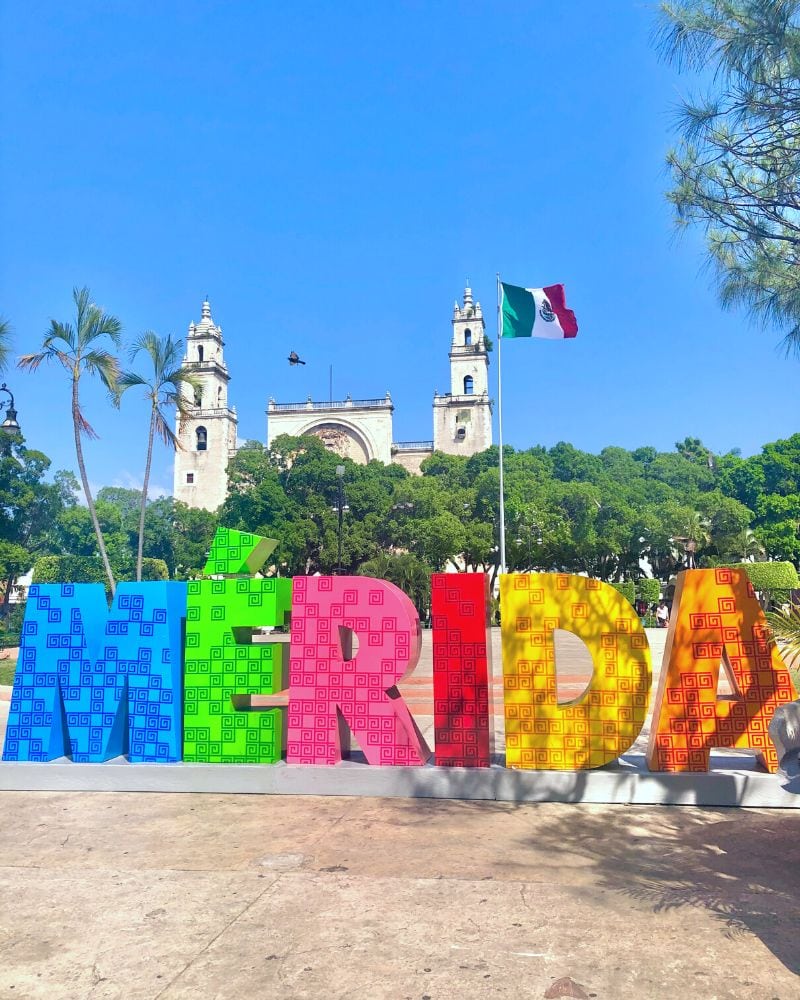
Located in the Yucatan Peninsula , one of the safest parts of Mexico, Merida consistently ranks as the safest place to travel in Mexico.
In fact, Merida is considered the safest place in Mexico to vacation in the entire peninsula.
It is the capital of Yucatán state, which is one of the Mexico states that seems to never have U.S. State Department travel warnings .
Further still, many say Merida is definitively the safest place to live in Mexico (or one of the safe places to live in Mexico).
As someone who lived in Merida for many years , I know this to be true first-hand.
For years, Merida flew under the tourist radar. However, thanks to great press like what you see below, more travelers began to discover Merida.
- In 2019, CEOWorld Magazine declared it the second safest city on the entire Americas Continent.
- In 2021, CEOWorld Magazine readers also voted Merida #3 on their Best Small Cities in the World list.
- In 2022, Merida was named the #4 Best City in the World by Conde Nast Traveller Magazine readers.
Now, this colorful colonial city is fast becoming a top Mexico travel destination.
There are so many amazing things to do in Merida , which is a great city to explore Mexico’s rich Mayan history and traditions.
⚠️ What are the Crime Rates in Merida Mexico?
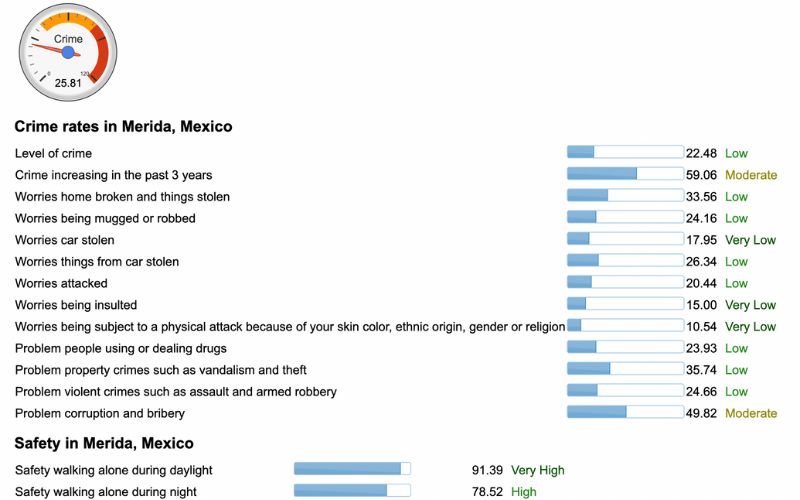
Wondering, What city in Mexico is considered safest with the lowest crime rate? It’s Merida, hands down.
Merida is known as many things, including the Cultural Capital of Yucatan , and the safest Mexican city.
It consistently ranks as both the safest city to visit in Mexico, and safest place for expats to live in Mexico.
As you can see in the infographic above, there’s not much crime in Merida, though of course, crimes of opportunity can happen.
You’ll want to be mindful of your belongings at all times, just as you would anywhere else.
✈️ Ready to book your Merida trip?
Here are some helpful tips and guides to the safest town in Mexico:
- Book the Best Merida Hotels here
- Find the Best Merida Tours here
- For more info, check out Is Merida Mexico Safe for Travelers?
2. Puerto Vallarta — Safest Mexico Beach City
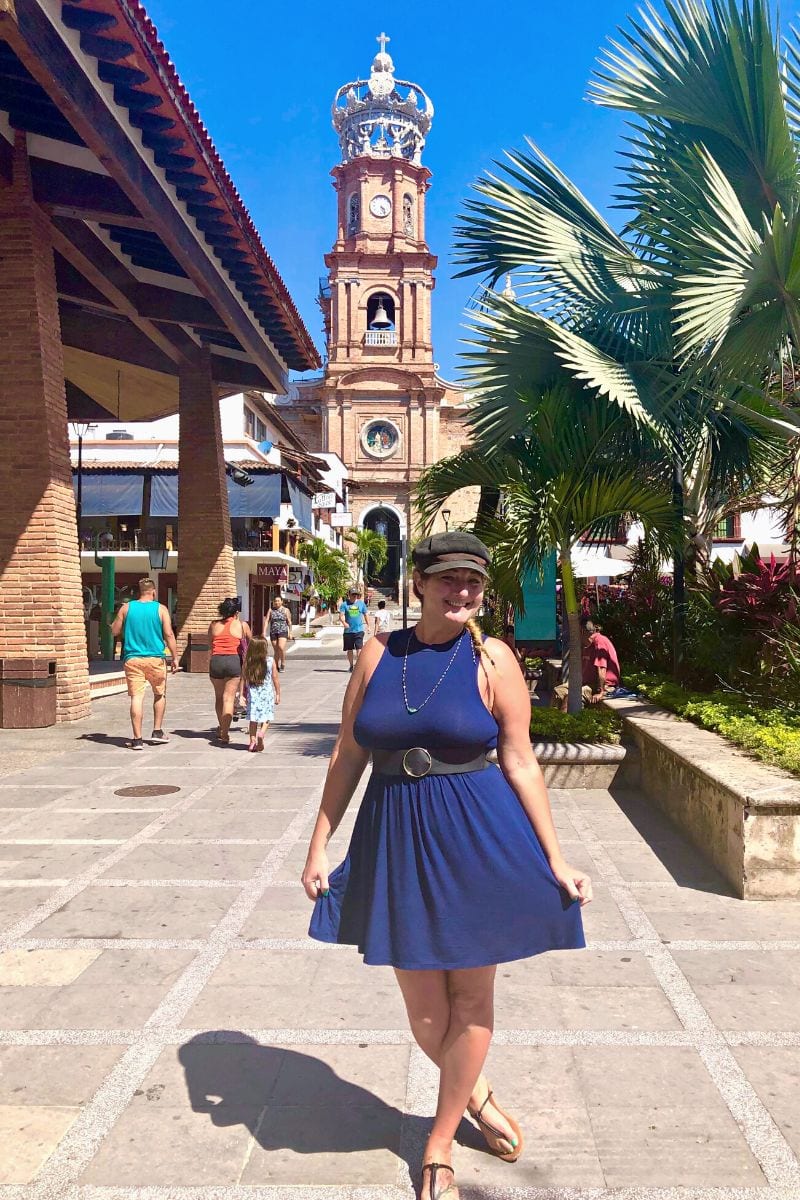
Puerto Vallarta is considered one of the safest resort towns in Mexico, and safest beach towns in Mexico.
While it has these amazing Puerto Vallarta all inclusive resorts , you can of course stay-off resort and best just as safe.
Though it’s one of the best Mexican resort towns , many prefer the colorful homes and local charm in the Puerto Vallarta Zona Romantica, where the locals live.
In fact, when I visit Puerto Vallarta I stay here because it’s so charming 😍
Puerto Vallarta is famous for its beautiful, sandy beaches, and of course, most of the best things to do in Puerto Vallarta involve the beach, the Pacific Ocean, or Banderas Bay.
When planning your Puerto Vallarta itinerary , schedule plenty of beach time.
To catch all the beachy highlights, you can go parasailing , jet skiing, horseback riding on the beach and snorkeling around Los Arcos and get a massage on the beach .
You can spend a good deal of time walking on the best beaches in Puerto Vallarta, like Playa los Muertos, and the famous Malecon (Boardwalk) — but don’t miss the best tacos in Puerto Vallarta at Pancho’s Takos .
⚠️ What are the Crime Rates in Puerto Vallarta Mexico?
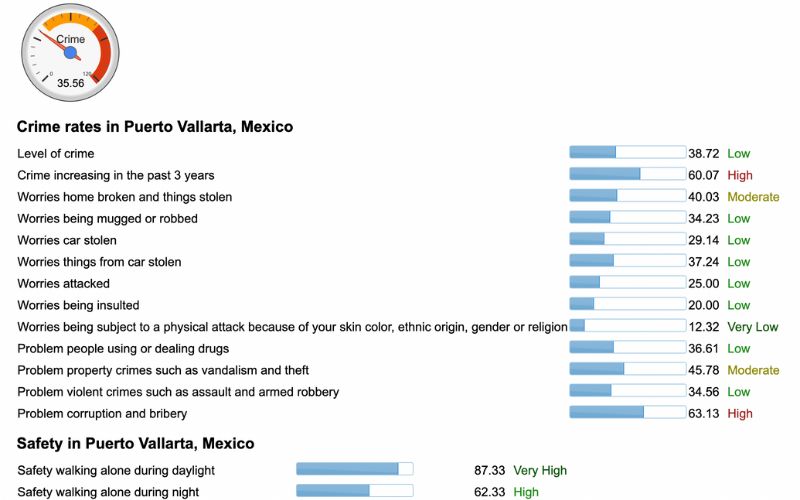
Overall, Puerto Vallarta has very little crime. Of course, this is still a tourist town, so remain vigilant of your belongings at all times.
For such a big city in Mexico though, you have a very low probability of a crime happening to you here.
✈️ Ready to book your Puerto Vallarta trip?
Here are some helpful tips and guides to one of the safest beaches Mexico has:
- Book the Best Puerto Vallarta Hotels here
- Find the Best Puerto Vallarta Tours here
- For more info, check out Renting a Car in Puerto Vallarta: Everything You Need to Know
3. La Paz — Safest Mexico Beach Town
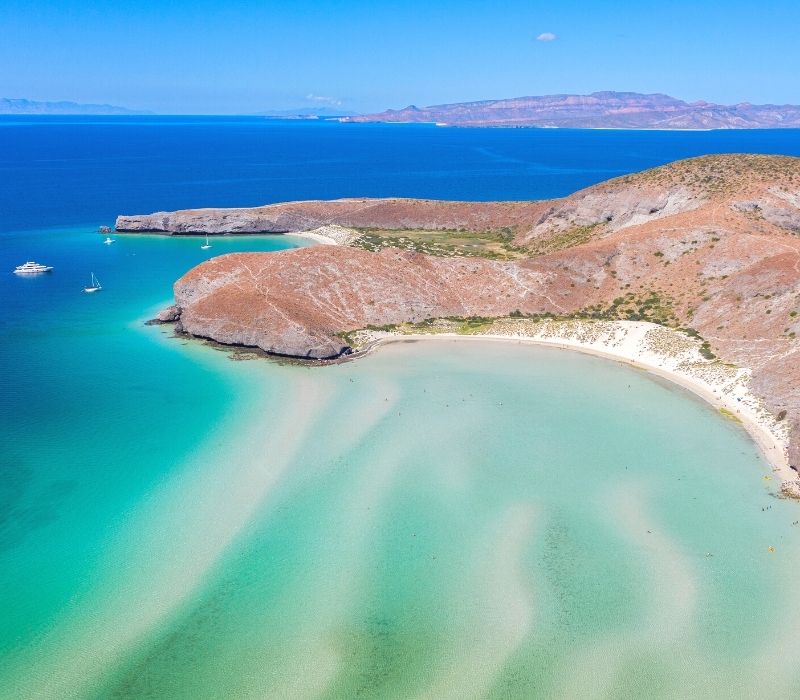
Wondering, What is the safest beach in Mexico ? The up-and-coming town of La Paz Mexico just may be it.
This small town has virtually no violent crime, and isn’t a hub for criminal organizations like the drug cartels.
This a fun little city is in the beautiful state of Baja California Sur, located on Mexico’s west coast. In general, the entire Baja Peninsula is among the safest parts of Mexico; La Paz included.
While the city itself is fairly flat, it’s surrounded by the Sierra de la Laguna mountain range.
Located on the Gulf of California, La Paz is one of the best coastal cities in Mexico, with stunning views from both the beaches and the parts in the mountains at a higher elevation.
Hands down, the best thing to do is to check out one of the best beaches near La Paz .
Balandra Beach is the most popular by far, and in fact, is known as one of the best beaches in Mexico because of its calm, blue waters and photogenic appeal.
However, Tecolote Beach, located a few miles down the road, gives Playa Balandra a run for its money.
Similarly, so does Isla Espiritu Santo Island , which is part of a UNESCO World Heritage Site.
⚠️ What are the crime rates in La Paz Mexico?
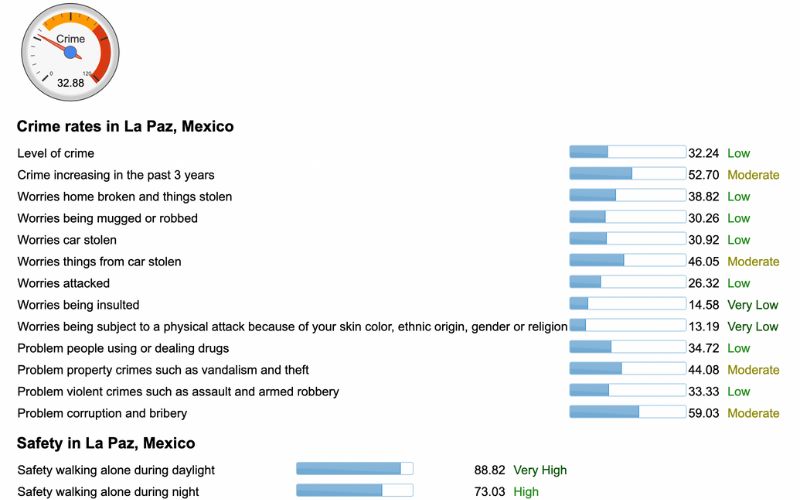
As one of the safest places in Mexico to vacation, La Paz has a low crime rate, and the town and beaches are regularly patrolled by police.
Visitors generally only have to worry about petty theft, which is common in any tourist city.
What makes La Paz special compared to other Mexico beaches in Baja, like Cabo San Lucas , Los Cabos, Todos Santos and San Jose del Cabo , is that it has retained an authentic Mexican cultural feel.
While La Paz is known to be exceptionally safe, in general, Baja California is one of the safest states to visit in Mexico (and best places to live).
✈️ Ready to book your La Paz trip?
Here are some helpful tips and guides to one of the safe beaches in Mexico:
- Book the Best La Paz Hotels here
- Find the Best La Paz Tours here
- For more info, check out Renting a Car in La Paz: What You Need to Know
4. Sayulita
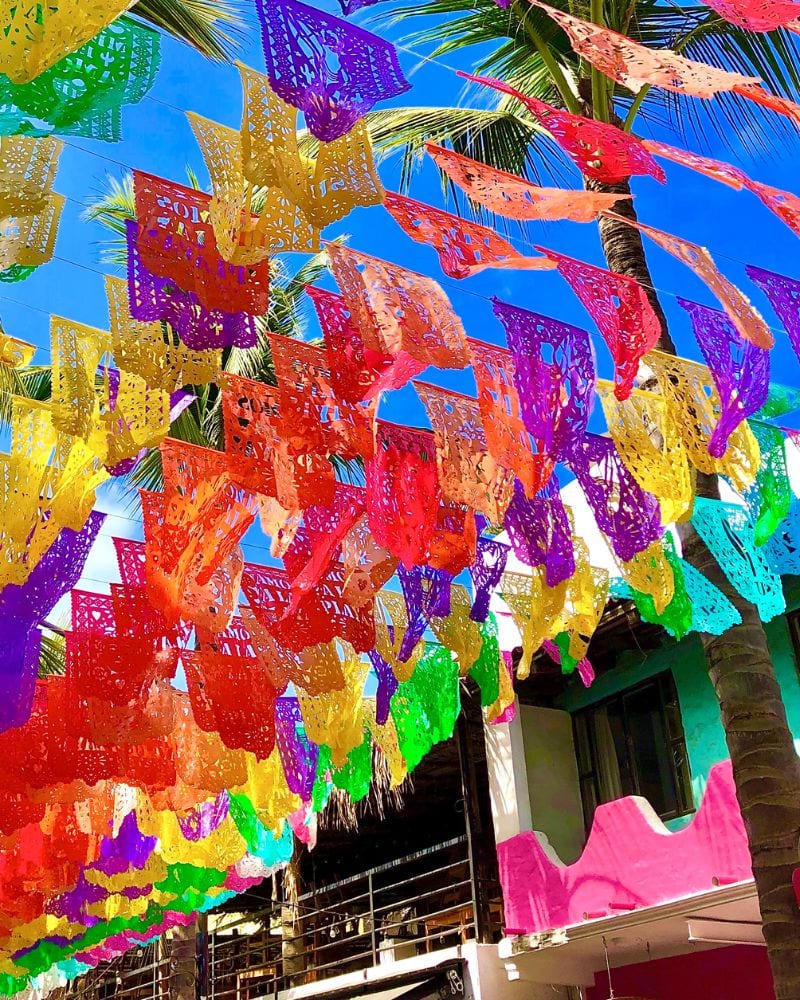
The small town of Sayulita is located in Nayarit state on Mexico’s Pacific Coast. It is just one hour north of Puerto Vallarta by rental car or bus.
Over the years, the beach town of Sayulita transitioned from a sleepy fishing village to a small town beloved by artists, yogis, hippies and surfers.
Today, the Sayulita pueblo magico (magic town) thrives as a trendy hotspot where tourists, surfers and expats all get to enjoy one of the most beautiful Mexican beach towns.
For those lucky enough to call Sayulita home, it is considered one of the safest places in Mexico to live.
The overall vibe is young and laid-back, and the town is colorful and welcoming with its festive papel picado flags hanging from one side of the street to the other.
Sayulita’s quaint streets are full of bars, restaurants, boutique shops and outdoor mercados (markets), creating a fun atmosphere.
Of course, the best things to do in Sayulita involve being on the beach or in the ocean. For surfing in Sayulita, there are waves in all sizes, perfect for all levels.
If you’ve never surfed before, there are plenty of surf lessons in Sayulita , most located on the town’s main beach, Playa Sayulita.
Spiritual travelers, nature lovers and adventure seekers can enjoy beachfront yoga sessions , jungle hikes (like the famous Monkey Mountain hike), horseback rides, zip lines, in addition to the epic surf in Sayulita.
✈️ Ready to book your Sayulita trip?
Here are some helpful tips and guides to one of the friendliest cities in Mexico:
- Book the Best Sayulita Hotels here
- Find the Best Sayulita Tours here
- For more info, check out Is Sayulita Safe for Travelers?
5. San Miguel de Allende
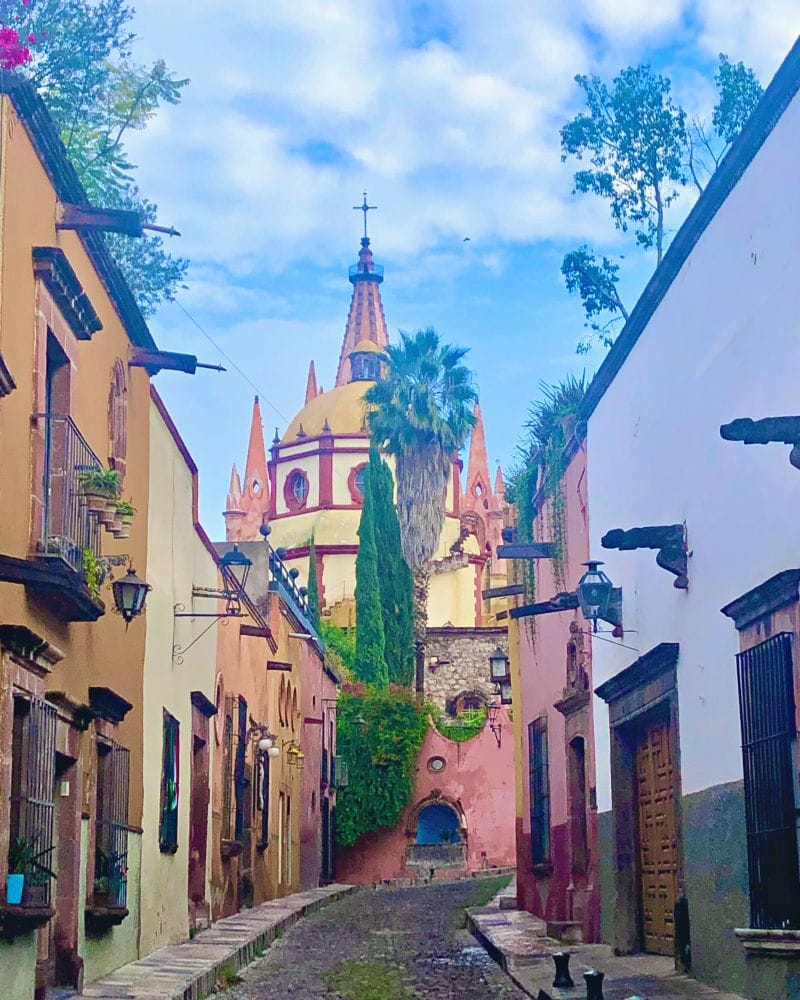
Located in Central Mexico, San Miguel de Allende is a charming city with colorful buildings and cobblestone streets that usually makes any “Best in Mexico” list.
In the last few decades, this Mexico UNESCO World Heritage Site in Guanajuato State has become extremely popular with American retirees.
Those who live there are known to say it’s the safest place to retire in Mexico.
Foodies also flock to San Miguel de Allende, and Top Chef filed there during Season 12.
Among the best restaurants in San Miguel de Allende, don’t miss Aperi led by Omar Henriquez, one of the best Mexican chefs .
With a large population of expats, and English widely spoken, it’s one of the easiest places in Mexico for beginner travelers since you can get by without speaking Spanish.
However, don’t pass up the chance to immerse yourself in Mexican culture, visiting local markets, shopping for handmade crafts and exploring the colorful back streets and alleyways.
Beautiful San Miguel is one of the prettiest cities in Mexico, so make sure your phone camera (or regular camera ) is fully charged!
The best way to experience it all is to just take some leisurely strolls around town.
While walking, don’t miss the Biblioteca Pública (San Miguel de Allende Library), Mercado de Artesanias (Artisan Market), and Parroquia de San Miguel Arcángel , which is the famous San Miguel de Allende church.
There is no airport in San Miguel de Allende, and most people will travel there via Mexico City.
It is easy to get to San Miguel de Allende from Mexico City by rental car or bus, as it’s only about a four hour drive.
You can also arrive by bus from other cities in Mexico, or fly into Guanajuato International Airport (code: BJX).
BJX Guanajuato Airport is the closest airport to San Miguel de Allende. It is located near Guanajuato City , and about 1.5 hours from San Miguel de Allende by car.
✈️ Ready to book your San Miguel de Allende trip?
Here are some helpful tips and guides to one of the safest Mexico destinations:
- Book the Best San Miguel de Allende Hotels here
- Find the Best San Miguel de Allende Tours here
6. Huatulco
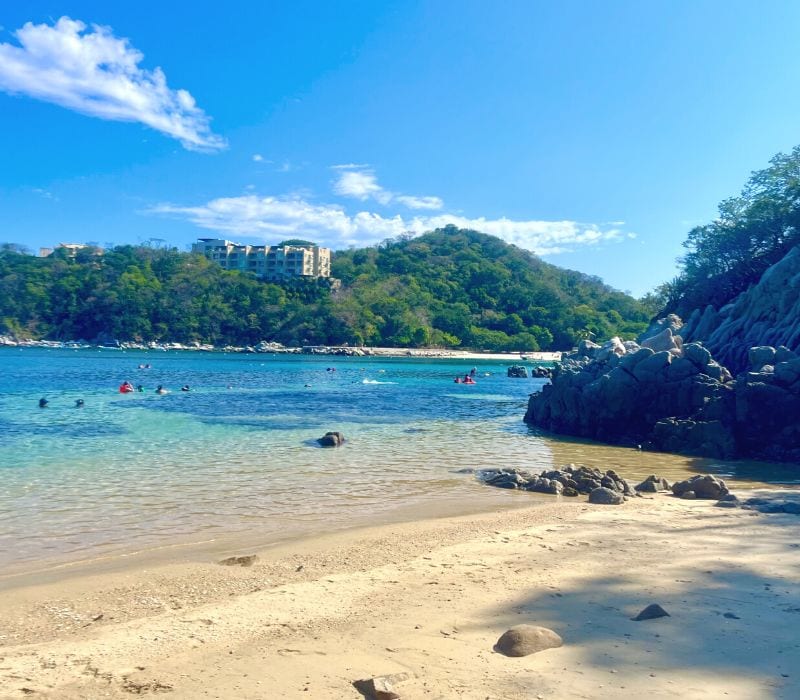
Bahías de Huatulco , which means Bays of Huatulco, is located in the state of Oaxaca on the southern coast of Mexico. It sits on the Pacific Ocean.
Usually just called Huatulco, the town is known as one of the best beach cities in Mexico . It has an astounding nine bays and 36 beaches to explore.
The best things to do in Huatulco involve being in and around the water.
Popular activities at the beaches include swimming, snorkeling and diving, as well as just laying around and watching the area’s epic sunsets at the many beaches in Huatulco .
Those looking for a little adventure can book a rafting trip on the Copalita River or swim in the Copalitilla Waterfalls, which is one of the most popular Huatulco tours .
Huatulco National Park is also a popular place to visit.
One of the largest protected areas in Mexico, Huatulco National Park spans 29,400 acres (11,890 hectares) of land and water space.
The park is located just a few minutes west of La Crucecita (AKA Downtown Huatulco), and is the perfect place for hiking, nature walks, snorkeling, and to rent a bike or ATV.
Wondering, Is Huatulco Mexico safe? or even, What are the safest cities in Mexico for American expats? Huatulco certainly ranks high atop that list.
Not only is it safe, but there’s great weather and plenty of Huatulco things to do , especially for beach lovers and scuba divers.
It has a large expat population from the United States and Canada, and many who come to Huatulco for the winter to escape the cold.
In fact, winter is the Huatulco busy season, and prices increase A LOT — so plan accordingly.
As it’s very safe with great infrastructure and gorgeous beaches, many consider Huatulco one of the best cities in Mexico to live.
With its small town feel, travelers will find Huatulco to be a very safe and welcoming place to visit.
✈️ Want to check it out?
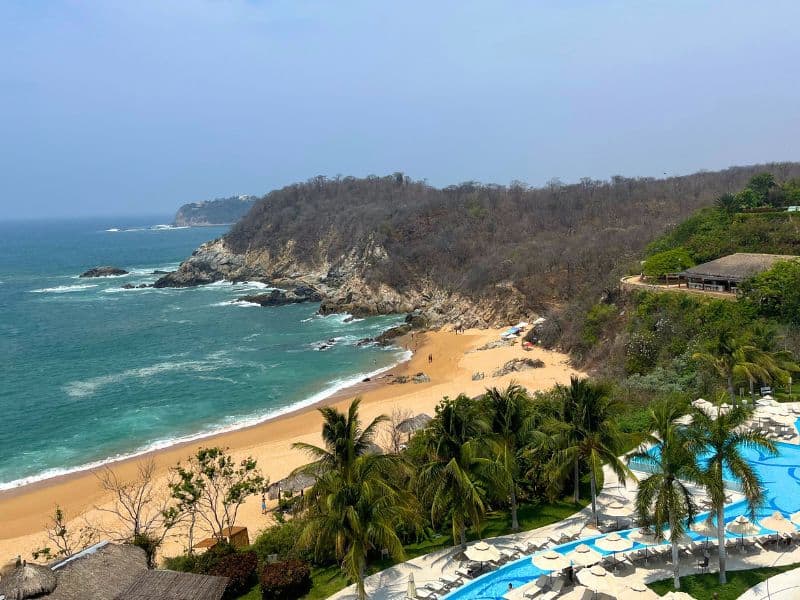
There are a lot of nice Huatulco resorts and hotels that aren’t very expensive, and you can fly directly into the city at Bahías de Huatulco International Airport (code: HUX).
✈️ Ready to book your Huatulco trip
Here are some helpful tips and guides to one of the safe places in Mexico to vacation:
- Book the Best Huatulco Hotels here
- Find the Best Huatulco Tours here
- For more info, check out Oaxaca to Huatulco: 4 Best Transportation Options
7. Puebla de Zaragoza (Puebla City)
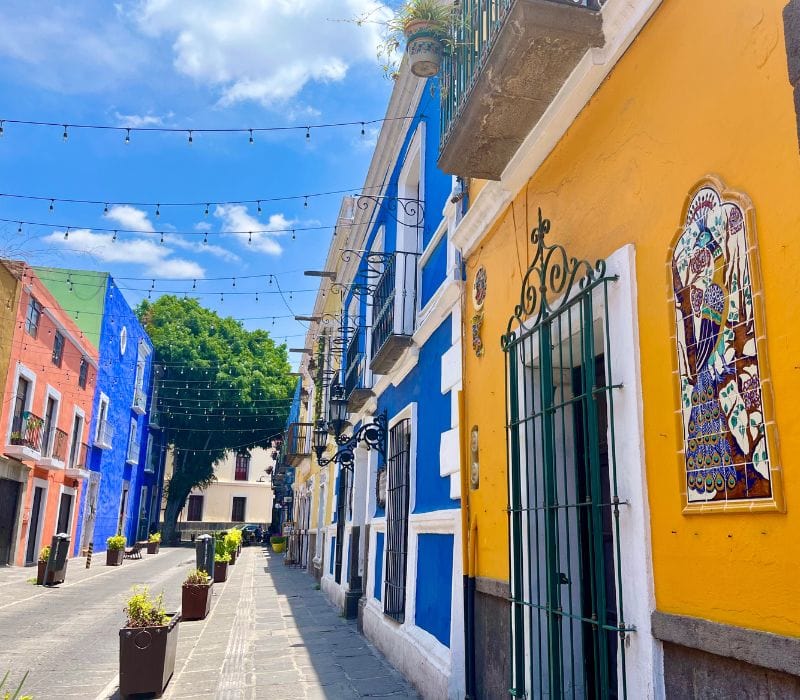
Though it’s one of the biggest cities in Mexico — the fifth largest by population, in fact — Puebla City is among the safest vacation spots in Mexico.
Puebla City is the capital of Puebla State , and a Mexico UNESCO World Heritage Site.
Puebla is one of those great travel destinations, with lots of history, colorful colonial architecture and amazing cuisine. It also has Mexico’s largest Cinco de Mayo celebration.
Just two hours drive from Mexico City, Puebla has a completely different vibe worth exploring.
Though it’s the lesser-visited of the two cities, Puebla is a gorgeous colonial town that you’ll want to add to your Mexico itinerary — even if only as a weekend or day trip from Mexico City .
Start your exploration in the beautiful Zocalo (Main Square), where you’ll spot the impressive Puebla Cathedral.
Another church to visit is Iglesia Santo Domingo; though there are beautiful churches all over Puebla, and in fact, this city is known for its abundance of churches.
Beyond sightseeing, one of the best things to do in Puebla is eat — as it’s one of Mexico’s culinary capitals.
Puebla’s local Poblano cuisine is revered throughout Mexico, and there are plenty of local specialties to try like cemitas (giant sandwiches), tacos arabes, mole poblano , and chile en nogada .
While you might not have heard of it, chile en nogada is the national dish of Mexico!
This unique dish consists of a stuffed poblano pepper that’s smothered in a walnut cream sauce (white), and topped with pomegranate seeds (red) and parsley (green).
The colors in this patriotic dish mimic the colors in the Mexican flag 🇲🇽 and it’s typically only made around Mexican Independence Day on September 16th.
When in Puebla City, don’t miss seeing the neighboring towns of Atlixco Puebla, and Cholula pueblo magico (magic town) — two of the best cities in Puebla, Mexico.
Cholula is not only colorful, historic and charming, it’s also home to the largest pyramid on Earth by volume, the Great Pyramid of Cholula.
✈️ Ready to book your Puebla trip?
Here are some helpful tips and guides to one of the safe vacation places in Mexico:
- Book the Best Puebla Hotels here
- Find the Best Puebla Tours here
8. Isla Holbox Island
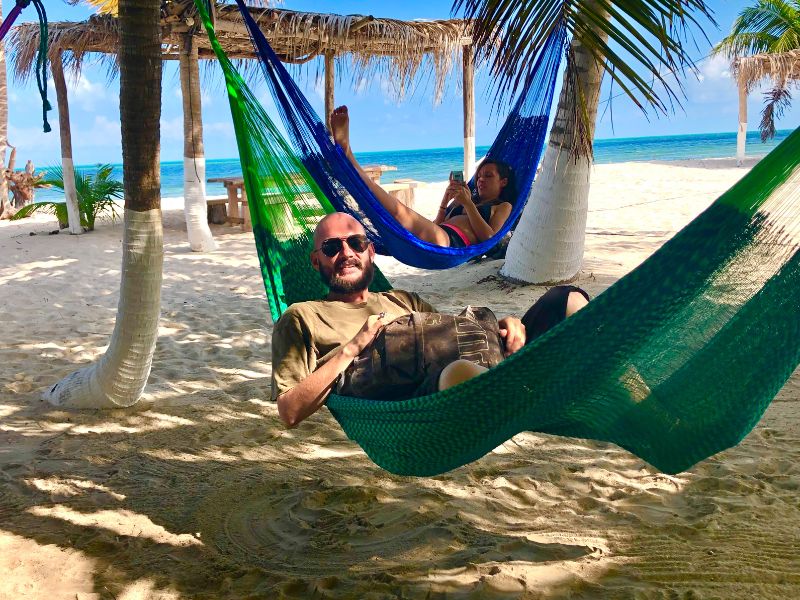
Isla Holbox (pronounced hole-bosh) is located a few hours from Cancun, but feels like it’s a world away from all its hustle and bustle.
Holbox is a Mexican Caribbean island, and a beautiful place to visit for all types of travelers, especially beach and nature lovers, and those looking for serenity.
The laid-back Mexico island is definitely worth a visit.
With its semi-remote, off the beaten path location, it’s not uncommon for Holbox to be labeled as the safest destination in Mexico.
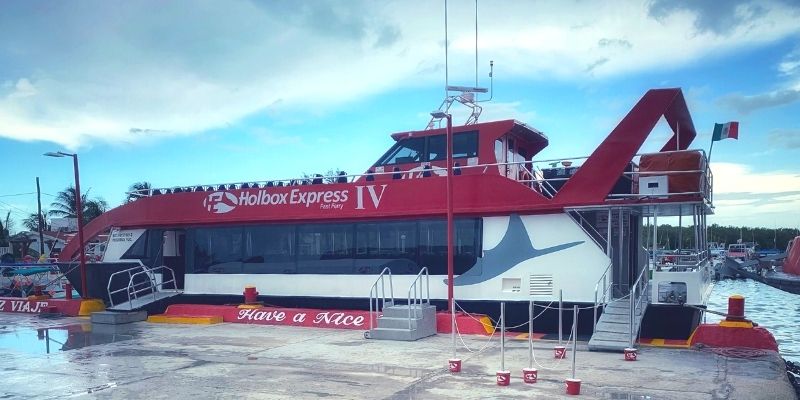
Wondering how to get to Holbox Island? It is only accessible by a ferry boat in Chiquila Mexico, located two hours west of Cancun. Head to this Ultimate Cancun to Holbox Mexico guide for more info.
The island’s roads are “paved” in beach sand, and the best way to get around is by bike or golf cart. In fact, there are no cars allowed on the island.
If you’re traveling by rental car , you will have to leave it overnight in one of the paid lots next to the Chiquila ferry dock .
The lots have security guards, and cost about $7 USD per day per car.
Holbox Island has a small town feel, but also a bit of a lively side at night with a few restaurants and bars that stay open late into the evening.
However, this is not the place to come for all night parties and the same nightlife you’d expect in nearby Cancun , Playa del Carmen or Tulum .
Isla Holbox is among the safest beach cities in Mexico, with a close-knit local community. People in Holbox are helpful and friendly, and you’ll always feel welcomed.
It is a much less touristy place than islands like Cozumel or Isla Mujeres , so safety is basically never an issue in this sleepy town with virtually nonexistent levels of crime.
Holbox is known for its incredible underwater world, and near-virgin beaches.
Among the best things to do in Holbox Island is swim with whale sharks (May 15-September 17), take a boat tour to go snorkeling to see the turtles and manta rays, or just lay in a hammock in the Caribbean Sea.
There’s also a nightly market in the center of town with lots of delicious things to try. Here, you can try all the best Mexican food specialities , like esquites and marquesitas.
If you prefer, you can also dine in the restaurants near the center of town. 🍕 Pro Tip: Be on the lookout for restaurants serving the famous Holbox lobster pizza.
✈️ Ready to book your Holbox Island trip?
Here are some helpful tips and guides to one of the safest places to vacation in Mexico:
- Book the Best Holbox Hotels here
- Find the Best Holbox Tours here
- For more info, check out 27 Best Things to Do in Holbox Island Mexico
9. Mexico City
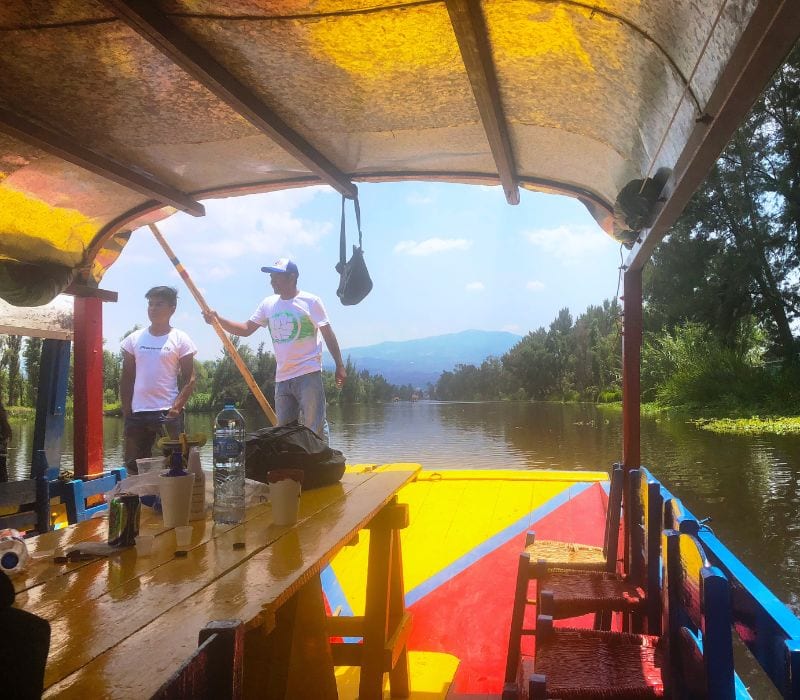
When speaking of the world’s major cities, Mexico City has to be included in every conversation.
However, for many it wouldn’t be the first place you think of when discussing the safest city in Mexico to travel — which is unfortunate!
⚠️ Is Mexico City safe to travel to?
The answer is yes ; for the vast majority of travelers, it is perfectly safe to visit CDMX.
I lived there for one year as a solo woman, and even Mexico City solo travel felt quite safe.
This is a vibrant, cultural wonderland with many amazing things to do in Mexico City , delicious restaurants , plenty of fun day trips , and more.
As with any big city, you do have to be aware of your surroundings and belongings (especially in Mexico City after dark).
👩🎨 Best Mexico City Museums
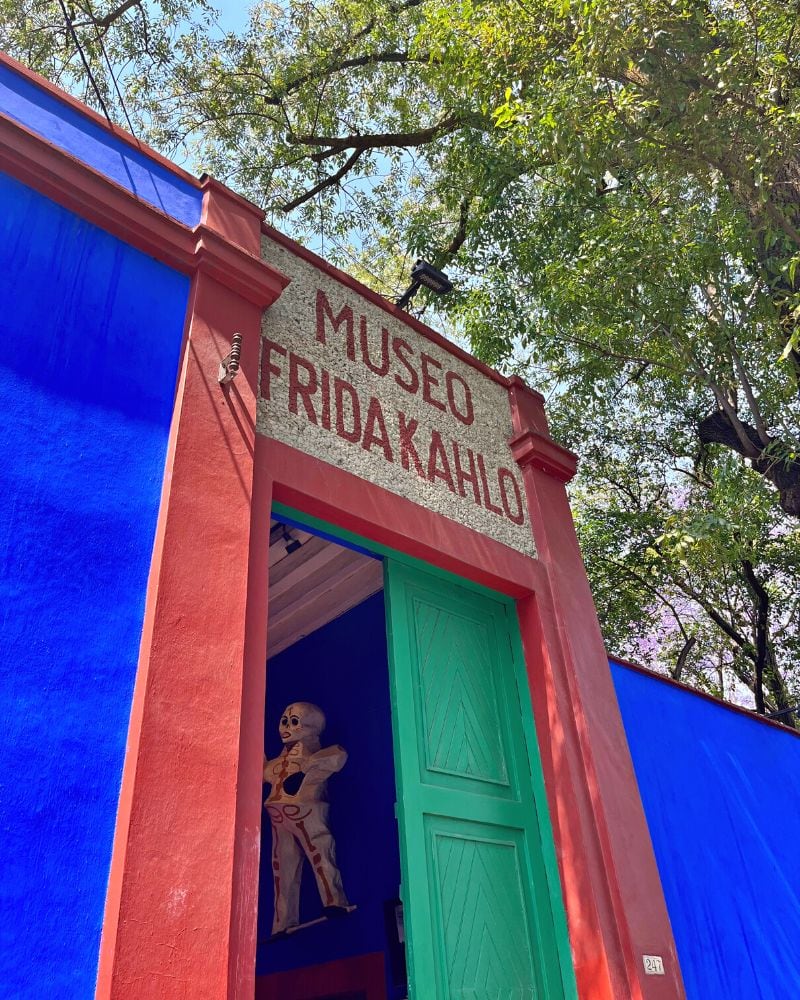
If it’s culture you’re after, then you could spend weeks just visiting the 150 or so museums in Mexico City .
Of the highlights, don’t miss the National Anthropology Museum — widely considered the best Mexico City museum of them all.
It has artifacts from all of the indigenous cultures and civilizations of Mexico, including the magnificent Aztec Sun Stone and a replica of Moctezuma’s headdress.
Located in Bosque de Chapultepec Park , there are other nearby museums to see located near the Anthropology Museum as well. I personally love the Museo Tamayo.
Art lovers will want to check out the Frida Kahlo Museum, located in the vibrant and historic Coyoacan neighborhood .
This is one of the oldest and one of the safest areas in Mexico City, and popular with families, bohemians and college students alike.
Coyoacan is not far from Reforma, arguably the safest place to stay in Mexico City, with plenty of great Mexico City hotels to choose from.
If it’s luxury hotels in Mexico City you’re after, they’re all here along Avenida Reforma.
🇲🇽 Centro Historico: Downtown Mexico City
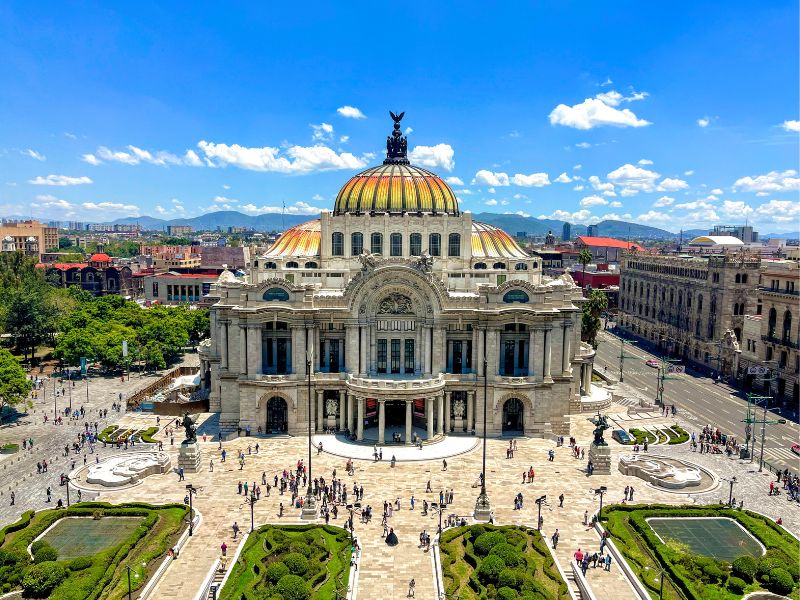
There are plenty of amazing things to do in Centro Historico , including a visit to the Templo Mayor, the main Aztec temple in Mexico.
Foodies will love the city too, and the street food here is among the best on Earth.
It’s hard to eat a bad meal here, as Mexico City tacos are famous for good reason, but the Mexico City restaurants are also amazing.
There are numerous food tours of different neighborhoods, taco tours , market tours, mezcal tastings , and cooking classes too.
Located about one hour outside of the city, don’t miss the famous Teotihuacan Ruins , a Mexico UNESCO Heritage Site.
For a truly unique experience, book one of these Teotihuacan hot air balloon tours to see this ancient site from above.
As some of the closest Mexico City ruins, this is a giant site, and the best way to see it is from above.
✈️ Ready to book your Mexico City trip?
Here are some helpful tips and guides to one of the safest tourist spots in Mexico:
- Book the Best Mexico City Hotels here
- Find the Best Mexico City Tours here
- For more info, check out Altitude Sickness in Mexico City: How to Prevent & Treat It
10. Cozumel Island
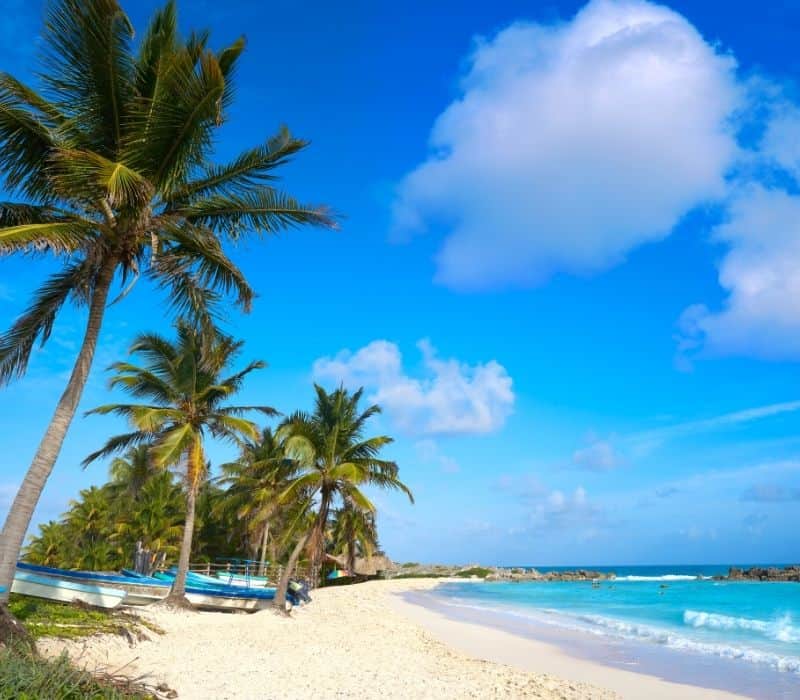
Often called the safest place to visit in Mexico on the Caribbean side, some refer to Cozumel as the Oahu of the Caribbean Sea.
One of the best islands and safest places to go in Mexico, it has a mellow, tropical vibe, the water is always warm, the snorkeling is fantastic, and everyone is so friendly.
Although it’s only a short ferry ride away from Playa del Carmen , it feels like a world away. It’s no wonder why Cozumel is one of the best day trips from Playa del Carmen.
One of the best things to do in Cozumel is snorkel. Part of the Mesoamerican Barrier Reef, it actually has some of the best snorkeling spots in the Caribbean.
The Mesoamerican Barrier Reef (AKA Great Mayan Reef) is also the second biggest reef in the world, after the Great Barrier Reef off the coast of Australia.
You can stop at any beach club and snorkel for free, which isn’t usually the case in popular tourist destinations.
For a beginner-friendly place, head to Money Bar to see the colorful fish, marine life and healthy coral just off-shore.
While visiting Cozumel, make sure to stop at some of the eco parks like Chankanaab Park (located inside the Cozumel National Reef Marine Park) and Punta Sur.
Punta Sur Eco Beach Park, located on the southern part of the island, is a favorite thanks to its lagoons, wildflowers, white sandy beaches, and an enormous lighthouse.
There’s also the San Gervasio Mayan Ruins site to explore. These are some of the coolest ruins in the Mexican Caribbean, and the only ruins in Cozumel Mexico.
With so much to see and do, and such a gorgeous location, it’s no wonder Cozumel is one of the best places to visit in Mexico .
✈️ Ready to book your Cozumel trip?
Here are some helpful tips and guides for traveling to Cozumel Mexico:
- Book the Best Cozumel Hotels here
- Find the Best Cozumel Tours here
- For more info, check out Cancun to Cozumel: How to Get to Cozumel Island
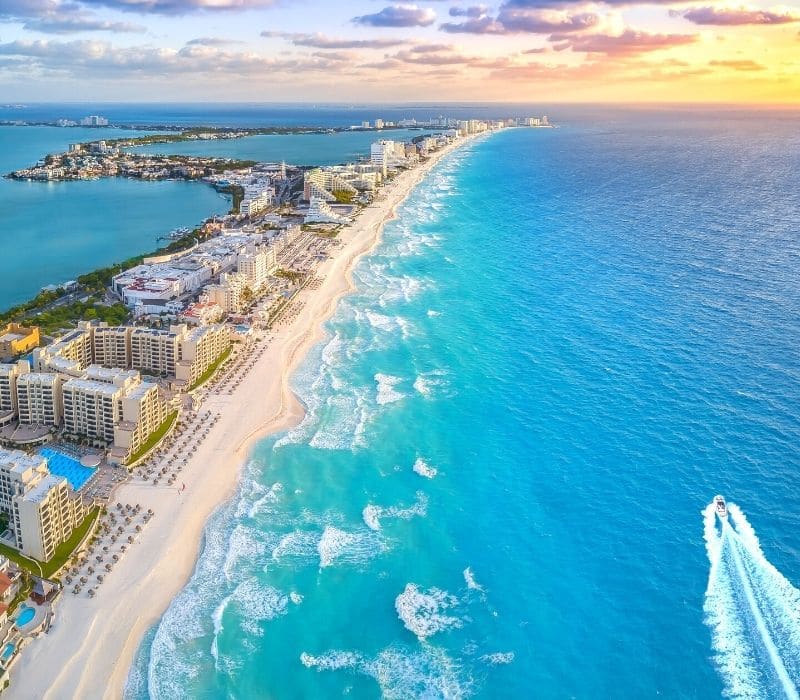
Cancun is among the best vacation cities in Mexico for good reason.
As one of the Top 3 major cities of Mexico for travelers, there’s no shortage of amazing things to see in Cancun.
It also has some of the safest all inclusive resorts in Mexico , which keep visitors returning year after year.
The Cancun Hotel Zone, or Zona Hotelera, is a long strip of land along the Caribbean Sea. It’s easy to navigate, as there’s just one main road that runs from north to south.
Here in the main tourist zone, you’ll find the pristine white-sand Cancun beaches the area is known for.
The Hotel Zone in Cancun is only about 15 minutes from Cancun international Airport.
There’s even an inexpensive bus that offers 24-hour service between the airport and the Hotel Zone.
In general, it’s very safe to get around the city by public transportation or taxi. There is also Uber in Cancun , and other ride-share apps, like DiDi.
As you might have guessed, the best things to do in Cancun involve the beach.
From water sports, diving, snorkeling, relaxing, sunbathing, and even dining and nightlife, it all happens on Cancun beach — and sometimes under its waters, as with the Cancun Underwater Museum (MUSA).
However, there’s other Cancun sites besides the beach, like the Museo Maya de Cancun (Cancun Mayan Museum) and a small Mayan archeological site, El Rey, right in the city.
To see some larger Mayan ruins near Cancun, rent a car or join a group tour to visit Chichen Itza and the Tulum Ruins .
As one of the top Mexico travel destinations and best beach towns in Mexico , Cancun has welcomed visitors for decades.
It has a well-developed travel infrastructure and plenty of restaurants, bars, nightclubs, shops and attractions to suit visitors of all budgets and travel styles.
✈️ Ready to book your Cancun trip?
Here are some helpful tips and guides to one of the top tourist cities in Mexico:
- Book the Best Cancun Hotels here
- Find the Best Cancun Tours here
- For more info, check out Is Cancun Safe to Travel to Right Now?
12. Guadalajara
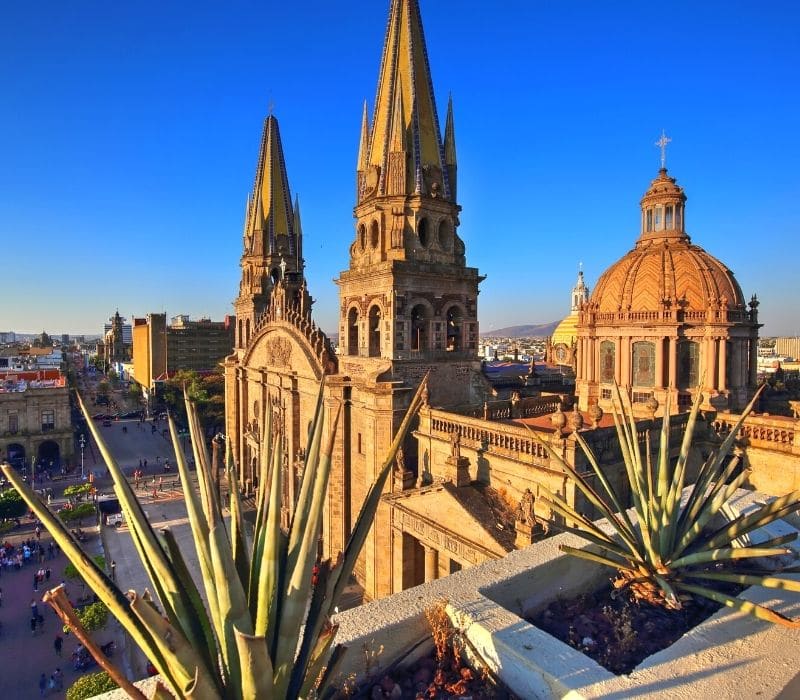
Guadalajara is located in the state of Jalisco, and that state’s capital. It is also Mexico’s second largest city — but you wouldn’t know it by visiting .
This city has a much smaller feel compared to Mexico City, with its colonial historic center and quaint neighborhoods.
The locals are some of the kindest people you will meet, and you can pretty much always expect beautiful sunny days in Guadalajara.
As one of the top cities to visit in Mexico, and the second biggest city in the country, there’s no shortage of things to do in Guadalajara Mexico .
You can easily spend a couple of days visiting Guadalajara . It is a walkable city, and all the main sights are within a short distance of Plaza Guadalajara (Main Plaza).
Take a day to explore Centro Historico (Historic Downtown), including the famous Guadalajara Cathedral and Hospicio Cabanas, a UNESCO World Heritage Site.
After exploring, spend some time shopping for artesanias (artisanal products) in the huge San Juan de Dios Market, or the nearby Tlaquepaque pueblo magico .
🚗 Best Day Trips from Guadalajara
There are so many great things to do near Guadalajara as well, starting with the picturesque suburb of Tlaquepaque (pronounced tlah-kay-pah-kay).
This is one of the Mexico pueblos magicos (magic towns), and located only about 30 minutes from downtown Guadalajara.
Don’t miss out on the amazing food options, and of course, trying some authentic tequila from the nearby town of Tequila, Mexico .
Also among the top cities in Mexico for expats, head to nearby Ajijic pueblo magico (magic town), on the shores of Lake Chapala .
The largest lake in Mexico, there are a few other towns to check out on the lake, like Chapala and Mezcala.
Wherever you go, you’ll notice that both Guadalajara and the towns near Guadalajara have a great relaxed pace, and feel very safe.
✈️ Ready to book your Guadalajara trip?
Here are some helpful tips and guides to one of the best cities in Mexico to visit:
- Book the Best Guadalajara Hotels here
- Find the Best Guadalajara Tours here
- For more info, check out Renting a Car in Guadalajara: What You Need to Know
13. Mazatlan
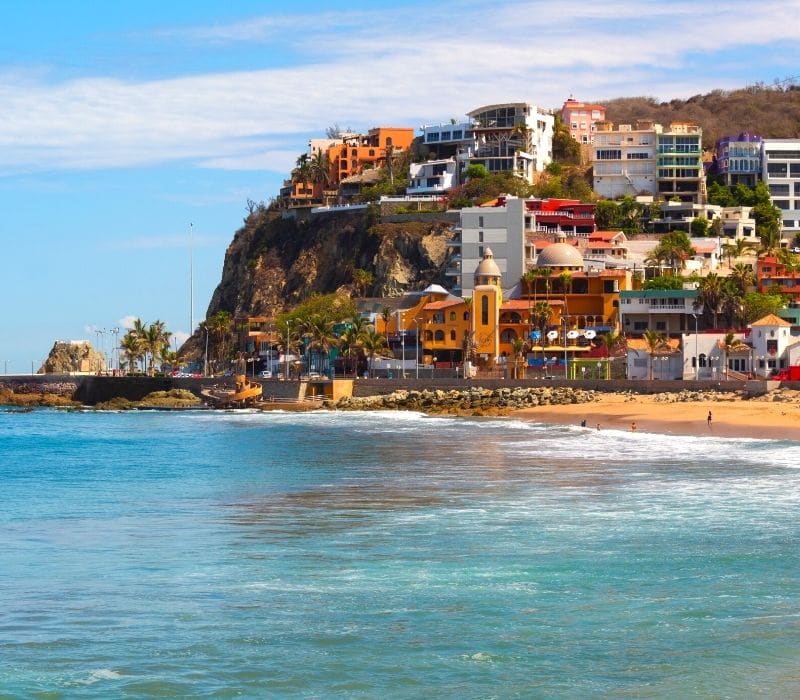
When looking for the safest tourist destinations in Mexico, Mazatlan may not appear at the top of your list — but you have nothing to fear.
However, there are many gorgeous Mazatlan beaches, and in fact, it’s one of the 30 Best Mexican Beach Towns .
Despite the reputation of the state of Sinaloa, where Mazatlan is located, you’ll encounter a safe haven in this city.
If in doubt, stay within the Zona Dorada, or Golden Zone. This is one of the main tourist areas in town.
The Golden Zone is home to some of the best hotels in Mazatlan , as well as great restaurants with live entertainment.
When you arrive in the coastal city of Mazatlan, you’ll meet friendly locals and street vendors who defy Mexican stereotypes .
Mazatlan is unique as far as Mexico beach cities go because you can still experience Mexican culture and Mexico’s uniqueness — whereas some beaches just feel touristy.
Although somewhat off the beaten path for Mexico travel, there are many amazing things to do in Mazatlan.
Start off by exploring Plaza Machado to soak in the historic colonial architecture and beautiful city views. It is located not far from the Golden Zone and Downtown.
During the evening, head to the Mazatlan Malecon (Boardwalk) that overlooks the Pacific Ocean, and take in the sunset.
Thrill-seekers will enjoy everything from zip lining in Mazatlan to doing an ATV tour in the Sierra Madre mountains, and even snorkeling on Deer Island .
Though many might shy away from it because it is in Sinaloa state, Mazatlan is one of the safest cities in Mexico to visit, with beautiful beaches and a unique feel.
✈️ Ready to book your Mazatlan trip?
Here are some helpful tips and guides for Mazatlan, to one of the safest vacation places in Mexico:
- Book the Best Mazatlan Hotels here
- Find the Best Mazatlan Tours here
14. Ensenada

Ensenada, in the state of Baja California, is well known for its beautiful beaches, cruise port, and as the birthplace of Mexico’s beloved fish tacos .
Located less than two hours by car from the U.S. border, many head down to Ensenada from California for a weekend getaway in this Mexico beach town.
Besides Tijuana and Rosarito, it is one of the closest cities in Mexico to get to from the U.S., and one of the safest towns in Mexico.
As Ensenada has remained immune to cartel and drug activity, and is considered safe, remain aware of your surroundings and take standard travel precautions.
If you plan on driving into Mexico from the U.S. when you visit Ensenada, check out the linked article for all the info you need.
The landscape in Ensenada is perfect for wineries, and you’ll be spoiled for choice trying the local wines from nearby Valle de Guadalupe .
This area is known as the “Napa Valley of Mexico.” Besides wine tasting , one of the best things to do in Ensenada is see La Bufadora .
La Bufadora translates to “the blowhole,” and this just so happens to be one of the world’s largest blowholes.
The seafood here is among the freshest you’ll find, so don’t miss the local markets to buy some.
In addition to Baja fish tacos , try some smoked clams — and since you’re in Mexico, wash them down with authentic tequila.
Ensenada is also one of the best places for whale watching in Mexico. This is a treat for visitors who come during the December to May migration season.
Though known as one of the best Mexico beaches , there’s also beautiful nature on land, with lots of nature walks and hikes.
✈️ Ready to book your Ensenada trip?
Here are some helpful tips and guides for where to stay and what to do in Ensenada, Mexico:
- Book the Best Ensenada Hotels here
- Find the Best Ensenada Tours here
15. Bacalar Lake
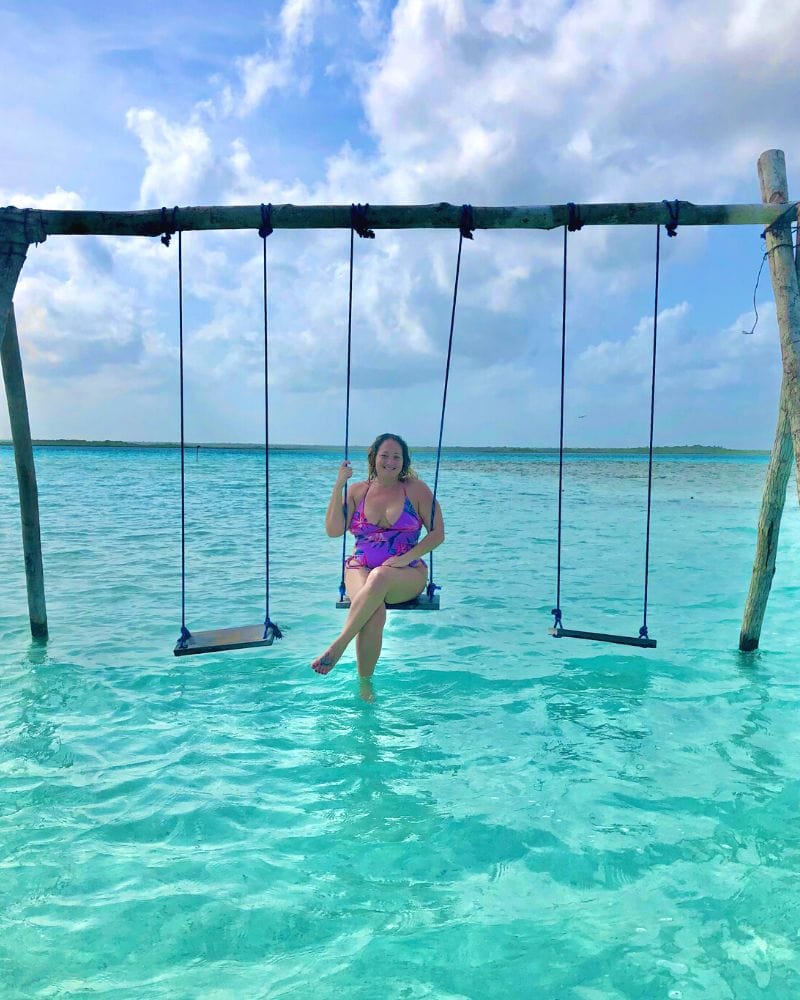
Laguna Bacalar is often mistaken as a Mexico beach — it even has some of the best overwater bungalows in Mexico — though it is, in fact, a lake.
Located in Quintana Roo state, the Bacalar pueblo magico (magic town) is home to the second largest freshwater lake in Mexico, Laguna Bacalar Lagoon.
Gorgeous Lake Bacalar is a Mexico hidden gem located in the Yucatan Peninsula about three hours south of Tulum, and five hours south of Cancun.
In recent years, Bacalar has gained popularity thanks to Instagram, TikTok, YouTube and social media, with influencers flocking to swim in its bright blue waters.
Nicknamed the Maldives of Mexico, the Mayans native to this part of Mexico refer to Bacalar as the Lagoon of Seven Colors.
They say you can see seven shades of blues in the lake. ♻️ Note: Please practice responsible tourism in Mexico and only use reef-safe sunscreen to help keep it blue.
While the lake is the main star in town, Downtown Bacalar is also worth checking out for a bit. There’s historic forts, once used to fend off pirates, and great restaurants.
As one of the best small cities in Mexico, you can rest assured you’ll be safe in Bacalar — both day and night.
It has a true small town feel, where everybody knows everybody, and visitors are welcomed.
The locals are incredibly friendly, and since most operate their own small businesses, hospitality is the name of the game.
For now, there are no big name corporate hotels or chain restaurants in Bacalar, only small businesses. You won’t find the typical tourist T-shirt shops either.
As it’s a bit remote in one of the southernmost parts of Mexico, and takes a few hours to get to, many (sadly) don’t make it down to Bacalar.
I’ve been twice, so I can assure you that Bacalar Lagoon Mexico is both safe and worth visiting.
✈️ Ready to book your Bacalar trip?
Here are some helpful tips and guides for traveling to Bacalar, Mexico:
- Book the Best Bacalar Hotels here
- Find the Best Bacalar Tours here
- For more info, check out Cancun to Bacalar: Best Ways to Get to Bacalar Mexico
16. Puerto Escondido
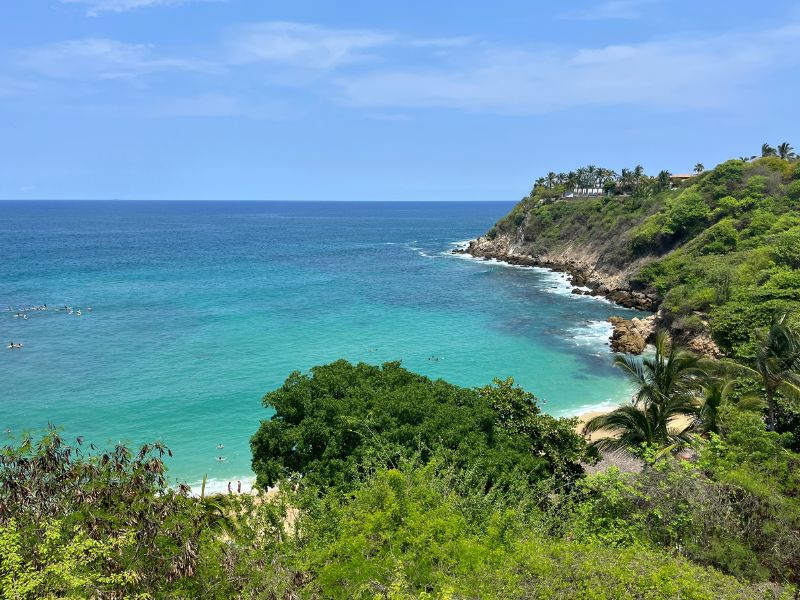
Puerto Escondido is a fishing village turned beach destination on the Pacific coast of Mexico. It is south of Acapulco, and north of Huatulco in Oaxaca State .
Thanks to “Mexican Pipeline,” a famous surf break that draws surfers from around the world, this is a top Mexico surfing destination.
However, natural attractions, tropical beauty and culture, there’s more beyond the beaches in Puerto Escondido — one of the best vacation cities in Mexico!
Though, you’ll of course want to spend some time on the best beaches in Puerto Escondido Mexico — Playa Carrizalillo (great for surfing), Playa Zicatela, Playa Bacocho, Puerto Angelito and Playa Marinero.
It is also a popular Mexico digital nomad destination for those who want to live and surf remotely .
While known as a Mexico surf town, many of the top things to do in Puerto Escondido don’t include surfing.
There’s also seeing the bioluminescence at Manialtepec Lagoon, participating in the baby sea turtle release programs, and trying authentic Oaxaca food at the fantastic Puerto Escondido restaurants.
I’ve lived in and traveled to Puerto Escondido solo for more than a decade, and have always felt very safe.
In fact, many solo female travelers in Mexico find Puerto Escondido to be safe for both travel and living.
While safe, use common sense travel safety precautions like not swimming alone or on beaches with red flags (meaning a strong current).
You can’t swim at all at Playa Zicatela, which has giant waves like the famous Mexican Pipeline.
Also, stay off the streets late at night, don’t drink the water , and use eco-friendly insect repellent to avoid illness from bites.
✈️ Ready to book your Puerto Escondido trip?
Here are some helpful tips and guides for traveling to Puerto Escondido, Mexico:
- Book the Best Puerto Escondido Hotels here
- Find the Best Puerto Escondido Tours here
- For more info, check out Oaxaca to Puerto Escondido: 5 Best Transport Options
17. Isla Mujeres Island
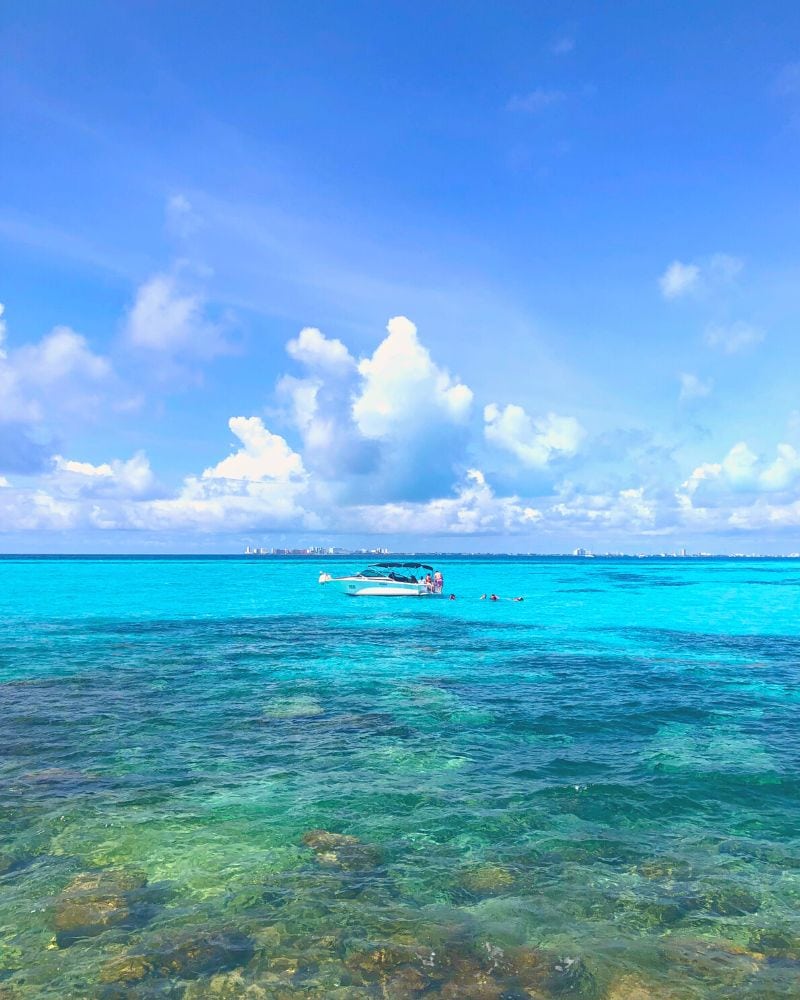
Just 15-20 minutes from the coast of Cancun, and located in the Caribbean Sea, sits the lovely island of Isla Mujeres.
With a small population of friendly, laid-back locals, it just may be the safest place to go in Mexico’s Caribbean.
Isla Mujeres translates to “Island of Women,” as it was a Mayan pilgrimage site where women went to worship Ixchel.
Nowadays, visitors flock to this Mexican Caribbean island because it’s one of the best beach cities Mexico has to offer.
As about 12,000 people live there, you have plenty of restaurants, bars, services and more — and once the daytime crowds leave back to Cancun, you also get tranquility!
Whether you’re traveling on a budget or looking for luxury accommodations, there are great Isla Mujeres resorts and hotels , hostels and guest houses for backpackers doing budget travel in Mexico.
The island itself is only four miles long (6.5 km) and 0.5 miles wide (1 km).
The easiest way to get around is by golf cart, scooter or bicycle. However, the main parts of the island are walkable and there are taxis and a public bus.
Even late at night, activity is thriving, and walking to and from local restaurants and bars is safe and easy.
There are so many great things to do in Isla Mujeres, like snorkeling , fishing, shopping, exploring Mayan temples, or just relaxing at the beaches.
From about May to September, you can take a tour to swim with the whale sharks in Isla Mujeres. 🐋 Check out this video of my Mexico whale shark swim.
Whale sharks are the largest fish in the sea, and this activity can only be done in a few parts of the world.
When visiting, don’t pass up the chance to explore the Ruins of Ixchel . Ixchel was the Mayan goddess of the moon, childbirth and fertility, and the ruins’ namesake.
This is the Mayan archeological site on Isla Mujers at Punta Sur EcoPark, located on the southern tip of the island.
✈️ Ready to book your Isla Mujeres trip?
Here are some helpful tips and guides for traveling to Isla Mujeres, Mexico:
- Book the Best Isla Mujeres Hotels here
- Find the Best Isla Mujeres Tours here
- For more info, check out Whale Sharks Isla Mujeres: Best Whale Shark Tour

Loreto is a pretty town on the west coast in Baja California Sur state.
It is located right on the Sea of Cortez, and has been designated as one of the Mexico pueblos magicos (magic towns), for its charm and historical importance.
The best time of the year to visit Loreto is in winter, because you’ll be able to see the blue whales that migrate to Loreto Bay from about December to March.
Among all the Loreto whale watching tours you can take, the blue whale tour was the highlight of my trip.
In fact, not only did we see gigantic whales multiple times, but our boat was surrounded by a pod of about 100 dolphins flipping and jumping around us. 🐬 It was a magical experience.
Besides whale watching in Loreto, there’s more things to see in Loreto, Mexico.
You can walk around town and enjoy the colonial feel, hike to La Giganta and go scuba diving.
Don’t miss the historic San Javier Mission and the Museo de las Misiones de Baja California (Baja California Missions Museum), and other top Loreto sites.
As Loreto, Mexico is one of the safest places to live in Mexico, you’ll find a large community of both expats and locals who live in harmony.
It is obvious everyone does their part to maintain safety, and that they strive to keep the town clean and safe.
When I visited, I felt safe while walking around and traveling on my own, and it’s definitely one of the best cities in Mexico for solo travel .
In fact, I liked it so much that I’ve traveled to Loreto twice, and the second time I stayed for one full week to enjoy all these best things to do in Loreto .
✈️ Ready to book your Loreto trip?
Here are some helpful tips and guides for traveling to Loreto, Mexico:
- Book the Best Loreto Hotels here
- Find the Best Loreto Tours here
- For more info, check out Renting a Car in Loreto: What You Need to Know

Akumal is located about 30 minutes north of the popular town of Tulum , and about two hours south of Cancun .
Here’s a comprehensive guide on Cancun to Akumal travel showcasing the Best Ways to Get to Akumal Mexico .
It is much more up-and-coming than places like Tulum and Cancun, and has a charming pueblo (small town) feel.
One of the safest small towns in Mexico, you’ll feel secure walking around here, day and night.
A must see attraction is to swim with the turtles in Akumal Bay .
For many Yucatan Peninsula visitors in the Mexico beach town of Akumal, this is what they visit Akumal for.
In recent years, Akumal residents have had to limit the number of visitors to protect the rare sea turtles and the marine life of the area, so now you must book a tour to go.
🐢 Note: I have done the turtle swim, and it was amazing!
Besides the turtles, one of the best things to do in Akumal is visit nearby Yal Ku Lagoon .
This is a protected lagoon where freshwater meets the saltwater of the Caribbean Sea, and the snorkeling is incredible.
The Akumal hotels and resorts , known as some of the safest all-inclusive resorts in Mexico, are in a gated area patrolled by security.
Akumal is a small town, and when combined with this added security measure, you get some of the safest beach resorts in Mexico on your Akumal vacation .
The entire area around Akumal Beach is a pleasant place to shop, dine and sightsee.
It’s easy and safe to ride bicycles or walk the road along the sand to get to different Akumal beaches. In fact, it’s just easy to have a safe trip to Akumal Mexico.
✈️ Ready to book your Akumal trip?
Here are some helpful tips and guides for traveling to Akumal, Mexico:
- Book the Best Akumal Hotels here
- Find the Best Akumal Tours here
- For more info, check out Is Akumal Safe to Travel to Right Now?
20. Oaxaca de Juarez (Oaxaca City)
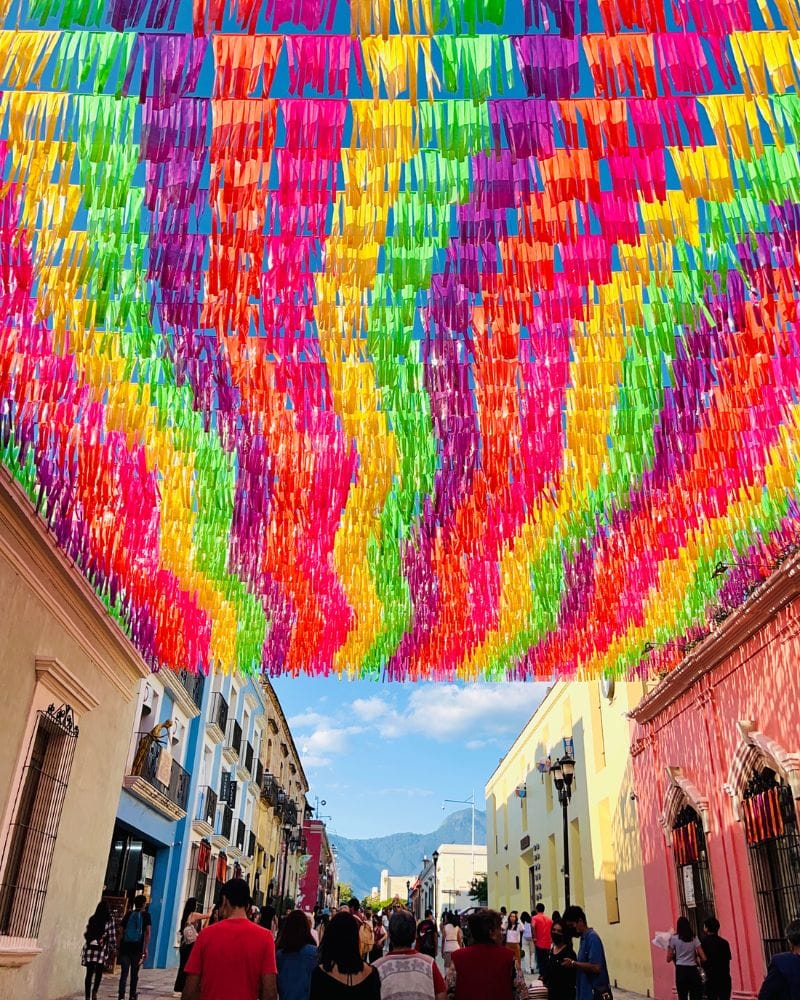
Oaxaca City , the capital of Oaxaca state, is a must-visit in Mexico and all North America.
The vibrant and bustling city is known for its Spanish colonial churches and architecture, lush mountains, mezcal production, and one of the best Day of the Dead celebrations in Mexico .
Besides all that, there are many things to do in Oaxaca and sites to see.
In Centro Historico (City Center), don’t miss the Templo de Santo Domingo de Guzman, Oaxaca Botanical Garden, Oaxaca Cathedral in the Zocalo (Main Square), and the boutique shops, like Rocinante and Juana La Vintage.
Head just outside of Centro Historico to Monte Alban Ruins , a Oaxaca UNESCO World Heritage Site, to see some of the best ruins in Oaxaca .
Hierve el Agua , a petrified waterfall, is among the most beautiful places in Oaxaca State.
This, and the Oaxaca pueblo magico (magic town) of Milta , are two of the best Oaxaca day trips for those renting a car in Oaxaca .
😋 Must Try: Traditional Oaxaca Foods

One added bonus for visitors is the amazing food in Oaxaca . In fact, this city is considered the Foodie Capital of Mexico!
Don’t miss Oaxaca’s delicious moles (pronounced moe-lays), memelas , tamales oaxaqueños (Oaxacan tamales), quesillo (queso Oaxaca cheese), tejate, and more.
There are numerous markets in Oaxaca to visit, but don’t miss Mercado Benito Juarez and Mercado 20 de Noviembre.
Here, you can try all the quintessential Oaxacan foods and drinks, like mole (pronounced moe-lay), tlayuda (tuh-lie-you-dah) and tejate (tay-ha-tay).
In the main Oaxaca mercado, Central de Abastos, you can try the famous memelas made by Doña Vale .
These are very well-known, and have been seen on the Oaxaca episode of the Netflix shows, Street Food: Latin America and Somebody Feed Phil.
✈️ Ready to book your Oaxaca trip?
Here are some helpful tips and guides for traveling to Oaxaca, Mexico:
- Book the Best Oaxaca Hotels here
- Find the Best Oaxaca Tours here
- For more info, check out Is Oaxaca Safe to Travel to Right Now?
21. Cabo San Lucas
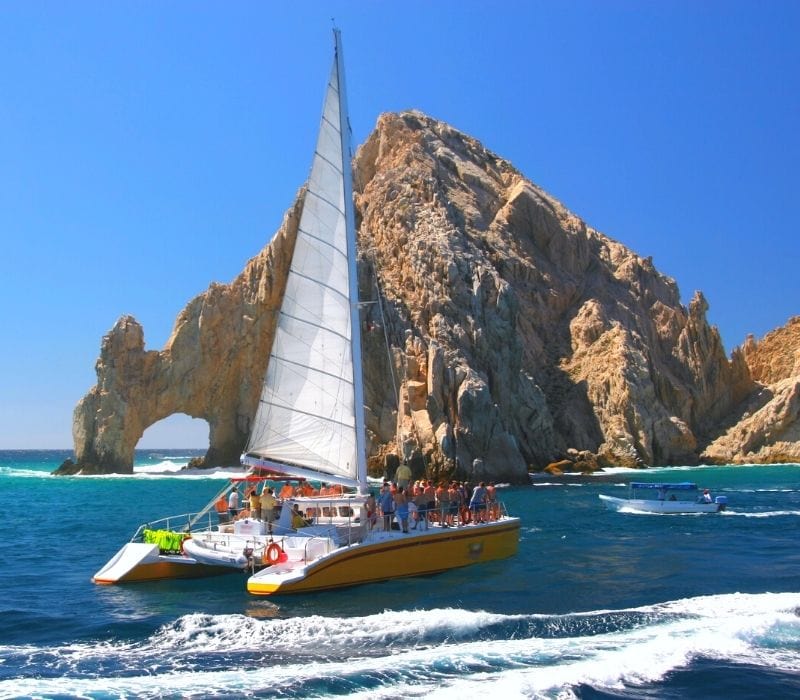
Cabo San Lucas is one of the best Mexico travel destinations and best resort towns in Mexico.
Not only are there so many things to do in Cabo San Lucas , but it’s easy to get there (you’ll fly into Los Cabos Airport) — and also one of the safest places to visit in Mexico.
Whether you’re going with a group, a partner, or doing solo travel in Cabo , it’s easy to spend a week or a weekend in Cabo.
A year-round destination, Cabo sees an astounding 300 days of sunshine annually*, so there’s no official best time to visit Cabo, because it has sunny days all year.
*Some sources say Cabo has 350 days of sunshine ☀️ Regardless of the actual number, know that a trip to Cabo means sun and fun.
At the end of the day, Cabo San Lucas and Los Cabos Mexico are so popular because they have a lot to offer visitors.
Whether you want to snorkel, do a Cabo boat cruise, go fishing in Cabo , ride ATVs in the desert, play golf in Cabo , or just relax on the beach and eat some fresh fish tacos .
✈️ Ready to book your Cabo San Lucas trip?
Here are some helpful tips and guides for traveling to Cabo San Lucas, Mexico:
- Book the Best Cabo San Lucas Hotels here
- Find the Best Cabo San Lucas Tours here
- For more info, check out Is Cabo San Lucas Safe? Top Cabo Travel Safety Tips
22. Playa del Carmen
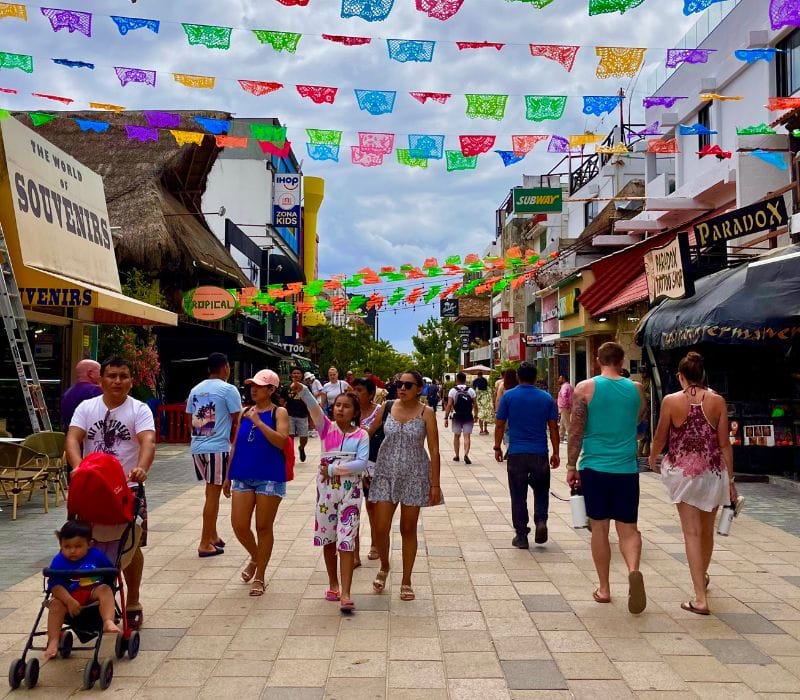
Wondering, Where are the safest places in Mexico to live?
For the throngs of Mexico digital nomads and Mexico expats who live there, many would add Playa del Carmen to the top of that list.
In recent years, Playa (as the locals call it) has become a hot spot for remote workers and retirees thanks to its great infrastructure, fast WiFi, and relatively low cost of living.
If you want to network with other digital nomads in Playa del Carmen, this Facebook group is where you can get updated info on what it’s like to live in Playa del Carmen Mexico.
For those unfamiliar, Playa is located about one hour south of Cancun, within Mexico’s Yucatan Peninsula.
It’s easy to get from Cancun to Playa del Carmen , and very cheap if you take the ADO bus. There’s no airport in Playa, so you’ll have to fly into Cancun Airport.
✈️ Ready to book your Playa del Carmen trip?
Here are some helpful tips and guides for traveling to Playa del Carmen, Mexico:
- Book the Best Playa del Carmen Hotels here
- Find the Best Playa del Carmen Tours here
- For more info, check out Is Playa del Carmen Safe for Tourists?
23. Riviera Maya

Wondering, What’s the safest place in Mexico to vacation with family?
The Riviera Maya is certainly a strong contender for the title, thanks to the family-friendly all-inclusive resorts and countless things to do.
The Riviera Maya is a long stretch of Caribbean coastline on Mexico’s Yucatán Peninsula, located in-between Playa del Carmen and Tulum .
It’s not a city per se, but it is one of the safest Mexico vacation destinations.
You won’t find many Mexico travel guides that don’t describe this area as one of the nicest places in Mexico for a relaxing vacation on the beach.
This relaxing area is centrally-located, so you’re near A LOT of sites. When you arrive you’ll soon see why Riviera Maya is one of the best beach towns Mexico has.
It is home to many of the best resorts in Yucatan — and in fact, many visitors don’t even leave their resorts because they’re so beautiful.
A standout is the Grand Velas Riviera Maya All Inclusive , a 5 Diamond Mexico hotel that’s known as the safest resort in Mexico.
✈️ Ready to book your Riviera Maya trip?
Here are some helpful tips and guides for traveling to Riviera Maya, Mexico:
- Book the Best Riviera Maya Hotels here
- Find the Best Riviera Maya Tours here
- For more info, check out Renting a Car in Riviera Maya: What You Need to Know
24. San Cristobal de las Casas
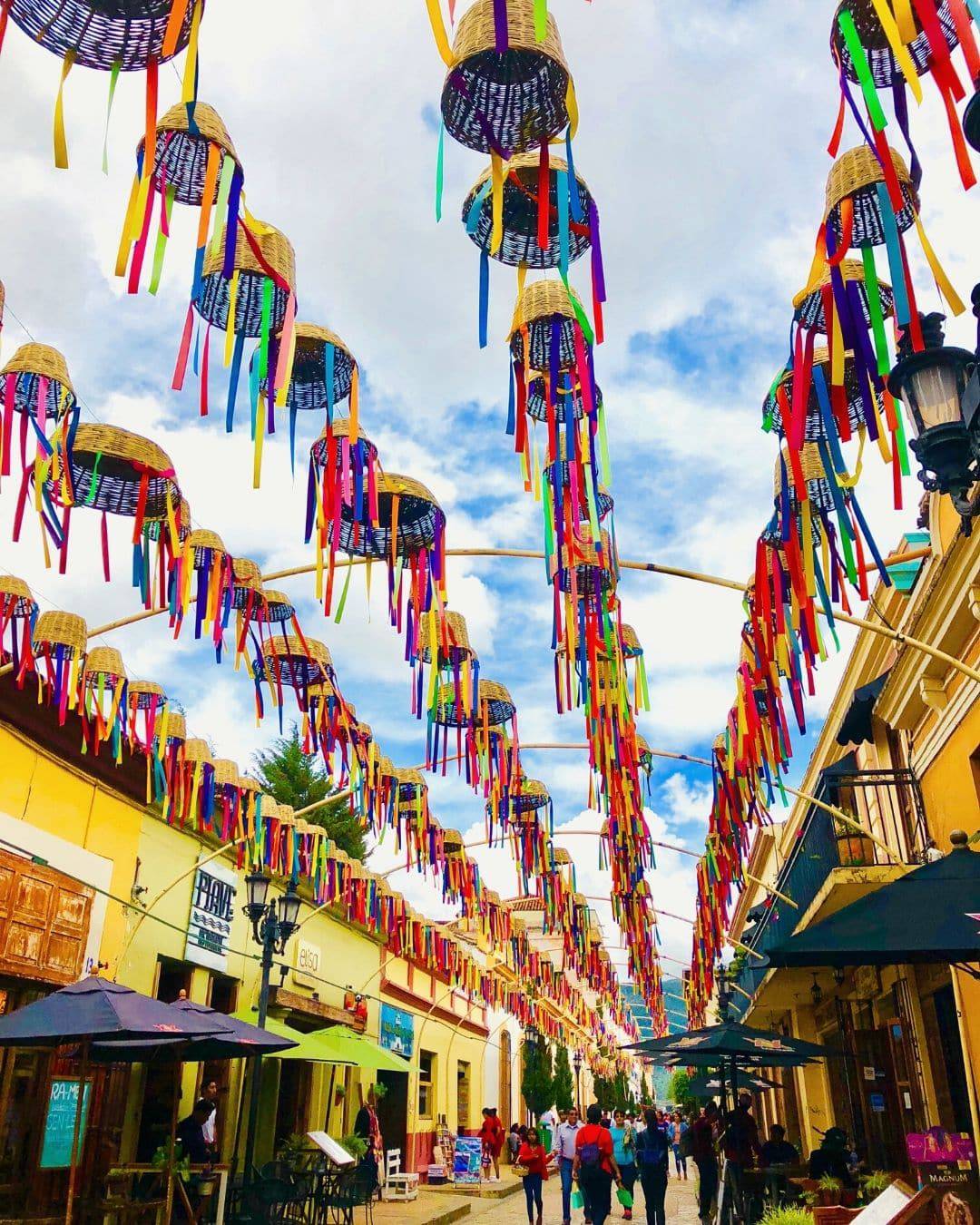
San Cristóbal de las Casas (often just called San Cristóbal) is a beautiful colonial city and pueblo magico in Chiapas State .
It has amazing architecture, culture, stunning nature, and a history where Spanish conquistadors meet indigenous communities.
It is located in southeastern Mexico, right next to Oaxaca State — two Mexican states known to provide a true cultural experience in one of the safest areas of Mexico.
Chiapas is the epicenter of the Zapatista movement and surrounded by indigenous communities that culturally-minded travelers will want to check out.
These include San Juan Chamula and Zinacantan, who’s artisans who regularly travel to San Cristobal to sell their handicrafts at the markets.
In decades past, Chiapas had a reputation of being an unsafe region in Mexico.
However, as is often the case with reputations, they are based on a few events only and do not represent the whole story.
For those who have visited, Chiapas State has some of the nicest cities in Mexico.
As with anywhere in the world, you’ll want to avoid traveling in Chiapas at night and follow general travel safety measures.
However, as a solo female traveler in Mexico , I never felt unsafe in San Cristobal or anywhere in Chiapas.
Some of the best things to do in San Cristobal de las Casas include exploring the local markets, joining the free walking tour, and admiring the colonial architecture in downtown.
There’s some beautiful nature surrounding the city, like Canyon del Sumidero , and one of the best Mayan ruins in Mexico, Palenque , about four hours away.
The Templo de San Juan in the pueblo of San Juan de Chamula is one of the most fascinating examples indigenous religion blended with Catholicism.
This unique place truly is a must see San Cristobal experience, and has a fascinating religious ceremony that visitors come from all over the country (and the world) to see.
✈️ Ready to book your San Cristobal de las Casas trip?
Here are some helpful tips and guides for traveling to San Cristobal, Mexico:
- Book the Best San Cristobal de las Casas Hotels here
- Find the Best San Cristobal de las Casas Tours here
25. Valladolid
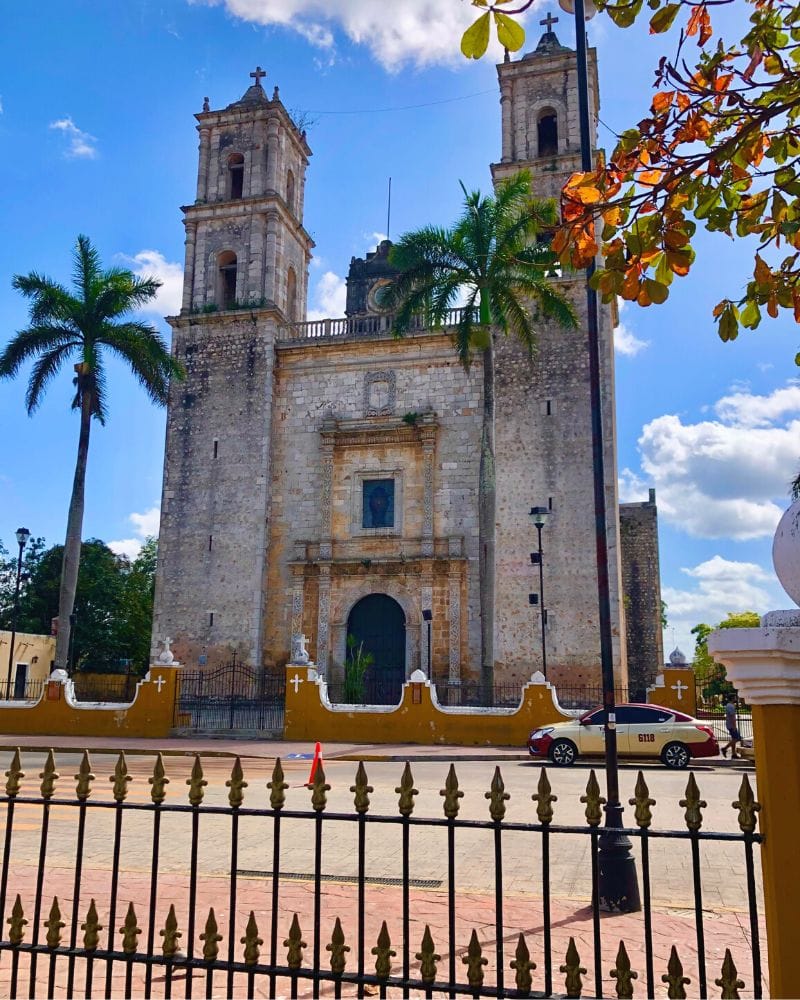
Wondering, Where is the cheapest and safest place to live in Mexico? If you like small towns, Valladolid is a great contender
As one of the least inexpensive of all safe cities in Mexico, petty crime and criminal activity are virtually nonexistent in this safe city.
The charming Valladolid pueblo magico (magic town) , one of the prettiest colonial cities in Mexico, is located in Yucatan State in the Yucatan Peninsula.
It is about two hours from Merida, Mexico, by rental car or bus, and makes for one of the best day trips from Merida .
When visiting, you’ll notice the Old World meets New World feel in Valladolid which has made the town a Mexico must see destination in the Yucatan Peninsula.
As you walk around the city, you’ll fall in love with the colonial style buildings, haciendas that are now home to funky cafes, open air restaurants, and boutique shops offering one-of-a-kind pieces.
Downtown Valladolid boasts numerous things to see, whether you’re a lover of art, history, nature and food.
In fact, you’ll find all the best local mercados (markets) are here, and the best Valladolid restaurants, like La Casona de Valladolid.
One of the safest places to drive in Mexico, you’ll love road trippin’ around the area just as much as staying in town.
Among the best things to see in Valladolid and best things to do near Valladolid, don’t miss these:
✅ Chichen Itza Ruins : One of the New Seven Wonders of the World, these famous Mayan Ruins are located about 30 minutes from Valladolid.
✅ Valladolid Cenotes : Some of the best cenotes in Yucatan are in or near Valladolid, like Cenote Zaci, just a 10 minute walk from downtown, and Cenote Ik Kil , about 10 minutes by car from Chichen Itza .
✅ Calzada de los Frailes : Considered the most beautiful street in Valladolid, the Calle de los Frailes is a great place for photos, shopping and a casual bite to eat.
✅ Casa de los Venados : This private home showcases the country’s largest collection of Mexican folk art, including handcrafted pottery, paintings, colorful textiles and even artistic pieces of furniture.
✈️ Ready to book your Valladolid trip?
Here are some helpful tips and guides for traveling to Valladolid, Mexico:
- Book the Best Valladolid Hotels here
- Find the Best Valladolid Tours here
- For more info, check out Valladolid Mexico: Ultimate Travel Guide for First Timers
26. Monterrey

Wondering, What part of Mexico is safe in the north part of the country?
While there are more places than you might think, one of the obvious answers is Monterrey.
Though big cities in Mexico that border the U.S. in Northern Mexico have a reputation for being unsafe, Monterrey proves otherwise.
If you’re thinking, Is Monterrey Mexico safe? — for the majority of visitors, yes, it is.
It is located in the northern Mexico state of Nuevo Leon, less than three hours by car from the Texas-Mexico border.
🚙 Driving to Mexico? Check out the linked guide for more info.
Monterrey is one of the largest cities in Mexico, but it is also surrounded by breathtaking mountain ranges and natural parks.
Because of this, Monterrey offers a nice blend of big city amenities and tranquil natural areas.
Although not on the traditional Mexico tourism radar for international travelers, Monterrey is popular with national tourism.
It’s a wonderful city to visit for the best of both worlds — beautiful nature and modern infrastructure.
There are so many great things to do in Monterrey , and most of them involve being out in nature.
In fact, one of the most-visited places in Monterrey is Parque Ecologico Chipinque .
The stunning viewpoint from this park overlooks the entire city, and if you’re lucky, you’ll even see black bears, coati, and many different bird species while up there.
There are also beautiful limestone mountains to see in the Parque La Huasteca , which many go to for biking, hiking, and even rappelling.
Also in this park, don’t miss the Grutas de Garcia , a cave with unique stalagmite and stalactite rock formations, which you have to access by cable car.
✈️ Ready to book your Monterrey trip?
Here are some helpful tips and guides to one of the safest Mexican cities in North Mexico:
- Book the Best Monterrey Hotels here
- Find the Best Monterrey Tours here
27. Santiago de Queretaro (Queretaro City)
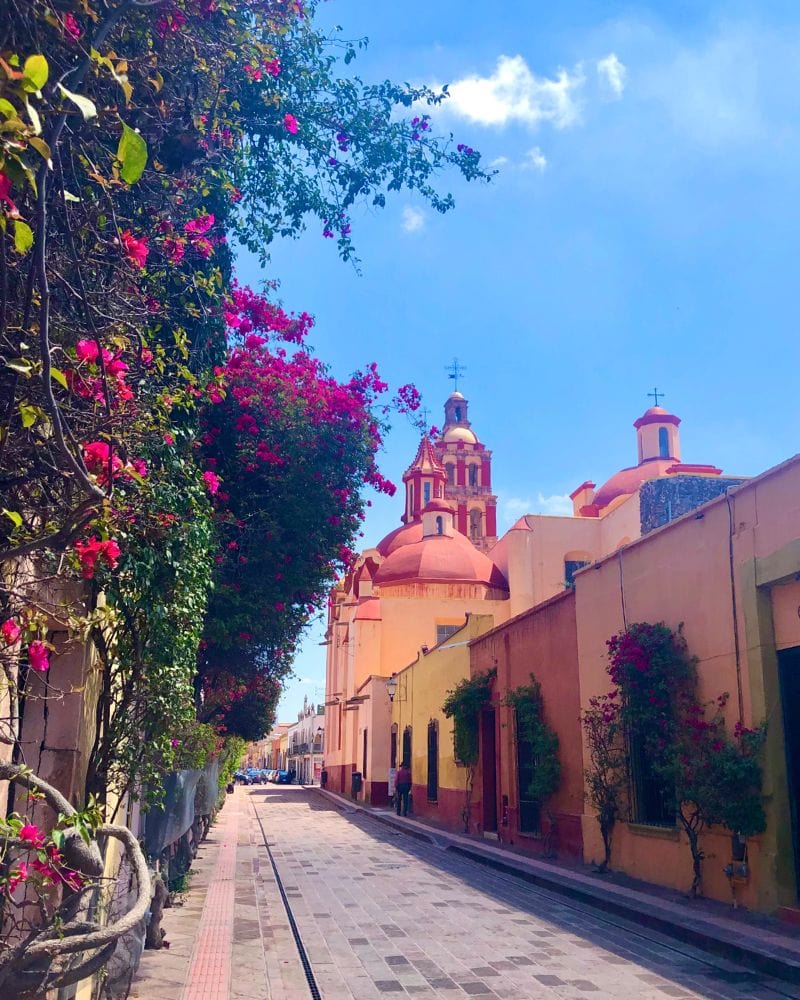
Santiago de Queretaro (usually just called Queretaro) is one of my favorite cities in Mexico.
Though you might not have heard of it, Queretaro is brimming with art and history museums, beautiful colonial buildings and an eclectic culinary scene.
It is also one of the Mexico UNESCO World Heritage Sites, and the 22nd largest city in the country. As with any big city, there are unsafe areas in Queretaro, for sure.
However, if you stick to Centro Historico (Historic Downtown area), which is the most charming part of town anyway and don’t walk alone at night — Queretaro is one of the safest places to travel in Mexico.
One of the best things to do in Queretaro is join a city tour on a historic bus.
On these tours, a knowledgeable guide will tell you all the incredible stories and legends about the city and show you the highlights of Queretaro .
Queretaro City is the capital of Queretaro State, and though it’s the main draw, there’s more to see.
There are also great Queretaro day trips to explore the nearby pueblos magicos (magic towns) of Tequisquiapan and Bernal .
If you have time, explore the spectacular Sierra Gorda , a region renowned for its incredible biodiversity.
There are also the five Franciscan Missions of the Sierra Gorda, one of the two UNESCO World Heritage Sites in Queretaro State .
For me, Queretaro has been one of the safest states in Mexico to visit.
✈️ Ready to book your Queretaro trip?
Here are some helpful tips and guides for traveling to Queretaro, Mexico:
- Book the Best Queretaro Hotels here
- Find the Best Queretaro Tours here
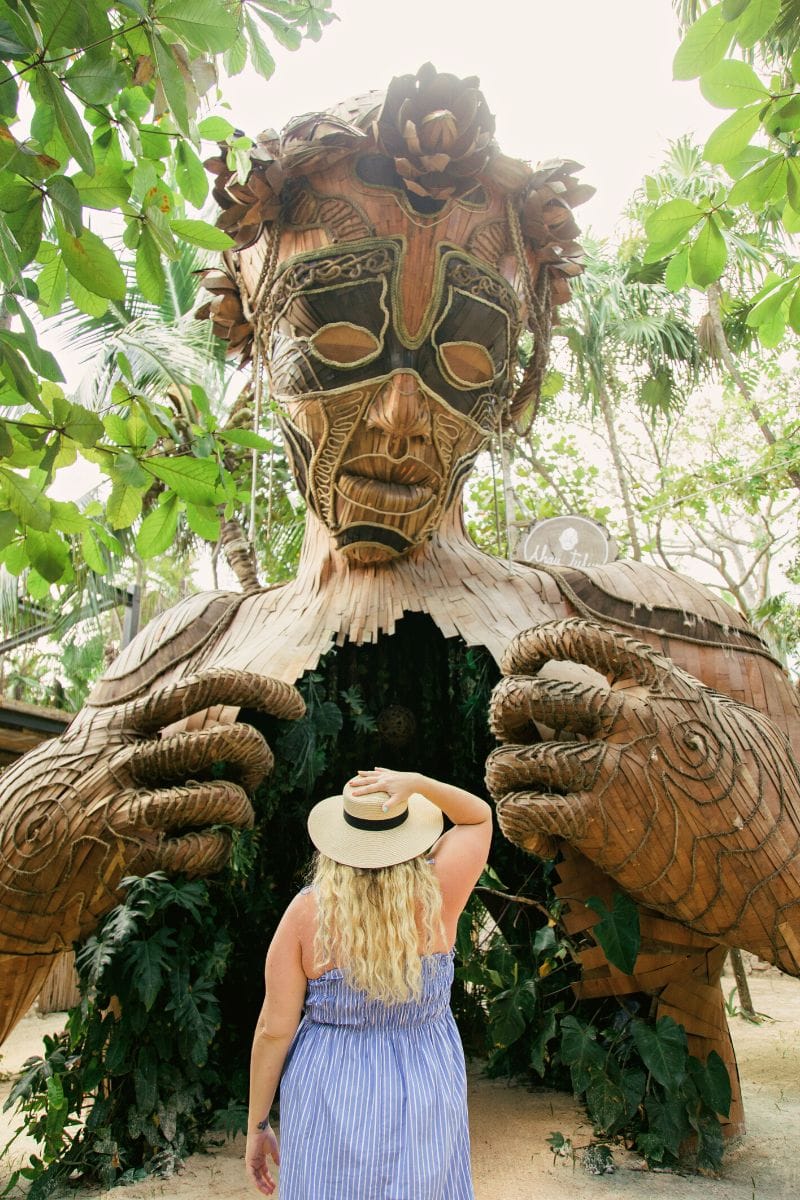
With swaying palm trees leaning over white-sand beaches and azure seas lapping the shore, Tulum is a bohemian beach paradise.
Located on the Caribbean Sea in Quintana Roo state, Tulum is one of the safest beach destinations in Mexico, and a must visit Yucatan pueblo magico (magic town).
Once little more than a small fishing village, in the last decade, Tulum has become one of the most popular cities in Mexico.
This is because Tulum has a lot to offer its visitors, and there are a ton of amazing things to do in Tulum .
There’s everything from oceanfront Tulum beach houses and eco chic Tulum glamping to Tulum treehouse hotels — and restaurant options ranging from Thai to Turkish to tacos , and even fine dining at places like Arca .
🤔 Is Tulum Worth Visiting?
As one of the top places to visit in Mexico , Tulum is worth checking out for those who like fun, food and sun.
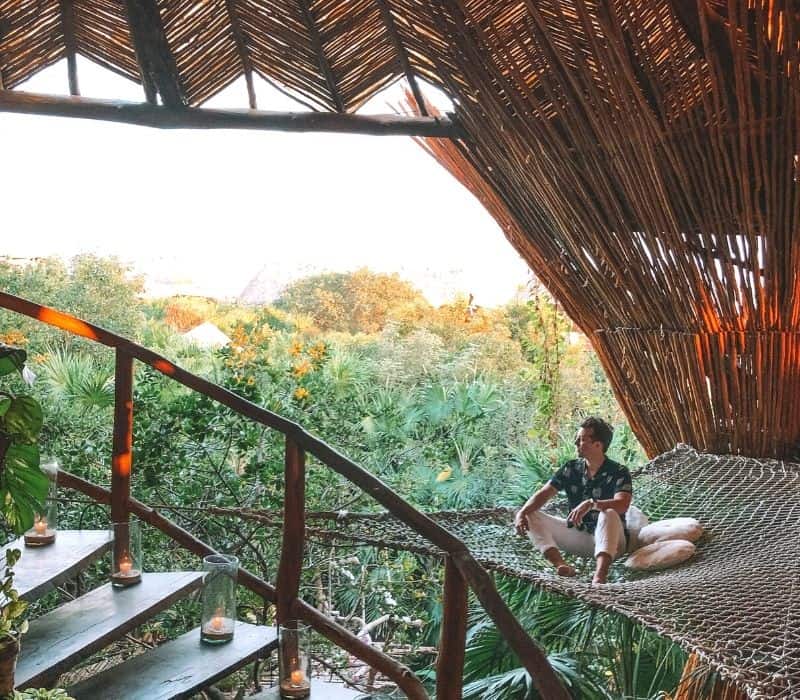
It is also considered among the best party cities in Mexico, so the bars are just as impressive as the restaurants.
As you might imagine, there are A LOT of great things to do in Tulum at night .
During the day, even the Tulum beach clubs have a lively atmosphere, with endless cocktails, top quality service, and amazing esthetic designs.
If lazing on the beach gets too hedonistic for you, visit the Tulum Ruins , one of the most spectacular Mayan Ruins in Mexico .
As the last Mayan city to be built, these ancient ruins offer an unmissable experience in Mexico, and will give you a chance to get a glimpse into authentic Mayan culture .
🪅 Tulum Off the Beaten Path
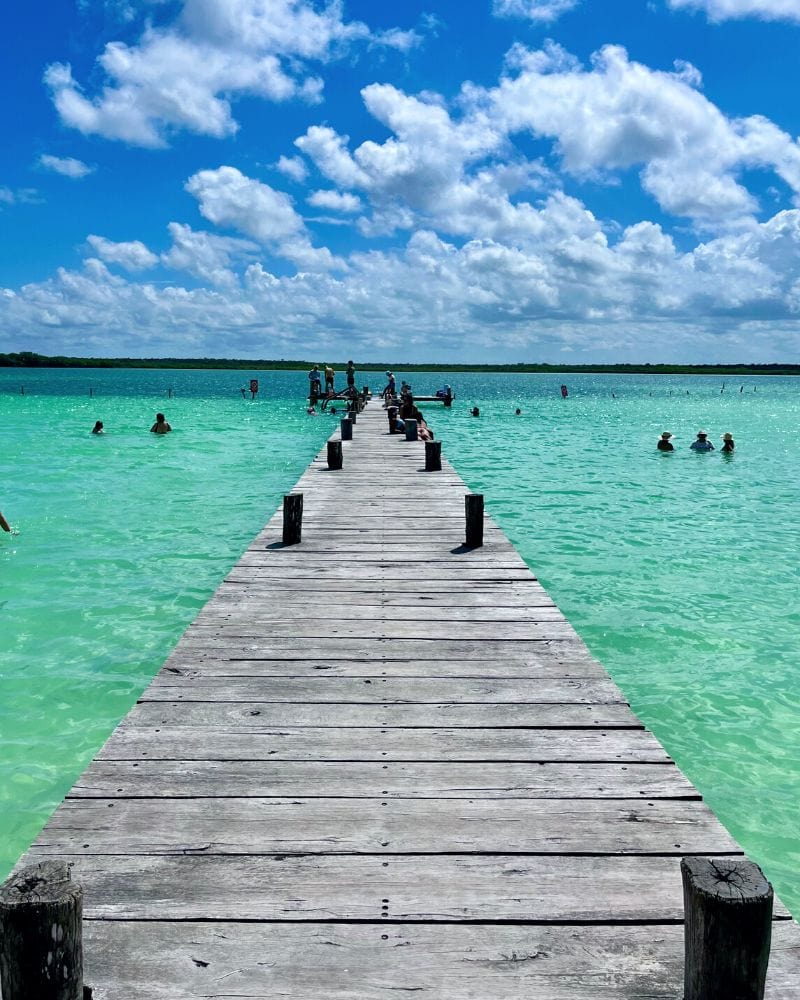
While the beach is the main draw, Tulum visitors will also want to check out the Tulum cenotes , and Tulum Town neighborhood (AKA Downtown Tulum or Tulum Pueblo).
Though it’s not the Tulum you’ve seen on Instagram, TikTok or YouTube, downtown comes alive in the evenings.
Here, you have amazing street food taco shops and awesome bars with live music, like Batey Bar. This fun bar is home to the best mojitos in Tulum!
While Tulum has certainly grown with an influx of tourists eager to enjoy the beautiful beaches, this has also made it one of the safest places to visit in Mexico.
There’s a relaxed, non-threatening vibe and a friendly, busy atmosphere at night, so you never feel alone or secluded — even if you’re doing Tulum solo travel .
With the Tulum Airport now open, it’s easier than ever to visit.
✈️ Ready to book your Tulum trip?
Here are some helpful tips and guides for traveling to Tulum, Mexico:
- Book the Best Tulum Hotels here
- Find the Best Tulum Tours here
- For more info, check out Is Tulum Safe? The Ultimate Guide to Tulum Travel Safety
29. San Jose del Cabo

San José del Cabo is a fantastic little beach town in Mexico, perfect for those who appreciate culture, art and art galleries, sightseeing and of course, beaches.
There are plenty of things to do in San Jose del Cabo, and this little town should be high on your Mexico bucket list.
San Jose, as it’s known by the locals, is easy to get to because the Los Cabo International Airport (code: SJD) is right in town.
You can easily rent a car in Cabo Airport and explore the whole area.
Though it’s overshadowed by nearby Cabo San Lucas, the most famous of all Los Cabos in Mexico — the amazing San Jose del Cabo resorts and the town itself have a completely different vibe.
While Cabo San Lucas is more popular, many of the best resorts in Los Cabo are closer to San Jose del Cabo.
These include two of the best Mexico resorts, Grand Velas los Cabos All Inclusive and Las Ventanas al Paraiso .
✈️ Ready to book your San Jose del Cabo trip?
Here are some helpful tips and guides to one of the best coastal cities in Mexico:
- Book the Best San Jose del Cabo Hotels here
- Find the Best San Jose del Cabo Tours here
- For more info, check out Renting a Car in San Jose del Cabo: What You Need to Know
30. Punta Mita

Punta Mita is an exclusive area with posh resorts in an area called the Riviera Nayarit.
Located in Nayarit state, one of the Mexico Pacific States, what also makes Punta Mita popular is that it’s only about one hour from Puerto Vallarta .
While there are budget options, Punta Mita is all about luxury stays — so this is not really the place for Mexico budget travelers.
If this sounds like your kind of place, pack your bathing suit because Riviera Nayarit has many great beaches that feel private and exclusive.
The Riviera Nayarit beaches have something for everyone — whale watching in winter, calm beaches for swimming and great beaches for surfing.
With everything from inexpensive hostels to some of the best 5 Star resorts in Mexico, like Grand Velas Riviera Nayarit , and places in-between like the Marival Armony Luxury Resort , there’s a place for everyone.
When looking for the best luxury resort in Mexico, look no further than the Grand Velas Riviera Nayarit , one of the AAA 5 Diamond resorts in Mexico.
Besides Grand Velas, there’s also the Four Seasons Punta Mita and St. Regis Punta Mita Resort .
✈️ Ready to book your Punta Mita trip?
Here are some helpful tips and guides to one of the safest resort cities in Mexico:
- Book the Best Punta Mita Hotels here
- Find the Best Punta Mita Tours here
- For more info, check out 25 Best Resort Towns in Mexico
Safest Cities in Mexico Map
Need a visual of all the safest places in Mexico? I got you!
The Mexico Map above shows you where all the safest cities to visit in Mexico are located.
Each city on it is featured in this article, and comes recommended by past visitors who have taken the time to vouch for the safety of that travel destination.
If you’re seeking out the safest cities in the country, these are them!
Safest Cities in Mexico FAQ Guide

What is the safest city in Mexico?
Merida is regarded as the safest Mexico city, and has been for some time.
It has low crime rates in all categories, including robberies, burglaries, vandalism, theft, assault, and drug-related crimes.
safest cities in mexico
Which state in mexico has the lowest crime rate.
Yucatan State and Campeche State — According to U.S. State Department statistics, both Campeche and Yucatan State have the lowest levels of crime.
These states are located next to one another in the Yucatan Peninsula. They’re both considered a Level 1 Zone , and neither have any travel advisories.
What is the safest part of Mexico for tourists?
Yucatan Peninsula — According to the U.S. State Department , much of the Yucatan is a Level 1 Zone with no travel warnings.
In a Level 1 Travel Zone, travelers need only exercise “normal precautions” while visiting this popular region of Mexico.
For some time now, Mexico’s Yucatan Peninsula has been considered the safest area in Mexico.
BONUS: It also has some of the best cities in Mexico for travelers, like Merida, Tulum, Valladolid, Cancun, Isla Holbox, Laguna Bacalar, Playa del Carmen, Akumal, Puerto Morelos, and more.
What city in Mexico has the least crime?
Merida — Given the Merida population of about 1 million, it has the lowest crime rates in Mexico per capita of any major city in the country.
What is the safest place to vacation in Mexico?
Mexico’s Yucatan Peninsula is always a great option.
This part of the country has some of the safest resort towns in Mexico , and so many great things to do.
Are Mexico all-inclusive resorts safer than hotels?
Not necessarily, but many people believe them to be so.

For this reason, you might hear people advise that you “don’t leave your resort in Mexico,” but that would be a shame.
However, if you’re following general travel safety guidelines, you should be just as safe on-resort as off-resort.
These include not walking alone at night, leaving your valuables at home, and staying aware of your surroundings.
There’s also Mexico resort safety considerations you should make to ensure safety.
These include leaving your valuables in the room safe, using good sunscreen , and not drinking too much if your resort has an open bar.
With so many amazing things to do in Mexico , I think it would be a shame to visit Mexico and not leave your resort.
However, you do need to make your own safety your highest priority.
What city in Mexico do most Americans retire to?
Some of the best places in Mexico for retirees include San Miguel de Allende , Puerto Vallarta, Merida , Puebla City and Ajijic on Lake Chapala.
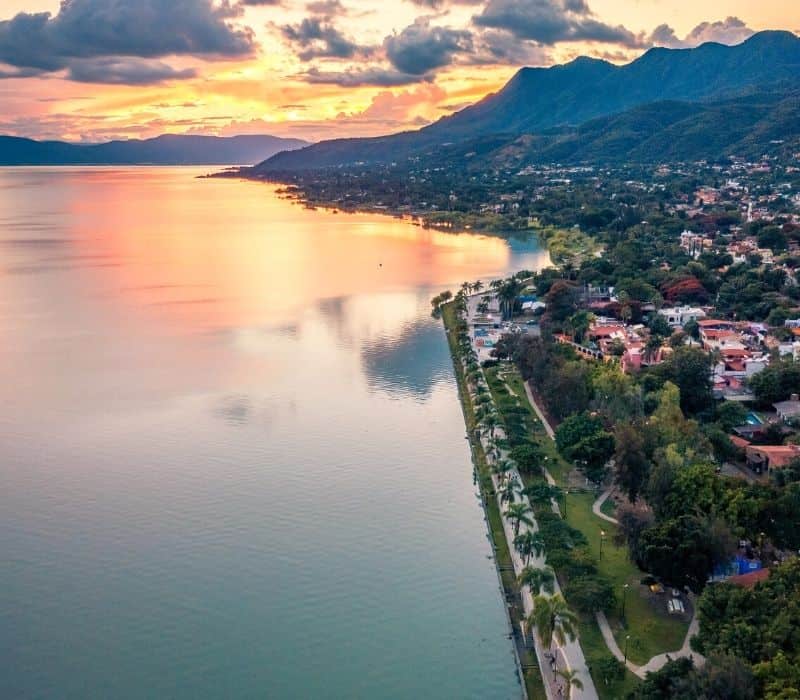
The small town of Ajijic (pronounced ah-he-heek) might not be on everyone’s radar, but it is a great option.
The town sits on Lake Chapala in Jalisco State , and has peaceful vibes. The largest lake in Mexico, Chapala covers an area of 417 square miles (1,080 square km).
Where do most Americans live in Mexico?
There are a few places that are popular for American expats in Mexico, including Ajijic, Los Cabos, Puerto Vallarta, Merida, Playa del Carmen, San Miguel de Allende, and some parts of Mexico City.
What are the 3 safest neighborhoods in Mexico City?
The best neighborhoods in Mexico City for expats are located in the central areas of town, like Roma (including Roma Norte and Roma Sur), La Condesa and Polanco .
Of course, that list is not exhaustive. There are several more safe neighborhoods in Mexico City though.
These include Centro Historico, Coyoacan, Del Valle, Escandon, Reforma, Santa Maria la Ribera, and Zona Rosa, which is the best LGBTQ+ neighborhood in CDMX.
⚠️ Wondering about the unsafe parts of Mexico City?
These include Tepito (located on the border with Centro Historico) and Doctores (located on the border with Roma Norte).
What is the safest city in Mexico for Americans?
Merida — Known as the safest city in Mexico for both locals and visitors, Merida makes a great Mexico travel destination because of its low levels of crime.
Is Mexico safe to travel to right now?
For the vast majority of travelers, yes , it is perfectly safe to visit Mexico.
Of course, you will want to use the same “travel common sense” as you would anywhere else.
While many want a definitive yes/no answer to the question Is Mexico safe for travelers? , there just isn’t one.
That’s because this is a complex question, and the answer is really yes and no .
Yes, Mexico is safe for nearly all travelers; but no, it’s not always safe if you don’t make personal safety your top priority.
As one of the most visited countries in the world, most travelers are safe in Mexico, but you do need to follow common travel safety measures.
In truth, there’s no guarantee of safety anywhere on Earth, but this quote from Carlos Barron, a 25-year FBI veteran, offers some perspective.
Pay extra attention to the phrase: “the numbers game.”
Millions of Americans go to Mexico on vacation every year, so if we play the numbers game, the number of incidents is very small … —Carlos Barron (via Forbes )
There’s no denying bad things happen in Mexico; however, they are isolated incidents .
Though bad things happen every minute of everyday in the U.S. and most European countries, they are written off isolated incidents.
Most people would call it insane to label the entire country as unsafe because of an isolated incident — but this is often done with Mexico 🤷♀️ Why?
🤯 Mexico Saw 66 Million Visitors in 2022
Contrary to often-sensationalized media reports, Mexico gets a bad rap.
However, it’s not totally undeserved, as there are both safe parts of Mexico and unsafe parts of Mexico.
However, American and international travelers still flock to Mexico en masse.
In fact, Mexico is the 7th most visited country in the world, and according to Statista , Mexico was the top travel destination for international travelers in 2021.
So if Mexico was totally unsafe, as many claim, Wouldn’t people just stop going?
As you can see on SECTUR , the Mexican Secretary of Tourism’s site, they most certainly haven’t stopped going.
According to SECTUR, Mexico welcomed an astounding 66 million visitors in 2022 — up 19.3% from 2021.
With such a sinister reputation, and so many people convinced all of Mexico is unsafe for travel, it seems people would want to avoid Mexico at all costs.
However, the numbers show that the exact opposite is true, and that tourists love Mexico now more than ever.
🇲🇽 large numbers of americans are moving to mexico too
It’s not just international tourists who love Mexico that have contributed to the high number of visitors. American expats are also relocating to Mexico in droves .
According to statistics from Mexico’s Migration Policy Unit, the number of Americans who applied for or renewed residency visas in Mexico surged by an astounding 70% between 2019-2022.
What parts of Mexico are safe?
There are many safe places in Mexico, but the State of Yucatán has the lowest crime rate according to the U.S. State Department and Mexico Peace Index .
Yucatan State is famous for Chichen Itza , one of the New Seven Wonders of the World, and the most famous of all Mexico archaeological sites .
There are also other fascinating historical sites, like Uxmal , Ek-Balam, and Mayapan.
Visitors can enjoy these best beaches in Yucatan on the Gulf of Mexico, like Puerto Progreso, and these stunning Yucatan cenotes (natural jungle pools).
No matter where you’re headed in Yucatan, you can enjoy the region without worry.
🇲🇽 Some Additional Safe Parts of Mexico

- Baja California Sur: This southern part of the Baja Peninsula includes Los Cabos, La Paz, Loreto, and Todos Santos. It is known for laid-back vibes, desert landscapes, and whale-watching in winters.
- Mexico’s Pacific Coast: Home to a rugged coastline, friendly locals, and delicious seafood, this area includes Puerto Vallarta, Huatulco and Sayulita.
- Mexico’s Central Highlands and Colonial cities: Rich in history and brimming with colorful colonial architecture, you have San Miguel de Allende, Oaxaca City and Guadalajara.
What are the safest states in Mexico?
The safest Mexico states are Yucatan State and Campeche State , both located in the Yucatan Peninsula.
What are the most dangerous cities in Mexico to avoid?
These include some areas in the states of Colima , Sinaloa , Michoacan , Tamaulipas and Guerrero — though not all parts of each state are dangerous.
The states just mentioned are known to have high levels of drug-related violence, kidnappings and robberies.
If this is your first trip to Mexico, you may want to opt for one of these places to visit in Mexico that are known for safety.
The (sad) reality with travel safety in Mexico is this: There are two Mexicos. As a general rule though, Mexico tourist cities are safe to visit.
One Mexico is a welcoming country with friendly people, world-class beaches , tacos so good you’ll cry, rich history, swimmable cenotes , amazing festivals like Day of the Dead .
The other Mexico is quite frankly, unsafe — and there are some dangerous parts of Mexico with high crime rates that travelers should avoid.
However, if you’re wondering What are dangerous places to avoid traveling in Mexico? , check the U.S. State Department site for any current Mexico travel warnings.
When I’m asked if Mexico is a safe place to go travel on vacation, my response is yes . —Carlos Barron, 25-year FBI veteran (via Forbes )
Just as you’d avoid the unsafe areas in your own city, state or country, so too should you avoid the non-safe places to travel in Mexico.
If you stick to the safe areas of Mexico, you’ll lessen the need for safety concerns.
As tourism is the #1 driving force in Mexico’s economy, the top Mexico travel destinations are safe for visitors.
The Mexican government is invested in keeping them this way, so visitors return year after year.
What are the safest cities in Mexico?
Some of the safest Mexico cities include Merida , Puebla City , Puerto Vallarta and Isla Mujeres .
However, there are MANY more. As a general rule, if you’ve heard of the city, it’s usually safe for visitors.
is it safe to travel to mexico right now?
For a guide on which places are safe at this exact moment, which places to avoid in Mexico, and the most dangerous cities in Mexico — consult the U.S. State Department site for all of the most current Mexico travel advisory info.
Their guide offers up-to-date information, Mexico travel warnings, safety alerts and advisories so it’s a good idea to have a look at their site before making travel plans.
However, keep in mind they evaluate state by state, not city by city, makes more sense for travelers since you’ll likely visit just one small area within a much larger state.
For example, Sinaloa is often considered one of the least safe states in Mexico.
However, the city of Mazatlan in Sinaloa is one of the most-visited and best beaches in Mexico .
This particular city is known as one of the safest places for tourists in Mexico, though it’s located in an “unsafe” state.

What are the safest border crossings in Mexico ?
When driving to Mexico , there are 48 U.S.-Mexico border crossings. The best one to use depends on where you’re coming from, and where you’re traveling to.
The two most-used are the San Ysidro Crossing (California) and El Paso Crossing (Texas). These are considered the safest since they’re so heavily patrolled.
🚙 Coming from California
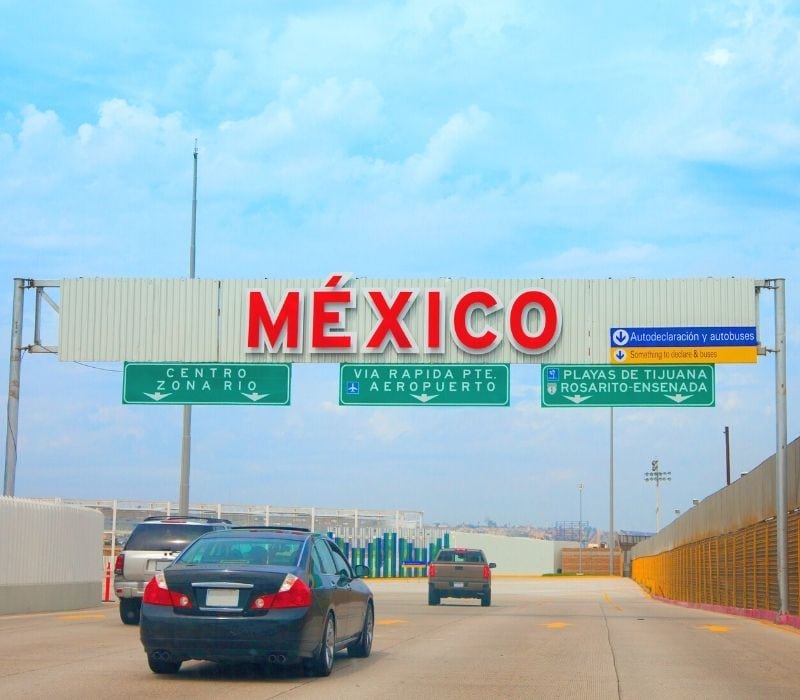
There are six border crossings in California. The most-used is the San Ysidro Crossing (El Chaparral), but there’s also Otay Mesa Crossing not far away.
Otay Mesa often has shorter lines, but they’re both considered safe to use.
🚙 Coming from Texas
There are more than 20 locations when coming by car from Texas to Mexico, including the El Paso Crossing , one of the busiest border crossings in the world.
- El Paso, Texas : Considered one of the safest and most efficient U.S. to Mexico border crossings, and though the lines can get long, they usually move fast.
- Laredo, Texas : This one is widely-used as well, but considered one of the safest crossings due thanks to heavy police presence.
🚙 Coming from Arizona

There are six border crossings in Arizona. The most-used is the Nogales Crossing , which is always well-patrolled by border officials.
When driving to Puerto Peñasco (Rocky Point), use the Lukeville Crossing . Known as “Arizona’s Beach,” this Mexico beach town is the closest beach to Arizona.
5 Quick Safety Tips for Traveling to Mexico
Before we conclude, I wanted to offer some Mexico safety tips. As I have lived in Mexico since 2018, and traveled all over the country, these are the tips I use myself.
No matter where you’re staying in Mexico, please keep these safety precautions front of mind to do your part to protect yourself and your belongings:
- Use Travel Common Sense: First and foremost, don’t take unnecessary risks. Second, trust your instincts and intuition; when someone or something seems sketchy, assume it is.
- Leave Your Valuable at Home: Don’t flaunt your wealth by wearing expensive jewelry and brand-name items, and don’t carry large amounts of cash. These things make you an obvious target for theft.
- If You Must Travel With Them — Keep Your Valuables Secure: Store your passport, money, wedding ring, jewelry and other valuables in your hotel safe or another secure location. You don’t need jewelry to climb Mayan Ruins !
- Research Where You’re Going : Some areas of Mexico are more dangerous than others (like Guerrero, Tamaulipas and many U.S. border towns with high levels of organized crime), so know which areas you need to avoid.
- Stay Aware of Your Surroundings: For your safety, be alert to what’s happening around you, and pay attention for potential dangers.
Final Thoughts: Safest Cities in Mexico to Visit
If you began reading this article wondering What cities are safe in Mexico? or, Is Mexico safe to visit? — hopefully you now see there are plenty of options for safe Mexico destinations, from coast to coast.
In fact, even trying to narrow down the safest part of Mexico, safest city to visit in Mexico, or safest city in Mexico to live in, is impossible because there are many of each.
There is a safe, popular destination in all specific areas of Mexico, as you can see on this map . Need some additional suggestions? Here they are:
- Valle de Guadalupe : The “Napa Valley of Mexico,” and one of the best places in Mexico for travelers who love foodies and wine.
- Mazunte : A popular destination for expats in Southern Mexico, and a gorgeous beach town on the Oaxaca coast.
- Ajijic : One of Mexico’s safest cities in Jalisco state, and located about an hour from Guadalajara
- Valle de Bravo : Widely considered the safest place in Mexico to travel in Estado de Mexico (Mexico State).
- Bucerias : This place consistently ranks as one of the safest cities in Mexico for expats.
- Campeche City : In general, Campeche state is one of the safest states in Mexico, and it’s capital city is the best place to visit in it.
- Morelia : A UNESCO World Heritage Site, Morelia is the top destination in Michoacan state, and considered its safest place.
Given the negative perception of Mexico as a whole, I wanted to compile this article with the voices of other travelers who have personally been to the cities they wrote about.
Hopefully this will help clear up some of what I feel is unwarranted sentiment towards the amazing parts of the country.
Now, there are dangerous parts of Mexico and dangerous places in Mexico; but those are small parts of a big country.
I hope hearing stories from actual travelers helps paint a more real picture because I have found most people who say Mexico is dangerous — have never even been to Mexico 🤷♀️ Go figure!
Mexico Safety Tips: Register for the STEP Program

If you’re from the U.S., make sure you enroll in the FREE STEP Program before your trip. (🇨🇦 Canadians can check out Registration of Canadians Abroad here for a similar program).
The Smart Traveler Enrollment Program, or STEP, allows U.S. citizens traveling to Mexico to document your trip with the nearest U.S. Embassy or Consulate.
After you’ve registered, the U.S. Embassy or Consulate nearest you can contact you in the event of an emergency, including natural disasters, civil unrest, etc.
STEP can also put you in touch with your family and friends back home, in the event of an emergency while abroad.
They can also shed light on general Mexico travel safety tips, if you’re still in doubt.
Mexico Travel Planning Guide
Should i buy mexico travel insurance.
YES — With basic coverage averaging just $5-10 USD per day, enjoy peace of mind with a plan from Travel Insurance Master , one of the biggest names in travel insurance. ( Read more )
Can you drink the water in Mexico?
No — You’ll want to buy this Water-To-Go Bottle , which filters your drinking water so you don’t get sick from drinking water in Mexico.
Also, it helps keep you hydrated while traveling Mexico. ( Read more )
Is it safe to rent a car in Mexico?
Yes — Renting a car in Mexico is one of the best ways to see the country! I always rent with Discover Cars , which checks international companies and local Mexican companies, so you get the best rates. ( Read more )
Will my phone work in Mexico?
Maybe — It depends on your company, so check with your provider. If you don’t have free Mexico service, buy a Telcel SIM Card . As Mexico’s largest carrier, Telcel has the best coverage of any Mexico SIM Cards. ( Read more )
What’s the best way to book my Mexico accommodations?
For Mexico hotels, Booking.com is the best site , but for hostels, use Hostel World . If you’re considering a Mexico Airbnb, don’t forget to check VRBO , which is often cheaper than Airbnb.
What do I pack for Mexico?
Head to the Ultimate Mexico Packing List + FREE Checklist Download to get all the info you need on packing for Mexico.
What’s the best site to buy Mexico flights?
For finding cheap Mexico flights, I recommend using Skyscanner .
Do I need a visa for Mexico?
Likely Not — U.S., Canadian and European Passport holders don’t need a visa for Mexico; but check here to see if you need a Mexico travel visa. Most travelers will get a 180-Day FMM Tourist Visa passport stamp a upon arrival.
Is it safe to travel to Mexico right now? What American tourists should know

In the wake of the recent killing of two U.S. citizens in Mexico , travelers may be wondering if it's safe to go there for spring break or other vacations.
Four Americans traveling for cosmetic surgery were kidnapped in Matamoros, in the Mexican state of Tamaulipas. Two died when caught in the crossfire of rival drug cartel groups. The others returned to the U.S., one of whom was injured with a leg wound.
The U.S. Department of State issues different advisory levels for each Mexican state rather than for the country as a whole. Here's what the State Department and the U.S. Embassy in Mexico advise if you plan to visit Mexico.
Dismissed: Why did Gov. Katie Hobbs ax the members of the Arizona-Mexico Commission?
Are there any travel advisories for Mexico right now?
The State Department currently has a Level 1 advisory, meaning to exercise normal precautions, for Campeche and Yucatan. Yucatan includes the tourist areas of Chichen Itza, Merida, Uxmal and Valladolid.
A Level 2 advisory, meaning exercise increased caution, is in place for Aguascalientes, Baja California Sur (including Cabo San Lucas, San Jose del Cabo and La Paz), Chiapas, Coahuila, Hidalgo, Mexico City, Mexico State, Nayarit, Nuevo Leon, Oaxaca, Puebla, Queretaro, Quintana Roo (including Cancun, Cozumel, Isla Mujeres, Playa del Carmen, Tulum and the Riviera Maya), San Luis Potosi, Tabasco, Tlaxcala and Veracruz. The advisory is in effect because of crime and/or kidnapping in these states.
A Level 3 advisory, meaning reconsider travel, is in place for Baja California, Chihuahua, Durango, Guanajuato, Jalisco (including Guadalajara and Puerto Vallarta), Morelos and Sonora (including Puerto Peñasco). The advisory is also in effect because of crime and/or kidnapping.
Find the State Department's complete guidance on travel to Mexico at https://travel.state.gov/content/travel.html.
What are the 'do not travel' states in Mexico?
The State Department's highest advisory is Level 4, or "Do Not Travel." It warns Americans not to travel to six Mexican states because of the risk of violent crime and kidnapping.
The six states are Colima, Guerrero, Michoacan, Sinaloa, Tamaulipas and Zacatecas.
The U.S. Embassy and Consulates in Mexico stated that U.S. government employees have been instructed to avoid the area until further notice. When travel by government employees is prohibited or restricted, it means the U.S. government has a limited ability to provide emergency services to citizens, according to the State Department.
The State Department also includes guidance on travel to high-risk areas.
What documents do I need to travel to Mexico?
A valid passport book is required to enter Mexico by air, according to the State Department. A passport book or card may be used if entering by land.
People taking Mexico cruises can use a passport card to reenter the United States at sea ports of entry, but the State Department advises that a traveler who is unable to return via the cruise ship for any reason, such as an emergency evacuation, must present a passport book to fly back to the United States.
Anyone entering Mexico who plans to travel outside the immediate border area must stop at a National Migration Institute office to obtain an entry permit. If traveling with a car, a temporary vehicle import permit is also required, according to the State Department.
A tourist visa is required for travelers staying longer than 180 days.
Get your documents: How to get — or renew — a passport in Arizona
What should I do to stay safe in Mexico?
The U.S. Embassy in Mexico offers the following recommendations:
- Avoid travel to "do not travel" states.
- Be aware of your surroundings.
- Seek shelter if needed.
- Monitor local media for updates and call 911 in case of emergency.
- Review your personal security plans and follow the instructions of local authorities.
Get the latest Mexico travel alerts from the U.S. Embassy at https://mx.usembassy.gov/category/alert/ .
When is spring break 2023 in Arizona?
Arizona's three public universities — Arizona State, the University of Arizona and Northern Arizona University — as well as public schools in Maricopa County are on spring break in early and mid-March 2023. Here's the spring break calendar for metro Phoenix public schools .
Reach the reporter at [email protected] . Follow him on Twitter @salerno_phx .
Support local journalism. Subscribe to azcentral.com today.
Security Alert May 17, 2024
Worldwide caution, update may 10, 2024, information for u.s. citizens in the middle east.
- Travel Advisories |
- Contact Us |
- MyTravelGov |
Find U.S. Embassies & Consulates
Travel.state.gov, congressional liaison, special issuance agency, u.s. passports, international travel, intercountry adoption, international parental child abduction, records and authentications, popular links, travel advisories, mytravelgov, stay connected, legal resources, legal information, info for u.s. law enforcement, replace or certify documents.
Share this page:
Learn about your destination
Take 90 seconds for safer travel.
Travel Advisory Levels
Enroll in step.

Subscribe to get up-to-date safety and security information and help us reach you in an emergency abroad.
Recommended Web Browsers: Microsoft Edge or Google Chrome.
External Link
You are about to leave travel.state.gov for an external website that is not maintained by the U.S. Department of State.
Links to external websites are provided as a convenience and should not be construed as an endorsement by the U.S. Department of State of the views or products contained therein. If you wish to remain on travel.state.gov, click the "cancel" message.
You are about to visit:
- English (EN)
- Español (ES)
- Português (BR)
Is Mexico Safe? Crime Rates & Safety Report
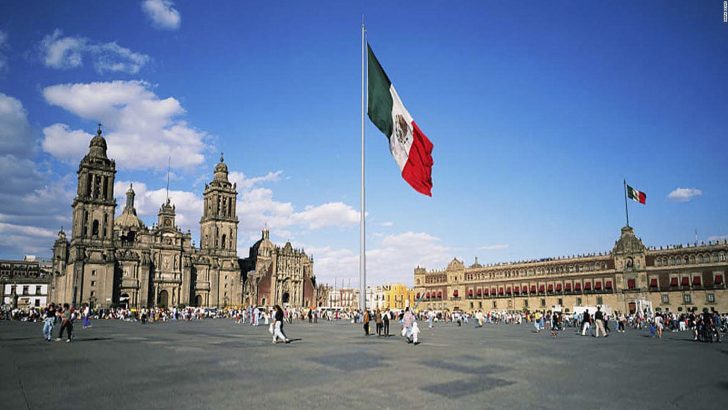
- Mexico : Safety by City
- Aguascalientes
- Cabo San Lucas
- Chichen Itza
- Guadalajara
- Isla Holbox
- Isla Mujeres
- Mexico City
- Nuevo Laredo
- Piedras Negras
- Playa del Carmen
- Puerto Morelos
- Puerto Vallarta
- Queretaro City
- San Luis Potosi
- San Miguel de Allende
- Zihuatanejo
Mexico has a lot to offer, from beautiful beaches, mountains, canyons, and rich cultural life from a diverse group of influences.
There is something intriguing for everyone.
Ancient Mayan and Aztec ruins, as well as some amazing colonial architecture, is itself a major reason to visit Mexico.
In the south especially, there are gorgeous beaches with clear blue water complete with a thriving nightlife.
While Cancun is the major tourist attraction, there are beaches just as nice that are not as developed or crowded.
In some cases, you can find more than one attraction in the same area, such as beaches, ruins, and lots of variety in Mexican culture.
From major cities to out-of-the-way hamlets, Mexico is the neighbor you should want to get to know.
- Warnings & Dangers in Mexico
OVERALL RISK: MEDIUM
The U.S. Government advises people to "reconsider travel" to Mexico, which is the third-highest of four levels of danger.Covid-19, as well as a rise in crime and kidnappings, are the major reasons.Like many countries, some areas are safer than others.Major tourist areas are generally safe.The overall crime rate per thousand people is actually higher in the United States than in Mexico.
TRANSPORT & TAXIS RISK: LOW
You need to use some common sense.Don't accept rides from independent drivers.Ride only in approved or licensed taxis, which are labeled.Get your hotel to call a taxi for you, instead of hailing one on the street.Public transportation is safe but can be crowded and uncomfortable.Generally, it is much safer than renting a car and driving yourself.
PICKPOCKETS RISK: HIGH
This is especially true in tourist areas, where people look for easy targets.Try not to look like a tourist.Don't flash your money or expensive electronics around in public. Keep your valuables locked up and carry as little cash as possible.Keep your papers and wallet safe.Tourist areas and large cities are the worst.
NATURAL DISASTERS RISK: LOW
There have been earthquakes in mountainous areas, as well as hurricanes along the coast, but it is rare to have a major disaster in Mexico.Keep an eye on weather forecasts as you would at home.The infrastructure in Mexico is not that great, so if there is one, it may be worse than if you were at home. Even so, they are rare here.
MUGGING RISK: MEDIUM
Robberies and muggings are on the rise in certain areas.Even so, tourist areas are generally safe during the daytime, as is most of the country.If you stay at a resort in a tourist area, your risk is very low.If you are out at night by yourself in a city, your risk increases dramatically, just as it would in the United States.
TERRORISM RISK: LOW
According to U.S. Govt reports, there is no evidence of foreign terror groups having a base in Mexico or working with drug cartels.There have been very few incidents of terrorism in recent years and those were isolated cases.While terrorism could happen anywhere, there seems to be little risk of it happening in Mexico.
SCAMS RISK: HIGH
Especially in tourist areas, scammers are on the prowl looking for a victim.Fake taxis, fake tour operators, souvenirs, and timeshares seem to be the most common scams.One very common scam is for restaurants to have a different menu and prices for tourists than what locals get.You won't get much help from the police if you are scammed, so you need to be careful.
WOMEN TRAVELERS RISK: LOW
We say low because it really is not any different than in the United States.If you stay in tourist areas, use some common sense - don't go out at night alone - there is little danger.There have been some kidnappings, so that could be a danger.It is not good for a woman to be away from tourist areas alone for that reason.
TAP WATER RISK: HIGH
"Montezuma's Revenge," causes most tourists who drink water to get sick for a day or two.Some are just different minerals that you could get used to. Water is contaminated in many areas, however. Ice at a restaurant may come from tap water.You will get sick from tap water, but it is not fatal or serious in most cases.
- Safest Places to Visit in Mexico
The safest place to visit in Mexico is Cancun, or anywhere along what is called the Mexican Riviera.
The area of Yucatan is built for tourists and it is safe for that reason.
You can also take guided day trips from there to see the Mayan Ruins of Chichen Itza or Tulum, which are also safe.
Cozumel is a tiny island near Cancun that is also a tourist haven, as well as a snorkeling paradise.
The historic center of Mexico City is also a fabulous place to visit and is safe as long as you don’t wander about at night alone.
Merida is a large Yucatan city that is often overlooked by American tourists.
It has a great colonial heritage, beautiful streets, and squares.
It is close to the ocean, with some beautiful underdeveloped beaches.
- Places to Avoid in Mexico
Cities that border the United States are considered unsafe because of drug cartels.
Ciudad Juarez, across from El Paso; Tijuana, south of California; Reynosa, which borders Texas, and Ciudad Obregon near Arizona, are all considered unsafe.
Do not travel there alone and exercise extreme caution.
The U.S. Government has issued a “do not travel” designation for Mazatlán, Acapulco, Matamoros, and Nuevo Laredo.
The “do not travel” designation is because of increased violence, drug cartel activity, and Covid-19.
Generally, the southern part of Mexico is much safer than the northern states.
The states of Sinaloa, Nuevo Leon, Guerrero, and Michoacan all have “do not travel” advisories from the state department.
Some resort cities on this list are unsafe outside the resort, but nearly all resorts themselves are safe for travelers.
- Safety Tips for Traveling to Mexico
1. Avoid looking like a tourist.
Try to blend in as far as clothing, wherever you are.
Don’t flash expensive electronics, jewelry, or cash around where a pickpocket might see it.
Criminals look for easy opportunities.
Don’t be an easy mark.
2. Obey your intuition.
If something feels off or scary, don’t hesitate to run away.
Your intuition is probably right, and even if not, better safe than sorry.
While most areas are safe, there are bad people everywhere, so if your radar is going off, it is doing so for a reason.
3. Safe mentality.
Stay alert and aware of your surroundings.
Make safety your top priority, no matter what else you are doing.
4. Take the Uber.
Public transportation and taxis are safe, but nothing beats Uber as far as safety goes.
When it is available, it’s safer than public transportation.
5. Take group tours.
These are operated by well-trained guides and drivers, and they have a lot of tours to choose from.
Don’t take a tour with some guy on the street making an offer.
It might be great, or you might get killed.
6. Don’t drink the water.
It won’t kill you, but it will make you very sick for a day or two.
Some of it is just the minerals in the water that we are not used to, but there are also contaminated systems in Mexico.
7. Don’t go out at night alone.
Criminals wander around at night looking for an easy target, and a tourist alone is an easy target.
This is especially true for women, but it’s dangerous for men too.
8. Stay downtown.
Unlike the United States, the culture and tourist areas are downtown in Mexico.
Look for the “Centro Historico,” which is the major tourist area in town.
These areas cater to tourists and the government helps keep them safe.
9. Learn a little Spanish.
You don’t need to be fluent, but knowing some words will help.
If people see you are trying to speak their language, they are more likely to offer to help you.
10. Climate awareness.
Be aware of where you are.
Mexico City, for instance, is at a high elevation and that can give you altitude sickness.
The southern areas are hot, so drink plenty of water.
- So... How Safe Is Mexico Really?
There is no place on Earth that is safe all the time.
Bad things can happen, and that is what makes the news.
In reality, Mexico is as safe as the United States.
Forbes Magazine interviewed an FBI agent who worked in Mexico, and he said the country is safe if you use common sense.
A website compared crime statistics between Mexico and the United States and found Mexico to be less dangerous in many statistical categories.
- Crime in general per thousand people is three times higher in the United States.
- Rapes per thousand people are higher in the United States.
- Murders per thousand are higher in Mexico, but gun violence is less prevalent in Mexico.
- Assaults are four times as likely to happen per thousand people in the United States than in Mexico.
- Robberies, or muggings, are more prevalent in Mexico and this happens when people are caught out alone in most cases.
- Some areas are unsafe, and it is not safe to be out at night alone.
Driving a car in rural areas alone is also unsafe.
Tourist areas are safe.
The Mexican government makes a lot of effort to keep it that way.
Even in dangerous areas, you should be fine at a resort as long as you stay at the resort.
- How Does Mexico Compare?
- Useful Information
You do not need a visa to travel to Mexico.A regular passport is all you need.If you are on a cruise ship that leaves and returns to the USA, you won't even need a passport. It takes 8-10 weeks to get a passport once you have applied.The passport costs $110, but you can get a passport card for a short-term visit for $30.
The Peso is used in Mexico, and the exchange rate can change daily.The best place to make the exchange is at a bank, or at an ATM.You may also make the exchange at airports.Mexicans love to have U.S. Dollars, so take some and use them judiciously.Avoid changing money on the street as that can be a scam.
Mexico is a big country, so the weather is as diverse as it is in the United States.In the south, it is hot all the time in a Caribbean-type ecosystem.It can get cold at night in the high mountains around Mexico City any time of year. Light, loose-fitting clothing is best in summer, but bring some warm clothes if you head to the mountains.
Major cities have big airports, and some relatively small cities have them.If you are not on a cruise ship, flying is the best way to get to Mexico.The airport has taxis that will take you to town or where you need to go.Use official taxis, as there are fake ones at times.
Travel Insurance
Part of the fun of traveling is not knowing what will happen.Bad things do happen at times though, so it is a good idea to get some travel insurance.This can help you if you have a sudden change of plans, or if you get injured while in Mexico.It will give you some peace of mind as you explore and find new adventures.
Mexico Weather Averages (Temperatures)
- Average High/Low Temperature
Mexico - Safety by City
Explore mexico.
- 12 Cheapest Places to Live in Mexico
- 10 Best Beaches in Mexico
- 10 Most Dangerous Cities In Mexico
- 10 Best Zoos & Aquariums in Mexico
- 11 Most Beautiful Castles in Mexico
- Are There Alligators in Mexico?
- 15 Best Flea Markets in Mexico
- 16 Pros and Cons of Living in Mexico
- 10 Safest Cities in Mexico
- Top 6 All-Inclusive Family Resorts in Mexico
- Reasons To Visit the City of Tampico in Mexico
- Mexican Slang You Should Know to Feel Like a Local
- Top 12 Activities for Your Trip to Rocky Point, Mexico
- Staying Safe in Mexico: 8 Simple Tips You Should Follow
- Where to Next?

19 Reviews on Mexico
Give mexico a chance.
Mexico and it’s people are beautiful, personally have never had any problems, but Mexico has lost it’s way over the years (Very Sad). Just use caution, and you should be ok
I HAVE TRAVELLED TO SEVERAL MEXICAN CITIES AND HAVE YET TO EXPERIENCE ANY PROBLEMS ALWAYS BEING CAREFUL ABOUT OUR SURROUNDINGS AND ALWAYS USING A CAB RECOMMENDED BY OUR HOTEL FOR ALL OUR LOCAL EXCURSIONS, ALWAYS TIPPING THEM FAIRLY AND ESTABLISHING A TRUSTING RELATIONSHIP WITH OUR DRIVERS AND REUSING THEM. WE AVOID LATE EXCURSIONS, NO JEWELRY, AND FEW CREDIT CARDS, ALONG WITH A SMALL CAMERA TO AVOID ATTRACTION. WE WILL EVEN HAVE LUNCH WITH OUR DRIVER TO MAKE US AND HIM FEEL AT EASE. I HAVE NOTICED THAT WHEN WE FLAG A CAB DOWN THE PRICE FOR THE TRIP IS EXCEGERRATED SIGNIFICANTLY USALLY TWO OR THREE TIMES WHAT IT SHOULD BE.
I have been to Mexico and I had no problem at all.People were friendly,food was great.There is no crime. Go to Mexico! It’s safe!
Truth is bitter
The only thing that’s missing from half of the country is effective government control. The drug cartels field military-grade weapons, and the government needs to respond with their own military helicopters and army formations e.g. to arrest some major druglords.
Brazil might be the only country besides Mexico that’s officially at peace, and yet has to regularly deploy the army to fight against organized crime (though there might be a few other countries as well in Latin America). The cartels will set roadblocks on major highways to enforce the borders of their extensive domains and will commit atrocities to make everyone remember who’s actually in control.
Only the Yucatan peninsula should be relatively safe for travel.
PICKPOCKETS? SCAMS? No way. I have been to Mexico and I have experienced NONE of that. There may be some in the northern part, but NOT in Mexico City! People are VERY friendly. Please go!
The fact that you dont experience a crime, doesnt mean crime doesnt exist. Dont be silly, mexico is alright, but as any latin american country, you cannot do things you can do in Europe like going out by night.
And im a mexican btw, i know my country way better than you
No you don’t You’re over exaggerating things because you’re believing all the things that the media exaggerated about safety in Mexico.
– I’m a Mexican living in the UK.
Need more information
Thank you for your reviews and information. I have noticed that Mazatlan is not covered within your list, is there a reason this city has been overlooked.
Mexico is not safe. Cartels target tourists you need to be careful. Police are corrupt and do not care.
Mexico is actually not what you think.
If you stick to the right areas in Mexico you will be completely safe. This whole Narco stuff is a problem but where I’ve been that being a small town in Jalisco called San Juan De Los Lagos, Its pretty safe, people in Mexico are nice too and will help you if needed. The media is just making Mexico look like a bad place, (which it is on some parts) but for the most part its a safe country if you stick to the good parts.
If you go to Mexico, you might get your head cut off
Mexico is my second home
In my opinion, Mexico is one of the most beautiful countries in the entire world. As a side note, for those that are gamers, you probably know that Forza Horizon 5 is based in Mexico and that game is so beautiful just as Mexico is. This place never fails to amaze me every time I get a chance to visit. I only had time for visiting a few of the many beauties it offers.
What I’ve managed to see so far:
1. Mexico’s Grand Canyon or Copper Canyon or Barranca del Cobre is a spectacular group of deep canyons. There are many ways to explore this place which believe it or not, is larger than the Grand Canyon.
2. Guanajuato is one of those places that needs to be explored by walking. It has many beautiful plazas, many, many splendid buildings architecturally wise. The San Diego Church or the Juarez Theater are just two of them. Another place to visit here is the Museum of Quixote. Don’t miss it.
3. Guadalajara is the second city in size after Mexico City and has a magnificent mix of colonial and Tapatios influences. Here you can truly experience Mexican culture with mariachi being present everywhere, dancing, singing and many, many amazing Mexican dishes that leave my mouth watering just thinking about them.
4. Cancun is a place where you go to relax on the beach and admire the smooth, clear sea. Snorkeling is awesome here as is scuba diving. Plenty of tropical fish to see and places to explore underwater if that’s your cup of tea.
All these places are generally safe during the day, less during the night. Pickpockets are present especially in the larger cities or where there are a lot of crowds so be careful in those instances. It’s generally safe to travel alone, as a man or woman, but traveling during night time is not ok I think. I wouldn’t do it.
Multiple listing "Los Cabos" is the capes, which is CSL and SJD.
Los Cabos consists of Cabo San Lucas and San Jose del Cabo (which you suggest people avoid.)
I am confused why both are listed, and why Cabo San Lucas gets a score of 68, but when you combine the two (to Los Cabos) it gets a score of 80. Since you’re warning people away from San Jose del Cabo, the score should logically be lower, not higher. I guess San Jose del Cabo is MUCH safer than Cabo San Lucas as it would need a score of 92 to average the two into the 80 score of the two cities, assuming equal weighting on each city – 200k vs 150k people. Please sort this out, it’s confusing, from what you’re posting most of the dangers of swimming, riptides, sharks etc are in CSL.
Mérida is the best of Mexico
I crossed the Mexican border for the very first time in 1977.
I spent the day in Juárez which, at that time, was perfectly safe.
Three years later, I crossed the border at Laredo/Nuevo Laredo, launching a three-month-long journey across all of eastern Mexico, Guatemala, Honduras, Nicaragua and Costa Rica. At no point did I feel in danger.
I had fallen in love with Mexico, and returned soon afterward (1981). Eventually, I made my way to Mérida, and really fell in love with that city. I have had a connection with Yucatán since that day. Yes, many parts of Mexico are dangerous today, especially for foreigners. So, rule #1 is to NOT stick out as a tourist. Blend in. It truly breaks my heart to see what has happened over the past 42 years.
I do not personally recommend Quintana Roo, except for the islands of Isla Mujeres and Cozumel.
Cancún and even Tulum have become dangerous. Anyway, I never did like Cancún. Too touristy for my taste. Mérida has always had a reputation for being a very safe city and, while not as safe as it was when I arrived 40 years ago, what city IS? It is a beautiful city with a rich history and culture, and it is very walkable. Winter is the best time to visit, since it is the dry season.
Winter nights are cool, but the days are warm to hot. Public transportation is excellent. Nearby places of interest include Progreso, Dzibilchaltún, Uxmal (and the Ruta Puuc), the Grutas de Loltún, Chichén Itzá (2½ hrs by bus), and various beautiful cenotes. Merida’s central mercado spreads over several city blocks. The “plaza grande” (central square) is historic and beautiful. The cathedral was completed in 1598.
Yucatán has a culture all its own, including dishes that you will find nowhere else (Poc Chuc, Relleno Negro, Cochinita Pibil, Papadzules, Huevos Motuleños, etcetera). I highly recommend Mérida.
Ok but could be better
It’s not that bad last time i went was when i was real little. If you feel lucky maybe you can buy some things there. You should never let your guard down when traveling to such places. I know there are worse places to visit in the world but this gets 4 stars because it is not that interesting. I’m not recommending you go there but if you want to no one is stopping you.
I spent three months in Mexico in 1982 and was married on Isla Mujeres. I have been back many times, sometimes alone, with my young children and with friends. I have never had any problems anywhere I have gone. I have rented cars, had accidents, used public transportation and have travelled by air. When I travel alone I don’t go out at night and I don’t drive at night on the highways but have no trouble driving in the cities or towns. I speak Spanish well enough and this helps so much. I love the geography, people, and culture. As long as you stay away from heavy boozing and drugs you’ll be fine. So much to explore.
Safe but extremely boring sometimes
Mexico wasn’t too bad when i payed a visit. However it can veg boring from time to time. The people were really friendly. I’ve been to this country as a kid but thats when i was a little kid. I wouldn’t let me guard down when it comes to crime but it is good to take a tour every once in a while.
EARTHQUAKES?TSUNAMIS genuine threat
Plenty of major earthquakes, including 2 just 4 years before you created this article that were over 7 on the scale! Tsunamis even possible on the coast. Do more research
Share Your Experience Cancel reply
Your Review
Title of your review
Article Contents
- Overall Risk
- Transport & Taxis Risk
- Pickpockets Risk
- Natural Disasters Risk
- Mugging Risk
- Terrorism Risk
- Women Travelers Risk
- Tap Water Risk
- Weather Averages (Temperatures)
- User Reviews
- Share Your Experience
Popular Destinations

Safety Index
Recent reviews & comments.
- Henry West on New Rochelle
- Dan Erick on New Rochelle
- James Reed on Sioux Falls
- Eduard Corpuz on Sioux Falls
- Benjamin Cooper on Lorain
Popular US States
- Pennsylvania

Search Smartraveller

Latest update
Exercise a high degree of caution in Mexico overall due to the threat of violent crime.
Higher levels apply in some areas.
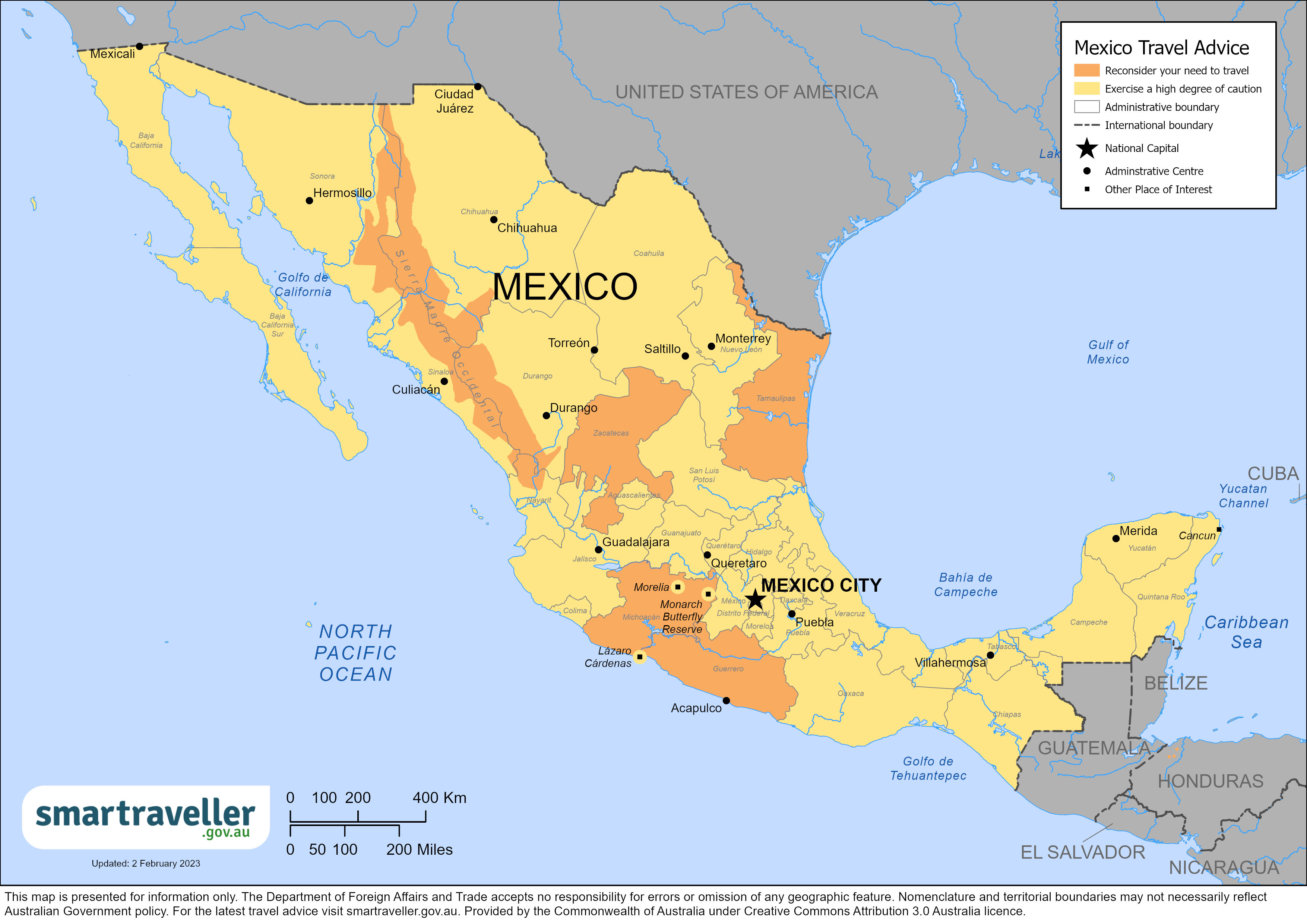
Mexico (PDF 1007.79 KB)
Americas (PDF 3.25 MB)
Local emergency contacts
Fire and rescue services, medical emergencies.
Call 911 or go to the hospital.
Call 911 or go to the local police station.
Advice levels
Exercise a high degree of caution in Mexico overall.
Reconsider your need to travel to Michoacán (except Morelia and Lázaro Cardenas and the Monarch butterfly reserves), Sierra Madre Occidental Mountains in southern Chihuahua and the states of Guerrero (including Acapulco), North-eastern Sinaloa, North-western Durango, South-eastern Sonora (except for the Chihuahua-Pacific Railway), Tamaulipas and Zacatecas.
Reconsider your need to travel to:
- Michoacán (except Morelia and Lázaro Cardenas and the Monarch butterfly reserves)
- Sierra Madre Occidental Mountains in southern Chihuahua
- Guerrero State (including Acapulco)
- North-eastern Sinaloa State
- North-western Durango State
- South-eastern Sonora State (except for the Chihuahua-Pacific Railway)
- Tamaulipas State and
- Zacatecas State
due to high levels of violent crime (including kidnapping and extortion) and their volatile security situation.
- Avoid protests and large public gatherings. These can become violent. It's against the law for foreigners to participate in political activity.
- Mexico has a high risk of violent crime, including murder, armed robbery, sexual assault and kidnapping. Don't travel at night outside major cities. Drug-related violence is widespread.
- Kidnapping and extortion are serious risks. Don't draw attention to your money or business affairs. Only use ATMs in public spaces and during the daytime.
- Stop at all roadblocks, or you risk getting killed.
- Hurricanes and earthquakes are common in Mexico. Local authorities will direct you to your nearest shelter in the event of a hurricane. Know the earthquake safety measures where you're staying.
Full travel advice: Safety
- Malaria and Zika virus are risks in Mexico. If you're pregnant, ask your doctor about the risk of Zika virus before you travel.
- Mexico has insect-borne diseases, including dengue fever, chikungunya, Chagas disease and leishmaniasis. Ensure your accommodation is insect-proof. Use insect repellent.
- Parts of Mexico are at high altitudes. Air pollution can also cause health issues, particularly over winter (December to February). Talk to your doctor before you travel if you have heart, lung or breathing issues.
Full travel advice: Health
- Smoking, including vaping, is banned in all public places in Mexico, including beaches, parks, hotels and restaurants. Importing electronic cigarettes and vaping devices is also prohibited. You may be fined or arrested.
- Some activities are illegal for foreigners in Mexico. These include political activity, driving without insurance, and failing to report a road accident. Ensure you understand and follow local laws.
- Possessing or exporting ancient Mexican artefacts and carrying firearms or ammunition without a permit are also illegal. Apply for a firearm permit at a Mexican embassy or consulate before you arrive.
- Although same-sex marriage is legal in Mexico, some parts of the country are conservative. LGBTI travellers should consider limiting public displays of affection.
Full travel advice: Local laws
- If you're visiting for 180 days or less as a tourist, you'll receive a visa on arrival for the duration of your planned stay. You can't extend your visa if you plan to stay longer than advised to the immigration officer on arrival. Mexican authorities advise to avoid being detained or deported, you must complete an online Multiple Immigration Form (FMM) and obtain a QR code.
- Make sure immigration officials stamp your passport on arrival, as this will state the number of days your visa will be valid. Entry and exit conditions can change at short notice. You should contact the nearest embassy or consulate of Mexico for the latest details.
- To cross the land border between Mexico and the US, you must provide a verbal attestation for your reason for travel. Make sure you receive an entry stamp in your passport.
- Periodic closures of Mexico's land borders with Guatemala and Belize may occur. Check with local authorities before crossing the border or taking a flight.
- If you're taking public transport or taxis, use only first-class buses and official registered taxis. Use ride-share services where possible instead of taxis. Crime levels on intercity buses are high, especially after dark.
Full travel advice: Travel
Local contacts
- The Consular Services Charter tells you what the Australian Government can and can't do to help when you're overseas.
- To stay up to date with local information, follow the Embassy's social media accounts: ( Facebook ), ( X ).
- The Australian Embassy in Mexico City can provide consular assistance by email, phone, or appointment.
- You can also contact the Australian Consulate in Cancún for limited consular assistance.
Full travel advice: Local contacts
Full advice
Violent crime, violent crime.
Mexico has a high risk of violent crime, especially after dark.
Murder, armed robbery , sexual assault and kidnapping are high risks. These crimes can occur at tourist spots and resorts.
Criminals posing as police officers have committed sexual assault, extortion and robbery. They may drive fake police cars.
Gangs have attacked travellers after they've changed money at airports.
To protect yourself from violent crime:
- avoid travelling at night outside major cities, including on major highways
- monitor the media for new safety risks
- don't change large amounts of money at the airport
Crime on intercity buses and highways is common in Mexico.
Thieves have robbed tourists on buses along the Pacific Highway, including from Acapulco to Ixtapa and Huatulco.
Violent carjackings have increased. The northern borders and along the Pacific coast are high-risk areas.
Criminals have attacked tourists on toll roads and highways. The Sonora, Sinaloa, Tamaulipas and border regions are high-risk areas.
Organised crime groups have targeted large campervans and SUVs travelling in and out of the United States.
To reduce the risk of crime when travelling by road:
- use ride-share services where possible instead of taxis
- use official taxis from airports and pre-pay your fare at an official taxi company booth in the airport terminal
- use radio taxis or taxis at assigned stands (sitios), especially in Mexico City
- use first-class buses
- only travel during daylight hours and allow enough time to get to your destination before dark
- drive via toll roads (cuota)
Watch out for drink and food spiking, which can occur in bars, clubs and restaurants. You're at higher risk of sexual assault and theft if you get drugged.
Drug and gang violence
Violent crimes related to the drug trade are widespread in Mexico.
Shoot-outs, grenade attacks and car bombings have occurred in public places.
Targeted attacks have increased on the military, government officials and journalists.
You may become a victim of violence directed against someone else.
Federal police and the military use roadblocks and random vehicle checks to deal with drug-related violence.
Drug cartels set up unofficial roadblocks in the northern areas of Mexico to obstruct military and police movement.
Stop at all roadblocks, or you risk getting killed. Comply with the instructions given.
Risks are higher in those areas most affected by drug-related and gang violence, including:
- Northern border states – Baja California, Sonora, Chihuahua, Coahuila, Nuevo Leon and Tamaulipas
- Pacific coast states – Colima, Guerrero, Jalisco, Michoacán, Nayarit and Sinaloa
- Central region states – Guanajuato, Durango, San Luis Potosi and Zacatecas
- State of Mexico and the State of Veracruz on the Gulf coast
- Major cities along Mexico's border with the United States – Tijuana, Ciudad Juarez, Nuevo Laredo, Matamoros, Nogales, Piedras Negras and Reynosa
State of Guanajuato
Violence and drug cartel activity are on the rise across the State.
Gang members are known to erect roadblocks on major highways. Murders, including mass killings, occur regularly.
Even as a tourist, you risk getting caught up in violence inadvertently.
Avoid known hot spots such as Acámbaro, Celaya, Irapuato, León, Salamanca, Silao and Santiago.
State of Guerrero
The violent crime rate remains high, and the security situation is volatile.
Violent criminal gangs are more active in rural areas than cities.
Acapulco has high levels of violent crime, such as murder and shootings. The resort city is unsafe, especially outside tourist areas. Due to the precarious security situation following damage by Hurricane Otis, there's a threat of armed violence, banditry, and looting in cities and on roads.
Crime risks are lower in the tourist areas of Ixtapa-Zihuatanejo and Taxco and on the toll road to Taxco than in other parts of Guerrero.
Protesters can disrupt toll booths along the road to Taxco, causing delays.
State of Michoacán
Many 'self-defence' groups have formed in the State. They are unpredictable, and the security situation is volatile.
Security near the Monarch butterfly reserves, including on the border with the State of Mexico, has deteriorated due to cartel activity.
Crime is lower in Morelia city.
State of Tamaulipas
Tamaulipas has widespread criminal activity linked to drug trafficking. Kidnapping and extortion are also common.
State of Quintana Roo
Violent crimes related to the drug trade have occurred in tourist areas of Quintana Roo, such as Cancun, Tulum and Playa del Carmen. Shoot-outs have occurred in public places, injuring or killing tourists.
State of Zacatecas
Zacatecas has widespread criminal activity linked to drug trafficking. Violence is increasing due to clashes between competing drug cartels. Kidnapping and extortion are common.
Other violent areas
High levels of violent crime and lawlessness occur in:
- the Sierra Madre Occidental Mountains in southern Chihuahua State
- north-eastern Sinaloa State
- north-western Durango State
- south-eastern Sonora State
Organised crime gangs operate in these regions. The Chihuahua-Pacific Railway is less affected.
The State of Mexico has a high level of violent crime. Murder, assault , armed robbery, extortion and kidnapping are common.
According to Mexican Government statistics, Baja California Sur and Quintana Roo have reported significant increases in drug-related violence, particularly murder. The states with the highest homicide rates are Baja California Sur, Colima, Quintana Roo, Morelos, Zacatecas, Guanajuato, Baja California, Chihuahua, Michoacan and Sonora.
To reduce your risks if travelling to violent areas, stay in:
- tourist areas
- well-known and well-frequented public areas with good access to safe transport in the evenings
To protect yourself from crime in violent areas:
- avoid road travel, especially at night
- avoid isolated locations
- pay close attention to your personal security
- stay alert to possible threats around you
- follow the advice of local authorities
- monitor the media for safety or security risks
Other crime risks
Petty crime.
Petty crime, such as pickpocketing and bag-snatching, is common. Take care on public transport, at tourist spots, airports, hotels and bus stations.
Thieves often work with or pose as taxi drivers. Be aware travellers have been robbed when using taxis hailed from the street.
More information:
- Preventing crime and petty theft
Cyber security
You may be at risk of cyber-based threats during overseas travel to any country. Digital identity theft is a growing concern. Your devices and personal data can be compromised, especially if you’re connecting to Wi-Fi, using or connecting to shared or public computers, or to Bluetooth.
Social media can also be risky in destinations where there are social or political tensions or laws that may seem unreasonable by Australian standards. Travellers have been arrested for things they have said on social media. Don't comment on local or political events on your social media.
- Cyber security when travelling overseas
Kidnapping occurs across the world with political, ideological, and criminal motives. Foreigners, including Australians, have been kidnapped overseas whilst travelling. Kidnaps can happen anywhere, anytime, including in destinations that are typically at lower risk.
Kidnapping is a serious risk in Mexico. Kidnapping occurs throughout the country, with the highest number of cases recorded in and around Mexico City, along the Gulf Coast from Tamaulipas to Tabasco states, and in other large cities. Kidnappers target a broad demographic, including foreigners and expatriates. Victims of traditional kidnappings are physically abducted and held captive until a ransom is paid. In some cases, the captors receive a ransom and kill the victim.
Some victims claim police officers are involved in their kidnapping.
Virtual kidnappings target people over the phone to extort money. Kidnappers pose as officials or cartel members and demand payments for the release of a family member they have allegedly detained. If you receive a call or message, contact local police.
Express kidnappings are also regularly reported in Mexico. Kidnappers force victims to withdraw funds from ATMs before they are released.
If, despite our advice, you travel to an area with a high risk of kidnapping, our ability to provide consular assistance in these destinations will be limited.
To reduce the risk of kidnapping:
- always be alert to your personal security and surroundings
- get professional security advice for travel in locations with a heightened kidnap risk
- check your accommodation has appropriate security measures
- avoid isolated locations, particularly when travelling alone
- notify family or friends of planned travel and share your location
- avoid talking about your money or business affairs
- use ATMs in public places and during daylight hours
- avoid giving personal details to strangers online or over the phone
The Australian Government's longstanding policy is that it doesn't make payments or concessions to kidnappers. Ransom payments to kidnappers have funded further terrorist attacks and criminal activity. Paying a ransom to terrorist groups will likely break Australian counter-terrorism financing laws.
More information:
Civil unrest and political tension
Demonstrations and protests.
It's illegal for foreigners to take part in political activity in Mexico.
Public protests and events that draw large groups of people can turn violent. They're common and often:
- disrupt public services
- cause traffic delays
- stop movement around affected areas
Protesters may blockade roads.
Public protests in Mexico City are common. Expect protests and potential roadblocks in the states of Oaxaca, Chiapas, Guerrero and Michoacán.
To protect yourself during periods of unrest:
- check local sources for details of possible strikes or unrest
- follow advice from local authorities
- change your travel plans in case of disruptions
Demonstrations and civil unrest
Terrorism is a threat worldwide.
Swimming safety
Even strong swimmers can be at risk from undertows and currents on both coasts of Mexico. Obey the beach warning flags.
Climate and natural disasters
Mexico experiences natural disasters and severe weather , such as:
- earthquakes
- volcanic activity
If you're involved in a natural disaster:
- secure your passport in a safe, waterproof location
- keep in contact with your friends and family
- monitor local media and other sources
- contact your tour operator or airline
Register with the Global Disaster Alert and Coordination System to receive alerts on major disasters.
Hurricanes and severe weather
Severe weather occurs in Mexico.
The hurricane season is from June to November. The direction and strength of hurricanes can change with little warning.
Landslides, mudslides and flash flooding can also occur, including in Mexico City.
If there's a hurricane or severe storm:
- you may get stuck in the area
- flights could be delayed or suspended
- flights out may fill quickly
- adequate shelter may not be available
- electricity supply, communication networks and transport options may be disrupted.
To protect yourself if a hurricane is approaching:
- listen to the instructions of local authorities
- know the evacuation plan for your hotel or cruise ship
- identify your local shelter
- monitor alerts and advice from the US National Hurricane Center and local authorities
Earthquakes
Mexico experiences earthquakes and tremors each year. Aftershocks are common and can damage already weakened structures.
Earthquakes can disrupt power and communication systems.
Get to know the earthquake safety measures for each place you stay and visit.
Tsunamis may occur in Mexico.
Receive tsunami alerts by registering with the following:
- Global Disaster Alert and Co-ordination System
- Pacific Tsunami Warning Centre
If you're near the coast, move immediately to high ground if advised by local authorities or if you:
- feel a strong earthquake that makes it hard to stand up
- feel a weak, rolling earthquake that lasts a minute or more
- see a sudden rise or fall in sea level
- hear loud and unusual noises from the sea
Don't wait for official warnings, such as alarms or sirens. Once on high ground, check local media.
Active volcanoes include the Popocatepetl and Colima volcanoes.
Volcanic ash from eruptions of these volcanoes can disrupt domestic and international flights and cause airport closures. Exposure to falling ash and toxic fumes from active volcanoes can also affect your health, especially if you suffer from respiratory ailments.
- Avoid the affected areas
- Monitor local media to remain informed
- Contact your travel agent or airline regarding airport and flight status
- Be prepared to change your travel arrangements or evacuate the area on short notice
- Follow the advice of local authorities, including evacuation orders
The Global Disaster Alert and Coordination System can give you general volcano alerts.
Travel Insurance
Get comprehensive travel insurance before you leave.
Your policy needs to cover all overseas medical costs, including medical evacuation. The Australian Government won’t pay for these costs.
If you can't afford travel insurance, you can't afford to travel. This applies to everyone, no matter how healthy and fit you are.
If you're not insured, you may have to pay many thousands of dollars up-front for medical care.
- what activities and care your policy covers
- that your insurance covers you for the whole time you’ll be away
Physical and mental health
Consider your physical and mental health before you travel, especially if you have an existing medical condition.
See your doctor or travel clinic to:
- have a basic health check-up
- ask if your travel plans may affect your health
- plan any vaccinations you need
Do this at least 8 weeks before you leave.
If you have immediate concerns for your welfare or the welfare of someone you know, call the 24-hour Consular Emergency Centre on +61 2 6261 3305 or contact your nearest Australian Embassy, High Commission or Consulate to discuss counselling hotlines and services available in your location
- General health advice
- Healthy holiday tips (Healthdirect Australia)
Not all medication available over the counter or by prescription in Australia is available in other countries. Some may even be considered illegal or a controlled substance, even if prescribed by an Australian doctor.
If you plan to bring medication, check if it's legal in Mexico. Take enough legal medicine for your trip.
Carry a copy of your prescription or a letter from your doctor stating:
- what the medication is
- your required dosage
- that it's for personal use
Health risks
Insect-borne diseases.
Malaria is a risk in Mexico, particularly in:
- the State of Chiapas
- rural areas of Nayarit, Oaxaca and Sinaloa
- some parts of Chihuahua, Durango and Sonora.
Zika virus is widespread in Mexico. There's no vaccination for Zika virus.
Read the Australian Department of Health and Aged Care page on Zika virus for advice on how to reduce your risk.
If you're pregnant, the department recommends that you:
- discuss travel plans with your doctor
- consider deferring non-essential travel to affected areas.
In Mexico, there's also a risk of:
- chikungunya
- chagas disease
- leishmaniasis
To protect yourself from disease:
- make sure your accommodation is insect-proof
- use insect repellent
- wear long, loose, light-coloured clothing
- consider medication to prevent malaria
Get medical advice if you have a fever, muscle pain, rash or severe headache.
Other health risks
High altitude and air pollution can cause health issues in some regions. Pollution peaks in winter from December to February.
If you have heart, lung or respiratory problems, ask your doctor for advice before you travel.
Foodborne, waterborne and other diseases are widespread. These include:
- tuberculosis
- cyclosporiasis
Serious outbreaks sometimes occur.
To protect yourself from illness:
- drink boiled water or bottled water with sealed lids
- avoid ice cubes
- avoid raw and undercooked food, such as salads
- get vaccinated before you travel
- avoid contact with dogs and other mammals
If you're bitten or scratched by an animal, get medical help straight away.
Get medical advice if you have a fever or diarrhoea.
- Infectious diseases
Medical care
Medical facilities.
Private hospitals in Mexico City and other major cities provide a reasonable standard of care. Services are limited in rural areas.
Treatment at private clinics and hospitals is very expensive.
Doctors and hospitals are unlikely to work with your overseas travel insurer. You'll need to pay before they'll treat you, even for emergency care.
You can find hyperbaric chambers in major cities and resort towns where scuba diving is popular.
You're subject to all local laws and penalties, including those that may appear harsh by Australian standards. Research local laws before travelling.
If you're arrested or jailed, the Australian Government will do what it can to help you under our Consular Services Charter . But we can't get you out of trouble or out of jail.
Smoking, including vaping, has been banned in all public places, including beaches, parks, hotels and restaurants. You may be fined or arrested.
Property laws
Property laws and time-share agreements can be complex.
Before you buy or invest in property, do your research and get legal advice.
In Mexico, it's illegal to:
- conduct political activity, including demonstrations
- possess ancient Mexican artefacts or export them from Mexico
- carry firearms or ammunition without a permit, including in Mexican waters
- drive a car without insurance
- fail to report a road accident.
If you need a firearm permit, apply at a Mexican Embassy or Consulate before you arrive.
You're responsible for any illegal items found in rented or borrowed vehicles. This applies even if you don't know they're there.
If you're the victim of a crime and want to report the incident, do so immediately to the nearest branch of the state prosecutor’s office (Agencia del Ministerio Público). A criminal investigation is not possible without a formal complaint to Mexican authorities. Complaints must be made in person before leaving Mexico.
Australian laws
Some Australian criminal laws still apply when you’re overseas. If you break these laws, you may face prosecution in Australia.
Staying within the law and respecting customs
Dual citizenship
Check if being an Australian-Mexican dual citizen may affect your travel.
Always travel on your Australian passport .
- Dual nationals
Local customs
Although same sex marriage is legal in Mexico, some parts of the country are conservative.
LGBTQIA+ travellers should consider limiting public displays of affection.
Visas and border measures
Every country or territory decides who can enter or leave through its borders. For specific information about the evidence you'll need to enter a foreign destination, check with the nearest embassy, consulate or immigration department of the destination you're entering.
If you visit for 180 days or less as a tourist, you can get a visa on arrival. Be aware of the date that's stamped in your passport on arrival, as you may not receive the full 180 days. Your visa will expire on the entry stamp date. This is usually for the amount of time you indicate to the immigration officer that you are staying in Mexico.
To avoid being detained or deported, you'll need to:
- fill in an online Multiple Immigration Form (FMM) and obtain a QR code
- make sure your passport is stamped by immigration officials on arrival
You can complete the FMM online before you arrive or on arrival.
If you're entering by road, make sure you get the stamp on your passport at the immigration office (Instituto Nacional de Migración: Spanish) . These are usually located near, but not directly at, a border crossing.
Present your completed FMM for inspection at immigration if entering by air. You'll need to show it when you leave Mexico.
Border measures
To cross the land border between Mexico and the US, you'll need to verbally provide the reason for your travel.
Periodic closures of Mexico's land borders with Guatemala and Belize may occur. Check with local authorities before crossing the border or travelling by plane.
Confirm your travel and transit arrangements directly with your airline or travel agent.
Travel via the United States or Canada
If you're travelling through the US , ensure you meet all current US entry or transit requirements, including if you're transiting through Hawaii.
If you travel through Canada , ensure you meet all entry and transit requirements.
Other formalities
Mexico charges all visitors an immigration fee.
If you arrive on a commercial flight, the cost of your ticket includes the fee.
If you enter by land, the immigration office will arrange for you to pay the fee at a nearby bank. There's no exit tax.
A child under 18 years who's also a citizen or resident of Mexico must carry a Mexican Minor Travel Consent Form (Spanish) or a notarised consent if travelling with anyone other than their parent or legal guardian.
You may need a permit if you arrive in Mexico by motor vehicle. Check with the Embassy of Mexico before you travel.
- Advice for people travelling with children
Some countries won't let you enter unless your passport is valid for 6 months after you plan to leave that country. This may apply even if you're just transiting or stopping over.
Some foreign governments and airlines apply the rule inconsistently. Travellers can receive conflicting advice from different sources.
You can end up stranded if your passport isn't valid for more than 6 months.
The Australian Government does not set these rules. Check your passport's expiry date before you travel. If you're not sure it'll be valid for long enough, consider getting a new passport .
Lost or stolen passport
Your passport is a valuable document. It's attractive to people who may try to use your identity to commit crimes.
Some people may try to trick you into giving them your passport. Always keep it in a safe place.
If your passport is lost or stolen, tell the Australian Government as soon as possible:
- In Australia, contact the Australian Passport Information Service .
- If you're overseas, contact the nearest Australian Embassy or Consulate .
Passport with 'X' gender identifier
Although Australian passports comply with international standards for sex and gender, we can't guarantee that a passport showing 'X' in the sex field will be accepted for entry or transit by another country. Contact the nearest embassy, high commission or consulate of your destination before you arrive at the border to confirm if authorities will accept passports with 'X' gender markers.
- LGBTQIA+ travellers
Mexico's official currency is the Mexican Peso (MXN).
Declare amounts over US$10,000 or foreign currency equivalent. Do this on arrival and departure. This covers all forms of currency, not only cash.
US dollars are widely accepted in holiday resort areas. You can't generally exchange Australian currency and traveller's cheques in Mexico.
ATMs are widely available in cities and towns. Take care as credit card fraud occurs.
Carry cash if you're travelling to rural areas.
Most international hotels and tourist facilities accept credit and debit cards.
Ask your bank whether your ATM card will work in Mexico.
Local travel
Driving permit.
You can use your valid Australian driver's licence to drive in Mexico.
Road travel
Vehicles generally don't stop for pedestrians or indicate when they're turning. Intersections can be confusing, with vehicles coming from unexpected directions.
Strict laws cover insurance and reporting of accidents.
If you drive in Mexico:
- learn local road use and driving rules
- keep doors locked and windows up, even when moving
- use toll roads (cuota) to reduce the risk of crime
If you're a victim of roadside robbery or stopped at a roadblock, do as you're asked.
Driving on rural roads in Mexico is dangerous due to:
- poor road conditions.
- pedestrians and livestock on roads
- inadequate street lighting and signage
Criminals target vehicles, including campervans and SUVs, especially in rural areas.
- Driving or riding
Use ride-share services, where possible, instead of taxis. If this isn't an option, it's best to use registered official taxis and limousines, preferably arranged through your hotel. To avoid issues:
- use official taxis from airports
- pre-pay your fare at an official taxi company booth at the airport
- use radio taxis or taxis waiting at assigned stands (sitios), especially in Mexico City
Public transport
Crime levels on intercity buses and highways are high, and the risks increase after dark. See Safety
Use first-class buses.
Women travelling on public transport should be cautious.
- Transport and getting around safely
- Advice for women
Check Mexico's air safety profile with the Aviation Safety Network.
DFAT doesn't provide information on the safety of individual commercial airlines or flight paths.
Emergencies
Depending on what you need, contact your:
- family and friends
- travel agent
- insurance provider
Always get a police report when you report a crime.
Your insurer should have a 24-hour emergency number.
Consular contacts
Read the Consular Services Charter . It details what the Australian Government can and can’t do to help you overseas.
Australian Embassy, Mexico City
Ruben Dario #55 Corner of Campos Eliseos, Polanco Colonia Bosque de Chapultepec 11580 CDMX Mexico Phone: +52 55 1101 2200 Email: [email protected] Website: mexico.embassy.gov.au Facebook: Australian Embassy, Mexico City X: Australian Embassy, Mexico City
Check the Embassy website for details about opening hours and any temporary closures.
Australian Consulate, Cancún
EDIFICIO GRUPO VIVO Calle Luciernaga esquina con Avenida Politécnico Región 501, Manzana 13, Lote 7 Cancún, Quintana Roo C.P. 77535, México Email: [email protected]
24-hour Consular Emergency Centre
In a consular emergency, if you can't contact an embassy, call the 24-hour Consular Emergency Centre on:
- +61 2 6261 3305 from overseas
- 1300 555 135 in Australia

Travelling to Mexico?
Sign up to get the latest travel advice updates..
Be the first to know official government advice when travelling.
Is Baja safe? Should you drive? Things to know before you go
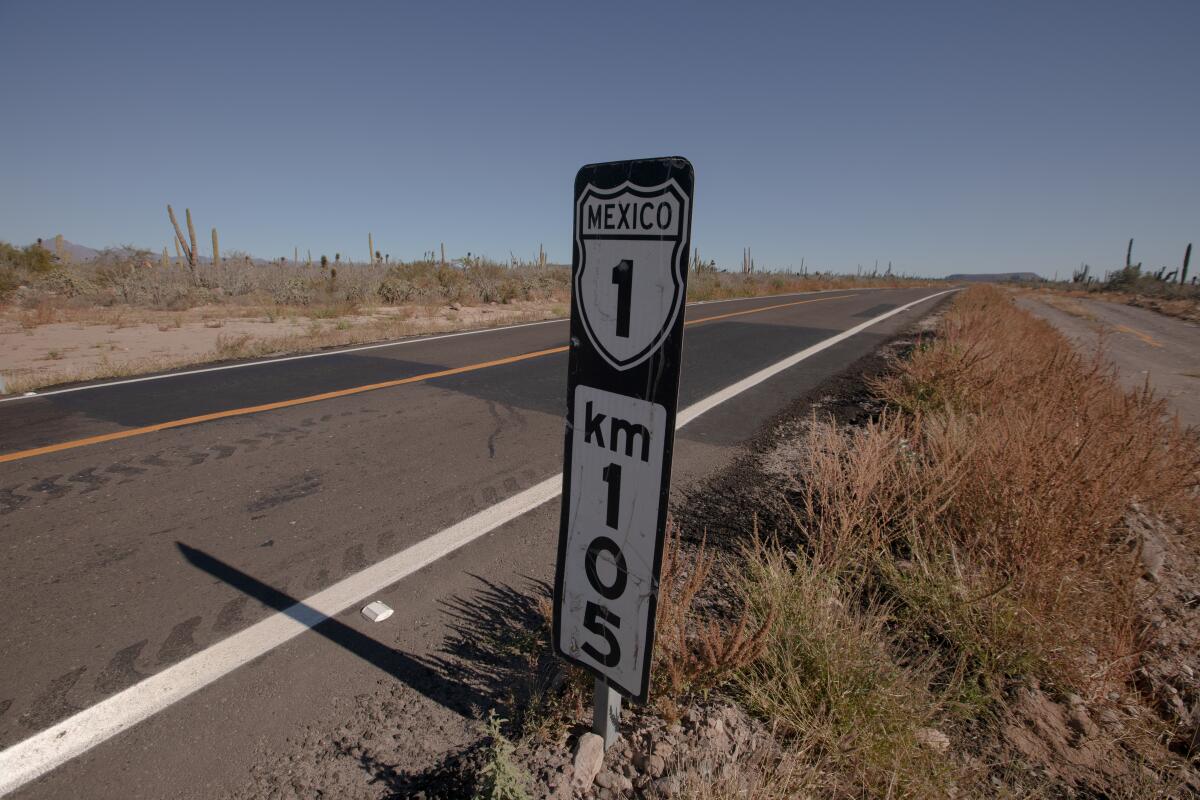
- Show more sharing options
- Copy Link URL Copied!
Homework is vital before travel in Baja California, especially if you’re considering a road trip.
Questions over Americans’ safety in Mexico have been underlined by the mid-January death of Orange County public defender Elliot Blair, who suffered unexplained head injuries at a Rosarito Beach resort; and by the early March shooting deaths of two Americans and one Mexican in an apparently botched kidnapping in Matamoros, 1,570 miles east of Tijuana.
Here’s a rundown of sources I consulted and factors I weighed before my eight-day drive to Cabo San Lucas in early January.
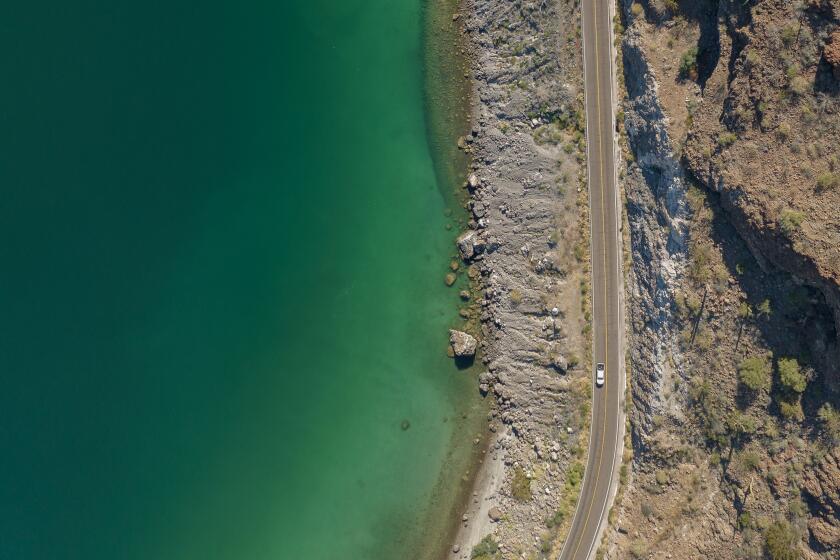
Travel & Experiences
Joshua Tree with beaches and taquerias? No, just an epic Baja road trip
On a drive down the Baja peninsula’s Highway 1, travel writer Christopher Reynolds finds baby whales, a pond to float in and a new generation of adventurers.
March 15, 2023
Overall safety
The U.S. State Department classifies Mexico’s states in four ways for would-be travelers. The most severe advice is “do not travel,” which currently covers the states of Colima, Guerrero, Michoacán, Sinaloa, Zacatecas and Tamaulipas (which includes Matamoros) on Mexico’s east coast.
The state of Baja California is in the second most severe category — “reconsider travel” — because of crime and kidnapping, especially homicides in the non-tourist areas of Tijuana. The State Department urges those who do travel to remain on main highways. The State Department also puts the states of Chihuahua, Durango, Jalisco, Morelos, Sonora and Guanajuato (the latter includes San Miguel de Allende) in that category.
The state of Baja California Sur, which begins about 450 miles south of the U.S. border, is in the State Department’s less extreme “exercise increased caution” category.
Canada’s government urges Canadians to “exercise a high degree of caution” in Mexico.
The website elcri.men , which summarizes and analyzes Mexican crime statistics, said Baja California had the third-highest homicide rate among Mexican states in 2022, in large part because of Tijuana. By the same measure, Baja California Sur had the fourth-lowest rate among Mexican states.
If studying up on conditions in the Baja peninsula makes you or your companions uncomfortable, stay away. Even if nothing goes wrong, feeling unsafe can ruin a trip. (I didn’t drive the peninsula with my family; I drove it with two people who felt comfortable with it.)
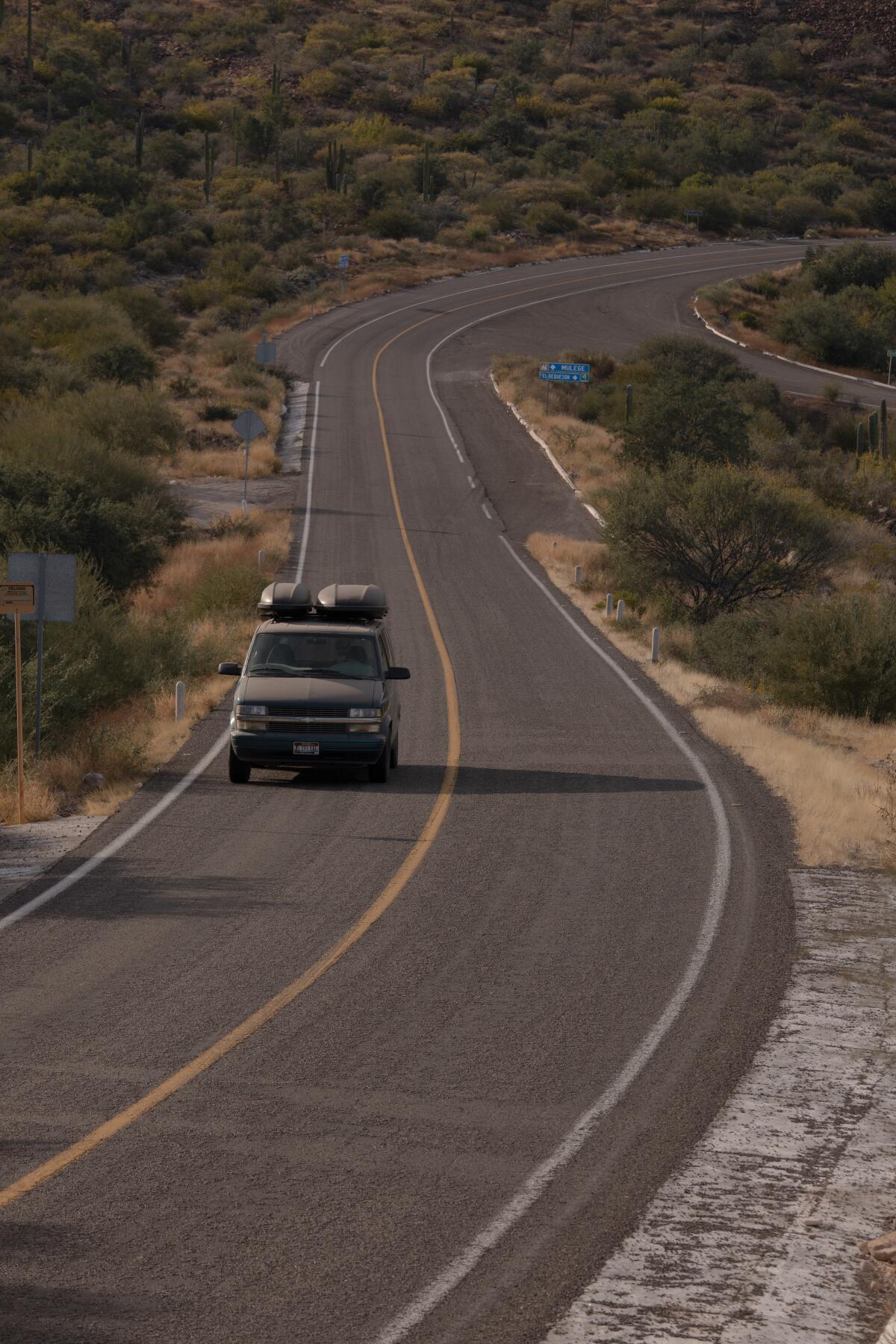
Driving in Baja
In addition to a valid driver’s license, Mexican law requires anyone driving into the country to have Mexico-specific liability insurance.
Many companies specialize in insurance for Americans driving south, offering liability policies that often cost from $10 to $40 per day. More extensive policies can double the cost but may give you more peace of mind. Vendors include AAA , Allstate , Bajabound.com , Baja-mex.com , Discoverbaja.com, Geico and Mexpro.com .
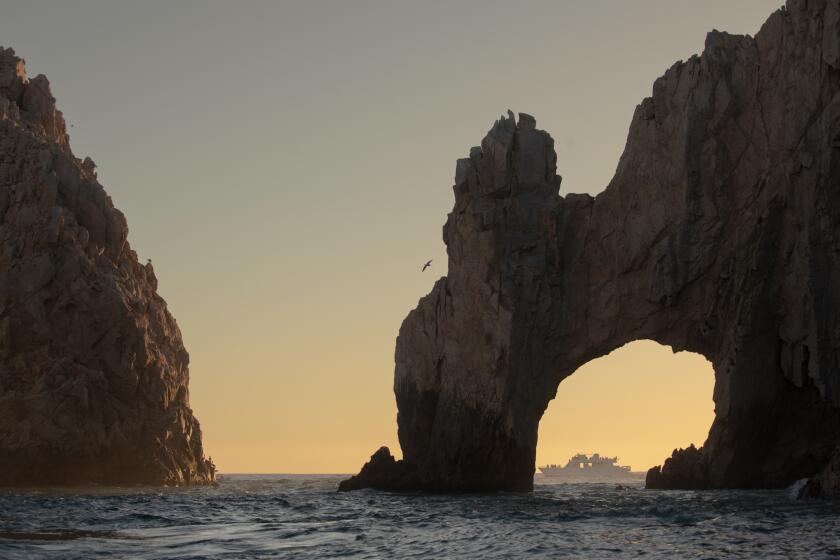
25 restaurants, hotels and hidden wonders along the Baja Highway
Cave paintings. Missions. A lagoon where gray whales gather. Whether you’re taking on the whole highway or targeting one stretch, the landscape is full of revelations.
All authorities agree that driving at night in rural Baja is dangerous because of the many roaming livestock. In addition, drivers should be ready for long, narrow stretches of two-lane blacktop without shoulders or turnouts.
Two other things: Drunk driving is just as illegal in Baja California and Baja California Sur as it is in California. Also, it’s illegal to enter Mexico with a gun without written authorization in advance from Mexican authorities.
More driving tips:
- Occasionally drivers in Tijuana, Rosarito Beach and Ensenada are pulled over after an alleged infraction and offered a chance to pay a fine at the police station or on the spot. Don’t argue or pay on the spot, many Baja veterans say. Instead, they say, the best response is to ask for a written citation and agree to pay the citation at the police station or by mail (or challenge it) . An additional option: calling Baja California’s bilingual Tourist Assistance Hotline (078, around the clock) from any cellphone with roaming privileges in Baja.
- Police checkpoints are placed every few hundred miles along the peninsula. Officers typically ask drivers where they have come from and where they’re going. We went through about six checkpoints, the conversation never lasting more than one or two minutes.
- Many roads to scenic spots are dirt, not blacktop, and best handled by vehicles with four-wheel drive and high clearance.
- The peninsula is so big that most travelers choose to explore selected portions. Many travelers fly to Los Cabos, La Paz or Loreto, rent a car at the airport, drive a loop and return the car where they began. Picking up and dropping off a rental car in different locations is possible in Baja but can double the cost. Topoterra is the only company I could find that would rent me a vehicle in San Diego and let me drop it off (for a fee) in Los Cabos.
- In Baja (and all of Mexico) distances are measured in kilometers, gas is sold by the liter (and usually pumped by an attendant) and speed bumps ( topes ) pop up in some urban areas. Gas prices in Baja have lately fluctuated around 22 pesos per liter (about $4.50 per gallon) and are often cheaper than in California.
- Beyond the Pemex station in El Rosario there isn’t another gas station until Villa Jesús María (just north of Guerrero Negro), 200 miles south.
- More detailed advice is offered by the Automobile Club of Southern California , Bajabound, AllAboutBaja.com and other sources.
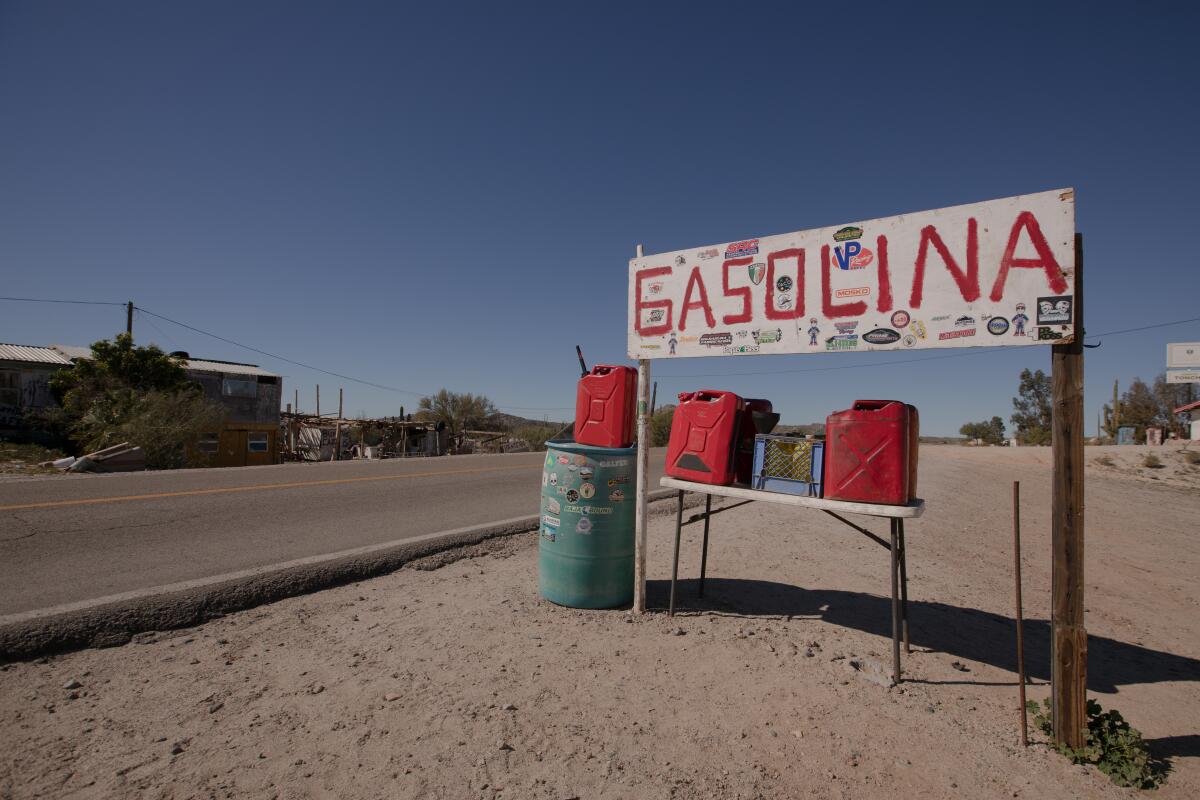
Communication and laws
Southbound travelers must show a passport or passport card and are required to get an FMM tourist permit online or in person from Mexican immigration officials at the border. For trips of more than seven days, the cost is about $36 (687 pesos).
The more Spanish you speak, the better. If you’re hoping to camp on ranch land, the best preparation may be hiring a local guide who can help get you permission.
To ease web access and communication with the U.S., many regular winter visitors to Baja use Starlink , which for $599 up front and $135 monthly allows a road-tripper or RV driver to access the internet from just about anywhere in Baja.
More to Read

The 101 best West Coast experiences
May 16, 2024
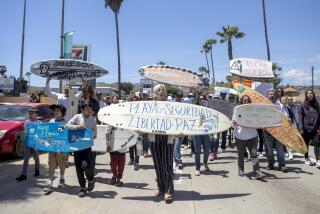
3 bodies in Mexican well identified as Australian and American surfers killed for tires
May 5, 2024

Bodies found in Baja California during search for missing tourists, Mexican officials say
May 4, 2024
World & Nation
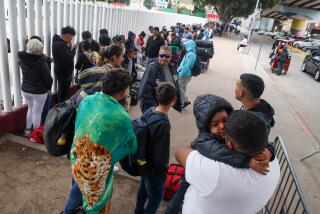
San Diego is now the top border region for migrant arrivals
April 25, 2024
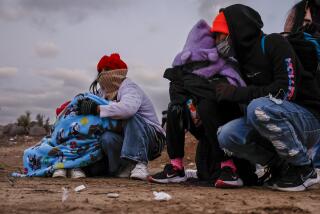
Migrant arrests are up along the border in California and dropping in Texas. Why?
Feb. 26, 2024
Mexican authorities rescue 31 migrants abducted near the Texas border
Jan. 3, 2024
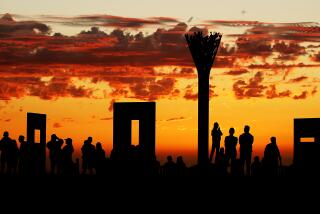
Why do California, Texas differ so much? Religion, priorities of white minority play huge roles, poll shows
Dec. 4, 2023
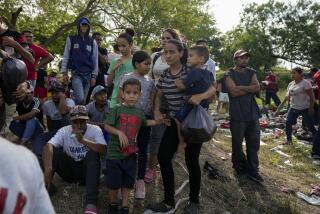
18 migrants killed, 29 injured in bus crash in southern Mexico
Oct. 6, 2023

Mexican Mafia member who ran Ventura County rackets is killed in Baja California, authorities say
Sept. 16, 2023
Sign up for The Wild
We’ll help you find the best places to hike, bike and run, as well as the perfect silent spots for meditation and yoga.
You may occasionally receive promotional content from the Los Angeles Times.

Born and raised in California, Christopher Reynolds has written about travel, the outdoors, arts and culture for the Los Angeles Times since 1990.
More From the Los Angeles Times

Analysis: How did Mexico elect a female president before the United States? Not by accident
June 3, 2024

Mexico elects leftist Claudia Sheinbaum as the first female president in its history
June 2, 2024
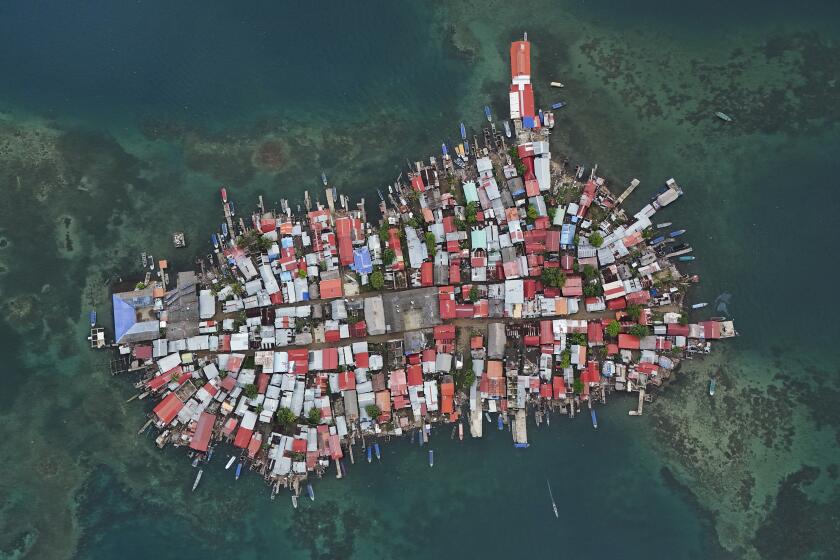
Panama prepares to evacuate first island in face of rising sea levels
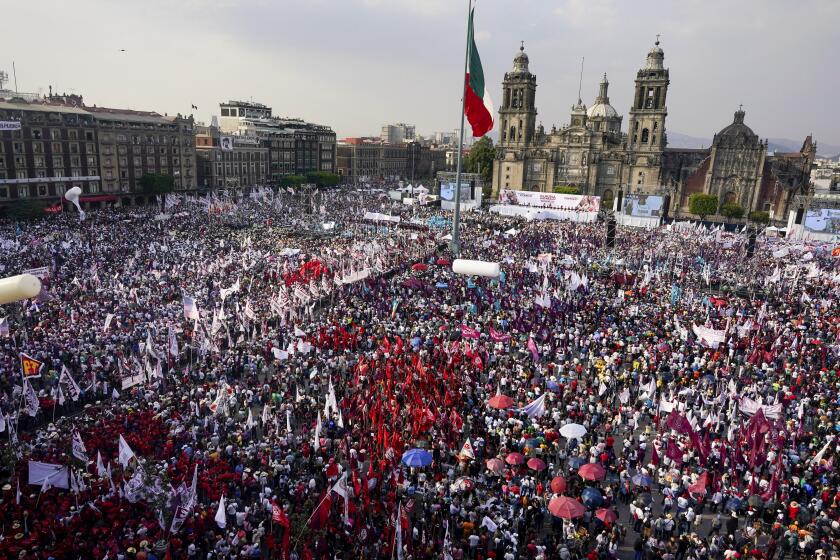
Mexico’s presidential race is between two women. So why is everyone talking about one man?
June 1, 2024
clock This article was published more than 1 year ago
Is it safe to travel to Mexico? What to know ahead of spring break.
The latest context and advice about violence, protests and travel warnings from the U.S. government

As spring break planning heats up, incidents of violence in Mexico continue to make news — leaving travelers to wonder whether a perennially popular destination is safe to visit.
A rash of recent headlines proclaimed that the U.S. State Department was warning against visiting Mexico leading up to the busy vacation season. Although the department has “do not travel” warnings in place for six states, a representative told The Washington Post that it has not updated its travel advisories for Mexico since October.
The U.S. Embassy and Consulates in Mexico have, however, issued a handful of security alerts since January for Ciudad Juárez and several cities in Sinaloa and Quintana Roo states. Reuters reported that an Aeromexico plane was struck by gunfire in early January; the Culiacán airport closed because of violence following the arrest of alleged fentanyl trafficker Ovidio Guzmán, son of Joaquín “El Chapo” Guzmán.
“In light of widely publicized security incidents in popular tourist destinations, please remember that all destinations have some level of risk,” a Jan. 23 alert about taxi disputes in Cancún notes. “Violent crime — such as homicide, kidnapping, carjacking, and robbery — is widespread and common in Mexico.”
Most recently, four U.S. citizens were kidnapped from their vehicle by unidentified armed men in Mexico, the FBI said. The Americans crossed the border Friday into the city of Matamoros , across from Brownsville, Tex. Two were found dead, Mexican officials said Tuesday, and two were rescued and returned to the United States.
A California public defender died in January at a resort in Baja California in what local authorities characterized as a fall from the third floor of the hotel. His family has questioned that ruling, the Orange County Register reported , pointing to analysis of the autopsy that showed injuries inconsistent with a fall.
The United States, of course, has its own problems with violence; mass shootings have averaged more than one a day in 2023, and homicides reached their highest levels in decades over the past few years. Other countries, including Canada , Germany and Australia , routinely warn their citizens about gun crime when traveling to the United States.
Through November of last year, more than 30 million U.S. citizens traveled to Mexico, an increase of 18 percent from the previous year, according to data from the U.S. Department of Commerce. Here’s what government, security and travel experts say visitors should know.
Tourist drug demand is bringing cartel violence to Mexico’s most popular resorts
More travel news
How we travel now: More people are taking booze-free trips — and airlines and hotels are taking note. Some couples are ditching the traditional honeymoon for a “buddymoon” with their pals. Interested? Here are the best tools for making a group trip work.
Bad behavior: Entitled tourists are running amok, defacing the Colosseum , getting rowdy in Bali and messing with wild animals in national parks. Some destinations are fighting back with public awareness campaigns — or just by telling out-of-control visitors to stay away .
Safety concerns: A door blew off an Alaska Airlines Boeing 737 Max 9 jet, leaving passengers traumatized — but without serious injuries. The ordeal led to widespread flight cancellations after the jet was grounded, and some travelers have taken steps to avoid the plane in the future. The incident has also sparked a fresh discussion about whether it’s safe to fly with a baby on your lap .

Cookies on GOV.UK
We use some essential cookies to make this website work.
We’d like to set additional cookies to understand how you use GOV.UK, remember your settings and improve government services.
We also use cookies set by other sites to help us deliver content from their services.
You have accepted additional cookies. You can change your cookie settings at any time.
You have rejected additional cookies. You can change your cookie settings at any time.
Register to vote Register by 18 June to vote in the General Election on 4 July.
- Passports, travel and living abroad
- Travel abroad
- Foreign travel advice
Warnings and insurance
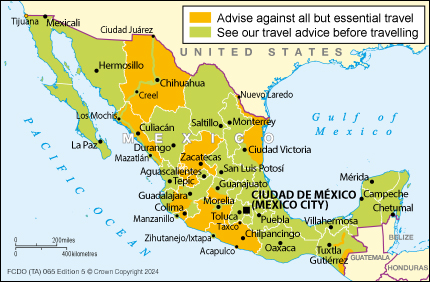
The Foreign, Commonwealth & Development Office (FCDO) provides advice about risks of travel to help British nationals make informed decisions. Find out more about FCDO travel advice .
Areas where FCDO advises against all but essential travel
Your travel insurance could be invalidated if you travel against FCDO advice. Consular support is also severely limited where FCDO advises against travel.
State of Baja California
FCDO advises against all but essential travel to the city of Tijuana, except:
- airside transit through Tijuana airport
- the Cross Border Xpress bridge from the airport linking terminals across the Mexican-US border
- the federal toll road 1D and Via Rápida through Tijuana to the border
FCDO advises against all but essential travel to the city of Tecate in Baja California (including roads between Tijuana and Tecate)
Note: FCDO does not advise against all travel or all but essential travel to any part of the state of Baja California Sur.
State of Chiapas
FCDO advises against all but essential travel to within 40km of the Guatemalan border between the Pacific Coast up to and including the border crossing at Gracias a Dio
FCDO advises against all but essential travel on Federal Highway 199 (Carretera Federal 199) between Rancho Nuevo (just outside San Cristobal de las Casas) and the Chancalá junction just outside Palenque (where Federal Highway 199 meets Federal Highway 307).
State of Chihuahua
FCDO advises against all but essential travel to the state of Chihuahua, except:
- the city of Chihuahua
- the border crossing in Ciudad Juárez (accessed by federal toll road 45)
- federal toll road 45D connecting the cities of Chihuahua and Ciudad Juárez
- the Copper Canyon rail route to and from Chihuahua and towns immediately on this route including Creel
- the road from Creel via San Juanito to San Pedro
- state highway 16 from San Pedro to Chihuahua
State of Colima
FCDO advises against all but essential travel to the state of Colima, except:
- the city of Manzanillo accessed by sea or air via the Manzanillo-Costalegre International Airport
State of Guanajuato
FCDO advises against all but essential travel to the areas southwest of road 45D.
State of Guerrero
FCDO advises against all but essential travel to the state of Guerrero, except:
- the town of Zihuatanejo/Ixtapa accessed by air.
State of Jalisco
FCDO advises against all but essential travel to the areas south and southwest of Lake Chapala to the border with the state of Colima.
FCDO advises against all but essential travel to the northern municipalities of:
- Chimaltitán
- Hostotipaquillo
- Huequilla el Alto
- San Martin de Bolaños
- Santa Maria de los Ángeles
- Villa Guerrero
State of Michoacán
FCDO advises against all but essential travel to the state of Michoacán, except:
- the city of Morelia accessed by federal toll roads 15D, 126 and 43; and the federal toll road 48D between the city of Morelia and the General Francisco Mujica airport
- the town of Pátzcuaro accessed by federal toll roads 14D and 15 from Morelia, and boat trips out to islands on Lake Pátzcuaro
- the Federal Highway 15D
State of Sinaloa
FCDO advises against all but essential travel to the state of Sinaloa, except:
- the cities of Los Mochis and Mazatlán
- road 32 that runs between El Fuerte and Los Mochis
- the 15D federal toll road that runs the length of the state
- the Copper Canyon rail route to and from Los Mochis, El Fuerte and the towns immediately on this route
State of Tamaulipas
FCDO advises against all but essential travel to the state of Tamaulipas, except:
- the border crossing at Nuevo Laredo accessed by federal toll road 85D from Monterrey
- Federal highways 80, 81 and 85 between Tampico, Ciudad de Victoria and Magueyes, and the entire area of Tamaulipas south of these highways.
State of Zacatecas
FCDO advises against all but essential travel to the state of Zacatecas.
Find out more about why FCDO advises against travel to these areas .
Before you travel
No travel can be guaranteed safe. Read all the advice in this guide and any specific travel advice that applies to you:
- women travellers
- disabled travellers
- LGBT+ travellers
Follow and contact FCDO travel on Twitter , Facebook and Instagram . You can also sign up to get email notifications when this advice is updated.
Travel insurance
If you choose to travel, research your destinations and get appropriate travel insurance . Insurance should cover your itinerary, planned activities and expenses in an emergency.
Related content
Is this page useful.
- Yes this page is useful
- No this page is not useful
Help us improve GOV.UK
Don’t include personal or financial information like your National Insurance number or credit card details.
To help us improve GOV.UK, we’d like to know more about your visit today. Please fill in this survey (opens in a new tab) .
or with email
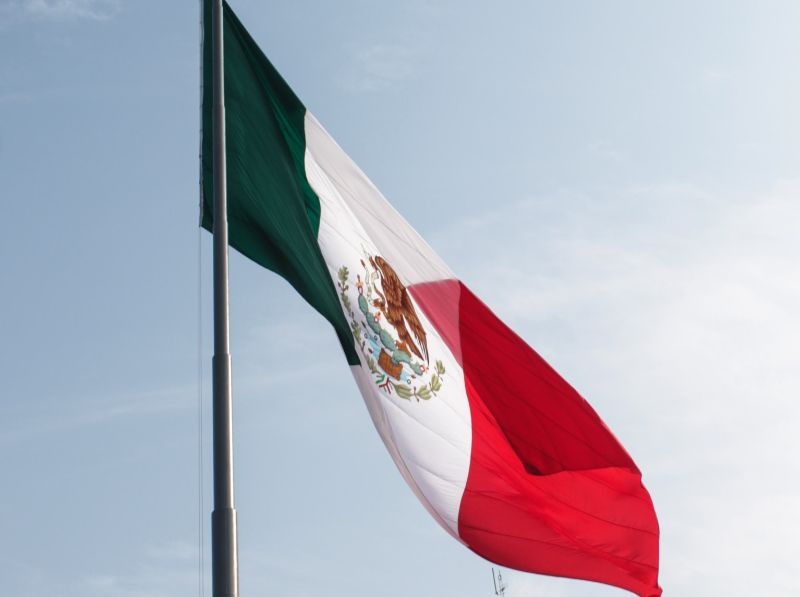
Is There a Travel Advisory for Mexico City in 2024?
Updated September 11, 2023
Travel advisories all over the world have changed since 2020 due to the pandemic. Currently, the US State Department has divided up its Mexico travel advisory by state. ViaHero destination Mexico City is currently at Level 2, “exercise increased caution” due to crime. The State Department advises this increased caution outside of tourist areas, especially at night, while remembering that crime can occur anywhere in the city. The CDC lists Mexico at Level 3 as of August 2022, indicating a high level of COVID-19 in the country; however, this can change frequently and you can check the current level anytime on the CDC website .
Here's what you need to know about safety in Mexico City, during normal times:
Mexico City has historically had a low travel advisory
A frequently asked question about Mexico City travel concerns safety. So, is Mexico City safe? Generally, yes.
How can we be so sure? Before the pandemic, the US State Department gave the country of Mexico the same travel advisory level as France, the UK, and Germany—all four were given a “ Level 2 ” rating. The region of Mexico City also had a Level 2 rating—which simply means that visitors should “exercise caution” (you know, as you should in any big city).
Earlier in the pandemic, the State Department gave 140 countries, including Mexico, a Level 4 rating (Do Not Travel) because of COVID risks. However, this risk has decreased and Mexico is no longer listed as “Do Not Travel.”
Pro tip : Alongside a good safety rating, Mexico City is also extremely accessible. There are tons of cheap flights to Mexico City , most people don’t need a visa to visit , and there’s really no bad time to go .
Travel to Mexico City is safe and easy
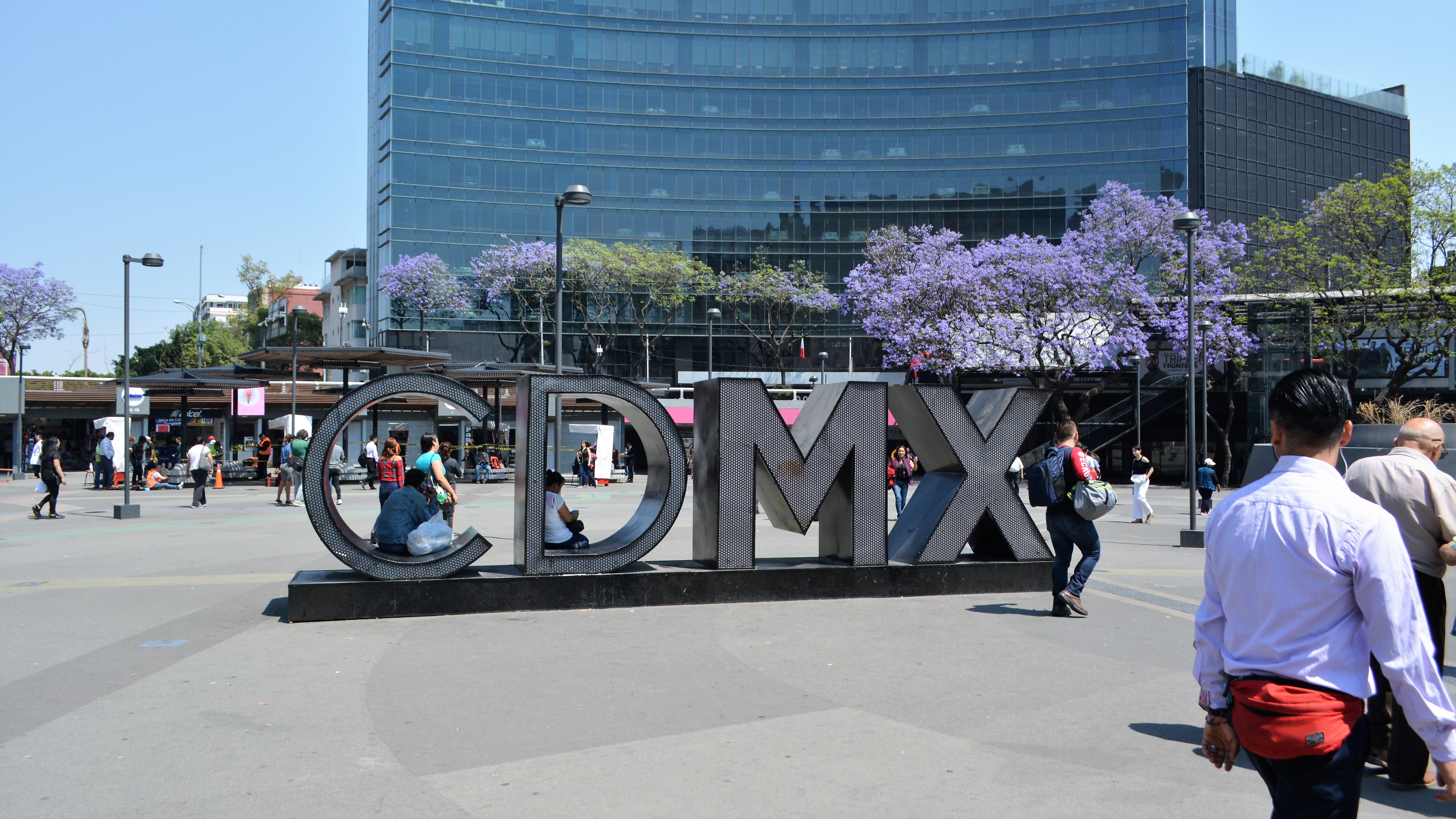
Mexico City is safe . Of course, visitors should exercise the same precautions as they would in any bustling metropolis (like Paris, London, New York, etc.)—Uber when it’s time to go home, avoid low-traffic areas, and stay sharp.
Anyone who’s planning to travel to Mexico City should also be aware that while petty crimes do occur in areas popular with tourists, most violent crimes are gang-related and take place far, far outside of frequented areas.
Pro tip : If you’re still hung up on safety concerns, feel free to talk to a Mexico City local to soothe your fears!
And most popular neighborhoods are super safe
There are tons of incredible neighborhoods in Mexico City , from hipster favorites like Roma and Condesa to the bustling Centro Historico. And different as these areas might be, they all have something in common: they’re all super safe (even for Mexico City solo travelers ).
Again, most crime—especially violent crime—occurs far away from anywhere a traveler would conceivably end up (in neighborhoods like Tepito, Doctores, or Iztapalapa).
Most of Mexico City’s most popular attractions are located in the neighborhoods you’d already want to stay in anyway, so there’s no need to wander too far from the main drag. And even if you’re looking for non-touristy things to do in Mexico City , the likelihood of you entering these neighborhoods is still slim-to-none.
Still nervous about staying safe in Mexico City? Follow these tips:

Although Mexico City is safe, we do have some Mexico City travel tips for staying out of harm’s way:
- Don’t carry a lot of cash : Since Mexico City prices are generally advantageous to foreigners, you will want to use cash instead of your card (psst—withdraw pesos at the airport, at ATMs within banks, or at your hotel, not from street kiosks). But don’t carry tons of cash—just what you need. And be discreet about it.
- Buy bottled water : Any Mexico City travel guide will tell you—water in Mexico City is not safe to drink. Buy bottles of water instead. They’re cheap!
- Use Uber at night : With so many things to see in Mexico City , you’ll constantly be on the move. Although the metro is an easy way to travel during the day, it’s better to opt for an Uber at night. In any case, avoid the taxis .
Our travel advisory for Mexico City? Travel smart.
Here’s our verdict: Take the same precautions you would in any big city, and you’ll be fine. Mexico City is full of amazing things to do , whether you’re looking to track down the city’s best landmarks , or simply trying to track down the best tacos. Still, it’s natural to be nervous—so talk to one of our local Mexico City trip planners for help putting together an amazing, fun, and safe trip. And as always, contact us if you have any questions!
Ready to head south of the border? Have a Mexico City local help plan your trip . They’ll get to know your interests and travel style to help you create your perfect itinerary, complete with tons of insider safety tips. They’ll also be on-hand with 24/7 phone support to help you with any issues that come up during your trip! And don’t forget to check out:
- Connect With a Local to Plan Your Trip
- Where Should You Stay in Mexico City?
- 25 Places You Have to Visit in Mexico City 2024
- 6 Mexico City Tourist Attractions That Are Actually Awesome
- Mexico City on a Budget: 10 Must-See Spots
- Mexico City with a Travel Agency: Pros and Cons
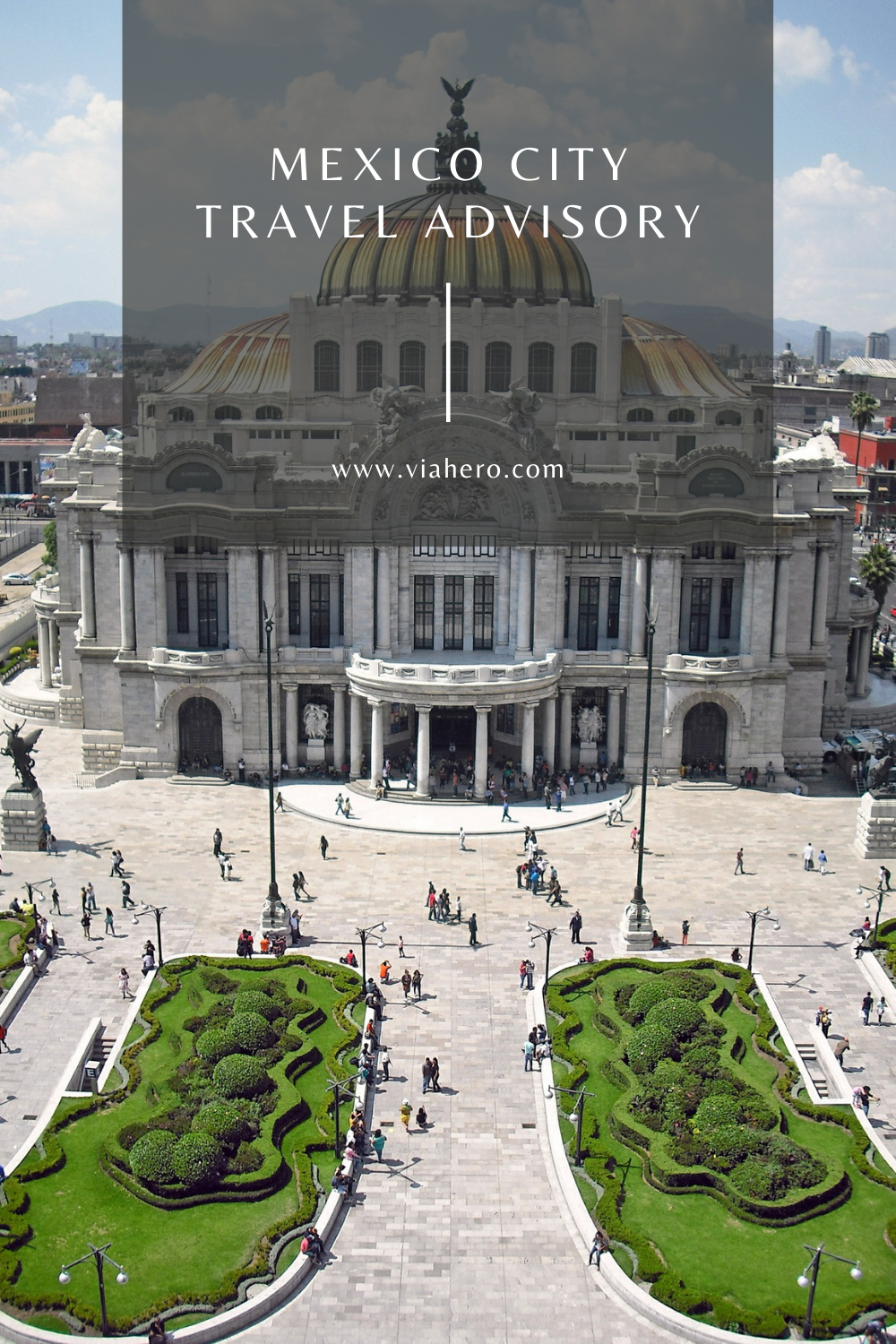
Leave a comment:
Sign up to never miss a post!
Recent Posts:
- Project Expedition Explores the Eternal City: Our Trip to Rome
- Is Puerto Rico Safe for Travel in 2024?
- When’s the Best Time to Visit Puerto Rico in 2024?
- What You Need to Know About Transportation in Thailand
- Puerto Rico Tourism Update 2024

Select Account Type
Sign-up with
Almost there!
Find booking.
How should we contact you?
Thank you! We'll get back to you as soon as possible!
Click here to register and track your question!
If you would like to follow up with us:
+1 (855) 782-3006
Forgot your password?
Enter your email address below and we'll send you a reset link:
Map Options

Safest Countries in the World 2024
Iceland has been the safest country in the world for the 14th year in a row, according to the Global Peace Index.
The Nordic countries of Europe (Norway, Sweden, Denmark, Iceland, and Finland) rank among the 25 safest globally, most of them also being among the top 10 happiest nations worldwide.
Common attributes of the world's safest countries include high levels of wealth, social welfare, education, effective criminal justice systems, and positive government-citizen relationships.
The Global Peace Index (GPI) ranks the safest and most peaceful countries in the world. This report is published annually by the Institute for Economics and Peace, which defines itself as "an independent, non-partisan, non-profit organization dedicated to shifting the world's focus to peace as a positive, achievable and tangible measure of human wellbeing and progress." The report researches countries to determine which are the safest and which are the most dangerous .
A total of 163 countries are featured in the GPI report, which ranks each country's level of safety or danger based upon 23 different indicators. The indicators used to compile the GPI include the number of internal and external violent conflicts, level of distrust, political instability, potential for terrorist acts, number of homicides, and military expenditures as a percentage of GDP. These indicators are grouped into three broad categories—Ongoing International Conflict, Societal Safety and Security, and Militarization—and a score is calculated for each of the 163 nations featured in the report. The lower the score, the higher the nation is ranked in terms of safety.
Top 15 Safest Countries in the World (Global Peace Index — lower is better):
The United States ranked 129th in the Global Peace Ranking for 2022. The United States' ranking has fallen every year since 2016, a drop usually attributed to a decrease in life satisfaction, rising political division, and an increasing wealth gap.
Is the World Becoming More or Less Safe?
According to the 2022 GPI report, the world has become less safe over the past 14 years, with per-country scores deteriorating by 3.2% on average. The report further notes that safety and peacefulness have decreased for eleven of the past fourteen years. For example, global peace declined by 0.3% overall between the 2021 and 2022 GPI reports. While safety improved in 90 countries, it dropped in 71 countries (and remained stable in two), for a net loss.
The 2022 report also states that declines tend to happen more swiftly and precipitously than do improvements, and pointed out that the most significant deterioration occurred in countries in conflict, such as Russia , Ukraine , Guinea , Burkina Faso , and Haiti . Europe remained the most peaceful region in the world, a position it has held for all the 16 years in which the Global Peace Index has existed.
World peace also decreased between the 2020 and 2021 reports, though by a much smaller margin of 0.07%, with 87 countries improving and 73 deteriorating. The COVID-19 crisis and increasing tensions among major world powers were cited as two main causes for the decrease. A comparison of the 2020 and 2019 reports, to step back a year, reveals a total of 81 countries growing more peaceful and 80 deteriorating. The average country score deteriorated by 0.34%.
The Safest Continent in the World
A majority of the top 25 safest countries are European countries. Most notable are the Nordic countries of Europe. Norway , Sweden , Denmark , Iceland , and Finland are not only among Europe's safest countries , they are among the top 25 safest countries anywhere on Earth. This region is thus considered the safest in the world, with a homicide rate of 0.8 incidents per 100,000 inhabitants. These five Nordic countries are all in the top 10 happiest countries in the world as well. The second-safest region among the top 25 safest countries is Asia . Both Europe and Asia have the world’s lowest homicide rates of 3 or fewer per 100,000 inhabitants.
Qualities the World's Safest Countries Have in Common
There are some commonalities among the safest countries in the world. For instance, safe countries tend to display high levels of wealth, social welfare, and education. Additionally, safe countries typically have effective criminal justice systems and governments that maintain very healthy relationships with their citizens.
Profiles of the World's 10 Safest Countries
According to the Global Peace Index, Iceland is the safest country in the world for the 14th year in a row. Iceland is a Nordic nation with a relatively small population of 340,000. Iceland has a very low level of crime, which is typically attributed to its high standard of living, small population, strong social attitudes against crime, a high level of trust in its well-trained police force, and a lack of tension among social and economic classes. Iceland has no military, and the police do not carry firearms (only extendable batons and pepper spray). Iceland also has laws in place to guarantee equality, such as legal same-sex marriage and same-sex adoptions, religious freedom, and equal pay for men and women.
2. New Zealand
New Zealand is the second-safest country in the world. Like Iceland, New Zealand has a very low crime rate, and violent crime is especially rare. Theft is still worth guarding against, especially in tourist areas (which holds true in every country in the world), but overall risk is minimal. Unlike its neighbor Australia , which is known for its dangerous wildlife (box jellyfish, taipan snakes, stonefish, funnel web spiders, and more), New Zealand has no deadly animals. New Zealanders are generally open-minded and have laws in place to prevent the violation of anyone's freedom of speech or expression. As in Iceland, police in New Zealand do not carry personal firearms.
Ireland became notably more peaceful in 2021 and vaulted from 11th place to 3rd in the 2022 rankings as a result. Crime is quite low outside of a few city neighborhoods ( as in any country, one should be wary of pickpockets and scammers in tourist-dense areas), and there is little threat of cultural violence or terrorism. In fact, the Irish landscape may pose a greater safety risk than its people—the country's breathtaking cliffs and winding country roads must be treated with respect, especially during a sudden rainstorm or in areas with no cell reception.
Ranked fourth on the 2022 Global Peace Index, Denmark is another one of the safest and happiest countries in the world. Denmark is one of the few countries where people report feeling safe at any time of day or night, even children. Denmark has a high level of equality and a strong sense of common responsibility for social welfare — two qualities that contribute to its citizens' feelings of safety and happiness.
Corruption is rare in Danish business or politics, as honesty and trust are top priorities. While Denmark has a high personal income tax , it funds social programs that ensure all people receive services and perks that help them live comfortable lives. For example, everyone in Denmark has access to tuition-free higher education and healthcare with no additional fees to them, and the elderly are provided at-home care helpers.
Austria ranked as the fifth-safest country in the world for 2022. While violent demonstrations in the wake of ongoing social unrest remain a concern, these are relatively easy to avoid, and otherwise, Austria is a very safe country to visit. Serious crimes are uncommon (with the usual caveat to watch for pickpockets and purse-snatchers). Additionally, Austria has been spared any major acts of terrorism in recent years.
6. Portugal
Portugal comes in sixth in the most peaceful countries rankings for 2022. In 2014, Portugal was ranked 18th globally and has since made significant strides. Unlike Iceland and New Zealand, Portugal has armed police; however, an increased police presence has resulted in a decreased crime rate in the country. In recent years, Portugal has experienced an economic resurgence, decreasing its unemployment rate from over 17% to under 7%. Portugal consistently ranks among the best countries for retirement , due in no small part to its high level of safety.
7. Slovenia
One of the former constituents of Yugoslavia , Slovenia has a high safety ranking that can be attributed to its excellent scores in three categories: travel security, medical risks, and road safety. Like many Slavic states , Slovenia installed a democratic government in the mid-1990s and is now focused on improving quality of life in many areas, including safety and sustainability.
8. Czech Republic
Crime rates in the Czech Republic have steadily decreased over the years, with rates of violent crime in particular dropping significantly. The Czech Republic also has a low incidence of terrorism and natural disasters. Finally, the country boasts many clean and efficient hospitals and a state-run health insurance system that offers affordable rates and enables near-universal coverage.
9. Singapore
Singapore ranks ninth on the GPI for 2022. In a Gallup report from 2018, Singapore residents felt the highest sense of personal security and had more positive experiences with law enforcement than did residents of any other country. Singapore has one of the lowest crime rates in the world, possibly due to the severe penalties that are issued for even small crimes. The government and police strictly control guns and other firearms, and violent and confrontational crimes are rare in Singapore.
As a city-state, Singapore also ranks as the second- safest city in the world according to the Safe Cities Index from the Economist Intelligence Unit (EIU). In 2019, Singapore ranked first for infrastructure security and personal security, second for digital security, and eighth for health security.
The tenth-safest country in the world for 2022 is Japan. Japan has been in the top ten countries in the Global Peace Index for 14 years, consistently receiving high marks for low crime rates , minimal internal conflict, and virtually nonexistent political unrest. Japan's proximity to potentially hostile neighbors China and North Korea could become a threat to its safety at some point, but has not thus far.
Japan is known for citizens having limited access to firearms, as the Japanese do not view carrying a firearm as an individual's right. According to the Safe Cities Index from the Economist Intelligence Unit, Tokyo was the safest city in the world in 2019, ranking first in cybersecurity, second for health security, and fourth for infrastructure security and personal security.
IEP applies a rigorous research process to arrive at its GPI rankings. According to IEP , “The GPI covers 163 countries comprising 99.7 percent of the world’s population, using 23 qualitative and quantitative indicators from highly respected sources.”
Download Table Data
Enter your email below, and you'll receive this table's data in your inbox momentarily.
What is the safest country in the world?
Iceland is the safest country in the world, with a Global Peace Index of 1.124 .
What are the 5 safest countries in the world?
The 5 safest countries in the world are Iceland , Denmark , Ireland , New Zealand and Austria .
Frequently Asked Questions
- Global Peace Index 2022 - Institute for Economics and Peace
- These Are the Safest Countries - US News
- Most Dangerous and Safest Countries Index - TravelSafe Abroad
7 Safest Beach Towns In Mexico With Low Crime Rates
Explore the natural wonders, archaeological sites, and gastronomic delights of Mexico while staying safe at these cities with low crime rates.
- Traveling to Mexico? Choose safe beach destinations like Cabo San Lucas with a low crime rate of 42.07 for a worry-free vacation.
- Tulum offers easy-going vibes with a crime rate index of 37.98, making it a sparkling gem of the Riviera Maya for tourists to enjoy.
- La Paz, the safest city in Mexico on the list, promises stunning beaches, desert terrain, and vibrant green waters for a memorable trip.
When traveling, feeling safe is one of the most important things that can make or break the quality of a vacation. For tourists seeking a beach respite in Mexico, legitimate concerns over safety may arise in certain areas. Although Mexico is known for its beautiful beaches, unique focus on eco-tourism, rich history, and delicious food, there are still places in the country that are not amenable for conventional tourism yet.
While many vacations run into unexpected hiccups, tourists can minimize anxieties simply by choosing the right place to go in the first place. For U.S. tourists venturing south of the border, Mexico boasts many beach towns that are as safe as they are beautiful. In this list, you'll find seven beachside cities and towns in Mexico that offer safe vacations, presented in descending order of crime index.
When reading the crime index numbers, it's good to have a comparison in mind. For example, the crime rate in Mexico's most dangerous city of Tijuana is 72.10 (very high) and Mexico City is 67.74 (high) .
10 Scenic Small Towns To Visit On The Yucatán Peninsula
Crime rate index: 47.06.
History comes alive in the Caribbean city of Chetumal. With a crime index of 47.06, it ranks as a relatively safe destination, ideal for a beach vacation rich in history and archeology. After spending an afternoon basking in the warm sunshine of Mahahual Beach , tourists can head to the Museum of Mayan Culture to learn about the incredible artifacts left behind by the Ancient Mayans.
To learn more about this rich history, a trip to the archaeological site of Dzibanche is a must; once a bustling Classic Maya city, Dzibanche once boasted a population of 40,000 people. Tourists can also head to Kohunlich , the site of a sprawling Mayan palace from 500 AD.
Chetumal is considered to be a highly safe city for walking alone during the daylight hours, and moderately safe for walking alone at night. This makes it an excellent choice for adventure-seeking tourists with an interest in archeology, offering the perfect mix of beachside relaxation and historic education.
As in many places in the Yucatan Peninsula, this crime rate index is brought up by the recreational use of drugs, not necessarily by violent crime.
6 Playa del Carmen
Crime rate index: 46.81.
Playa del Carmen is one of the Yucatan's paradise destinations for family travel , and with good reason. This beachside city is notably safe, with a crime index of 46.81 .
Playa del Carmen has no shortage of exciting activities for tourists to do. Tourists traveling with kids will have a blast at the eco-adventure waterpark, Xcaret Park , where families can snorkel to their hearts' content, swim with dolphins, meet exotic animals, and see historical reproductions of Ancient Mayan life. The park was named after the nearby archaeological site of Xcaret, an important trading center for the Ancient Mayans.
What's so great about Playa del Carmen is that it's an excellent entry point for some of Mexico's best historic ruins. Just a short drive away are the awe-inspiring ruins of Chichén Itzá , which are one of the Seven Wonders of the World .
Another great place within driving distance is Cenote Dos Ojos . Cenotes are a staple of the ecology of the Mayan Riviera; these jungle sinkholes offer tourists a cool place to swim after a day of sightseeing in the hot summer sun.
5 Cabo San Lucas
Crime rate index: 42.07.
On the rugged shores of Mexico's Baja California Sur is the city of Cabo San Lucas. For American tourists who are interested in nature adventures, this city is renowned as one of the safest cities to visit in all of Mexico.
With expansive views of the dark blue Pacific Ocean, dramatic geologic rock formations along the coastline, swaying palm trees, and beaches galore, Cabo San Lucas is considered by many to be the perfect place for a Mexican vacation. Tourists can explore beaches like El Medano Beach, Chileno Bay Public Beach, Santa Maria Beach, and Lovers Beach.
Positioned on the wild Pacific, Cabo San Lucas is also home to an excellent fishing scene, great whale-watching, and beachside horseback riding. Besides all of this, Cabo San Lucas is great for golfing, spas, nightlife, and shopping.
Skip Chichen Itza & Visit Uxmal: One Of The Yucatan's Most Spectacular Mayan Cities
Crime rate index: 39.96.
Another one of Mexico's most safest cities is also located on its Pacific Coast. This is the colorful city of Mazatlan, where tourists can expect a safe beachside getaway. From historic cathedrals to hiking opportunities to peaceful beaches, tourists will find Mazatlan has a plethora of exciting activities to do.
Tourists looking for a thrill would be remiss if they didn't stop at the city's 50 foot cliff diving sites. Those who are looking for a more relaxing time in the city should head to Old Mazatlan, where tourists can shop, eat, and enjoy historic buildings. Those interested in religious history should head to Catedral Mazatlan Basilica de la Inmaculada Concepcion to see a gorgeous 19th-century church.
Those who know a bit about the local history of Mazatlan and are interested in linguistics will know that the city's name means "the place of deer" in Nahuatl. A local place in the city where tourists can experience this linguistic connection is Deer Island (Isla de Venados) . Here, tourists can snorkel, kayak, hike, and go birding.
The Ultimate Travel Guide To The Yucatán Peninsula: Scenic Sites & Best Times To Visit
Crime rate index: 37.98.
The safe-to-visit city of Tulum is one of the Riviera Maya's most sparkling gems. With crystalline water, archaeological ruins that tower over the coastline, sandy white beaches, and delicious food, Tulum is one of the best places in Mexico to visit for those who are looking for an easy vacation.
Overlooking the turquoise waters of the Caribbean are the archaeological Maya ruins of Tulum. These ruins stand tall on the rugged cliffside, bringing visitors back to an era of empires, pagan gods, and rich culture. A trip to this incredible site will teach tourists about the incredible accomplishments of the Ancient Mayans.
Tourists who are traveling with children will have a blast at the local waterpark, Xel-Há . Here, you can experience excellent snorkeling, a lazy river tour through mangroves, caves, zip-lining into cenotes, and swimming with dolphins.
Mayapan: Visit One Of The Yucatan's Most Stunning But Rarely Visited Mayan Sites
2 puerto vallarta, crime rate index: 35.45.
Mexico's Pacific state of Jalisco is home to the picturesque city of Puerto Vallarta. This city is one of the safest places for tourists to visit in Mexico. Tourists to Puerto Vallarta can expect white sandy beaches, electric green water that fades into a deep Pacific blue, and rugged coastlines dotted with scrublands.
Tourists will truly have a safe time walking the streets of Viejo Vallarta (Puerto Vallarta's old town), exploring the vast Vallarta Botanical Gardens, seeing some of Mexico's best art at the creative Cuale River Island, and exploring the Cuale Archaeological Museum .
Crime rate index: 31.96
The safest city in Mexico to visit on this list is La Paz. Located in Mexico's Baja California Sur, La Paz promises tourists ancient churches, incredible rock formations, and electric green water that contrasts starkly against the red rock desert coasts. Not only is La Paz considered to be a very safe city, it's also one of Mexico's hidden gems.
For those who want a taste of La Paz's white sandy beaches, Balandra Beach, Playa Pichilingue, and Ensenada Grande are the places to go. While La Paz is famous for its beaches, it's also famous for its desert terrain. For tourists who want to explore the desert and see cool cacti, the local botanical garden at Sanctuary of the Cactus is the place to go.
Tourists who love wildlife would be remiss without a trip to Isla Espiritu Santo. This UNESCO World Heritage Site is one of Mexico's best places for biodiversity. Here, tourists will meet aquatic mammals, such as sea lions and dolphins, swim the seas with whale sharks and sea turtles, and watch over 100 bird species take to the sky.
Those who want to experience the city's history will enjoy the La Paz Cathedral and the Museo de Antropologia e Historia de Baja California Sur .
Mexico is a popular destination for U.S. tourists, but many worry about safety concerns while traveling. Whether tourists are looking for a great vacation spot or some of the safest places to retire in Mexico, there are always great options for them to choose from.
We use cookies to improve your experience and for marketing. Read our cookie policy or manage cookies .

Mexico - Safety Or Relief Valves For Pipes, Boiler Shells, Tanks And Vats - Market Analysis, Forecast, Size, Trends And Insights
Get instant access to more than 2 million reports, dashboards, and datasets on the IndexBox Platform.
- Description
- Table of Contents
Mexico Sees 8% Increase in Safety Valve Imports, Totalling $210M in 2023
Mexico safety valve imports.
In 2023, safety valve imports into Mexico surged to 8.1K tons, picking up by 18% on 2022. In general, imports continue to indicate noticeable growth. The pace of growth was the most pronounced in 2021 when imports increased by 98%. Over the period under review, imports reached the maximum in 2023 and are expected to retain growth in the immediate term.

Imports by Country
the United States (4.1K tons), China (2.2K tons) and Brazil (666 tons) were the main suppliers of safety valve imports to Mexico, with a combined 86% share of total imports. South Korea , Poland , Germany , Italy , the UK and Singapore lagged somewhat behind, together comprising a further 7.2%.
From 2013 to 2023, the most notable rate of growth in terms of purchases, amongst the main suppliers, was attained by Poland (with a CAGR of +65.7%), while imports for the other leaders experienced more modest paces of growth.
In value terms, the United States ($126M) constituted the largest supplier of safety or relief valves for pipes, boiler shells, tanks and vats to Mexico, comprising 60% of total imports. The second position in the ranking was held by China ($20M), with a 9.6% share of total imports. It was followed by Germany, with a 4.3% share.
From 2013 to 2023, the average annual rate of growth in terms of value from the United States stood at +1.6%. The remaining supplying countries recorded the following average annual rates of imports growth: China (+11.2% per year) and Germany (+7.0% per year).
Import Prices by Country
In 2023, the safety valve price stood at $25,706 per ton (CIF, Mexico), which is down by -8.8% against the previous year. Over the period under review, the import price, however, showed a relatively flat trend pattern. The growth pace was the most rapid in 2014 an increase of 40% against the previous year. The import price peaked at $51,817 per ton in 2020; however, from 2021 to 2023, import prices failed to regain momentum.
Prices varied noticeably by country of origin: amid the top importers, the country with the highest price was Germany ($76,754 per ton), while the price for China ($9,348 per ton) was amongst the lowest.
From 2013 to 2023, the most notable rate of growth in terms of prices was attained by South Korea (+8.9%), while the prices for the other major suppliers experienced more modest paces of growth.
Source: IndexBox Market Intelligence Platform
This report provides an in-depth analysis of the safety valve market in Mexico. Within it, you will discover the latest data on market trends and opportunities by country, consumption, production and price developments, as well as the global trade (imports and exports). The forecast exhibits the market prospects through 2030.
Product coverage:
- Prodcom 28141180 - Safety or relief valves for pipes, boiler shells, tanks, vats and the like
Country coverage:
Data coverage:.
- Market volume and value
- Per Capita consumption
- Forecast of the market dynamics in the medium term
- Trade (exports and imports) in Mexico
- Export and import prices
- Market trends, drivers and restraints
- Key market players and their profiles
Reasons to buy this report:
- Take advantage of the latest data
- Find deeper insights into current market developments
- Discover vital success factors affecting the market
This report is designed for manufacturers, distributors, importers, and wholesalers, as well as for investors, consultants and advisors.
In this report, you can find information that helps you to make informed decisions on the following issues:
- How to diversify your business and benefit from new market opportunities
- How to load your idle production capacity
- How to boost your sales on overseas markets
- How to increase your profit margins
- How to make your supply chain more sustainable
- How to reduce your production and supply chain costs
- How to outsource production to other countries
- How to prepare your business for global expansion
While doing this research, we combine the accumulated expertise of our analysts and the capabilities of artificial intelligence. The AI-based platform, developed by our data scientists, constitutes the key working tool for business analysts, empowering them to discover deep insights and ideas from the marketing data.
1. INTRODUCTION
Making Data-Driven Decisions to Grow Your Business
- REPORT DESCRIPTION
- RESEARCH METHODOLOGY AND AI PLATFORM
- DATA-DRIVEN DECISIONS FOR YOUR BUSINESS
- GLOSSARY AND SPECIFIC TERMS
2. EXECUTIVE SUMMARY
A Quick Overview of Market Performance
- KEY FINDINGS
- MARKET TRENDS This Chapter is Available Only for the Professional Edition PRO
3. MARKET OVERVIEW
Understanding the Current State of The Market and Its Prospects
- MARKET SIZE
- MARKET STRUCTURE
- TRADE BALANCE
- PER CAPITA CONSUMPTION
- MARKET FORECAST TO 2030
4. MOST PROMISING PRODUCT
Finding New Products to Diversify Your Business
- TOP PRODUCTS TO DIVERSIFY YOUR BUSINESS
- BEST-SELLING PRODUCTS
- MOST CONSUMED PRODUCT
- MOST TRADED PRODUCT
- MOST PROFITABLE PRODUCT FOR EXPORT
5. MOST PROMISING SUPPLYING COUNTRIES
Choosing the Best Countries to Establish Your Sustainable Supply Chain
- TOP COUNTRIES TO SOURCE YOUR PRODUCT
- TOP PRODUCING COUNTRIES
- TOP EXPORTING COUNTRIES
- LOW-COST EXPORTING COUNTRIES
6. MOST PROMISING OVERSEAS MARKETS
Choosing the Best Countries to Boost Your Exports
- TOP OVERSEAS MARKETS FOR EXPORTING YOUR PRODUCT
- TOP CONSUMING MARKETS
- UNSATURATED MARKETS
- TOP IMPORTING MARKETS
- MOST PROFITABLE MARKETS
7. PRODUCTION
The Latest Trends and Insights into The Industry
- PRODUCTION VOLUME AND VALUE
The Largest Import Supplying Countries
- IMPORTS FROM 2012–2023
- IMPORTS BY COUNTRY
- IMPORT PRICES BY COUNTRY
The Largest Destinations for Exports
- EXPORTS FROM 2012–2023
- EXPORTS BY COUNTRY
- EXPORT PRICES BY COUNTRY
10. PROFILES OF MAJOR PRODUCERS
The Largest Producers on The Market and Their Profiles
LIST OF TABLES
- Key Findings In 2023
- Market Volume, In Physical Terms, 2012–2023
- Market Value, 2012–2023
- Per Capita Consumption In 2012-2023
- Imports, In Physical Terms, By Country, 2012–2023
- Imports, In Value Terms, By Country, 2012–2023
- Import Prices, By Country Of Origin, 2012–2023
- Exports, In Physical Terms, By Country, 2012–2023
- Exports, In Value Terms, By Country, 2012–2023
- Export Prices, By Country Of Destination, 2012–2023
LIST OF FIGURES
- Market Structure – Domestic Supply vs. Imports, In Physical Terms, 2012-2023
- Market Structure – Domestic Supply vs. Imports, In Value Terms, 2012-2023
- Trade Balance, In Physical Terms, 2012-2023
- Trade Balance, In Value Terms, 2012-2023
- Per Capita Consumption, 2012-2023
- Market Volume Forecast to 2030
- Market Value Forecast to 2030
- Products: Market Size And Growth, By Type
- Products: Average Per Capita Consumption, By Type
- Products: Exports And Growth, By Type
- Products: Export Prices And Growth, By Type
- Production Volume And Growth
- Exports And Growth
- Export Prices And Growth
- Market Size And Growth
- Per Capita Consumption
- Imports And Growth
- Import Prices
- Production, In Physical Terms, 2012–2023
- Production, In Value Terms, 2012–2023
- Imports, In Physical Terms, 2012–2023
- Imports, In Value Terms, 2012–2023
- Imports, In Physical Terms, By Country, 2023
- Exports, In Physical Terms, 2012–2023
- Exports, In Value Terms, 2012–2023
- Exports, In Physical Terms, By Country, 2023
Recommended posts
- Safety Valve Price Luxembourg
- Safety Valve Price Myanmar
- Safety Valve Price France
- Air Pump and Gas Compressor Market
- Hand-Operated Air Pump Market
- Refrigerator Compressor Market
- Tow-Behind Air Compressor Market
- Air and Gas Compressor Market
- Check Valve Market
- Safety Valve Market


IMAGES
VIDEO
COMMENTS
Reissued after periodic review with general security updates, and the removal of obsolete COVID-19 page links. Country Summary: Violent crime - such as homicide, kidnapping, carjacking, and robbery - is widespread and common in Mexico.The U.S. government has limited ability to provide emergency services to U.S. citizens in many areas of Mexico, as travel by U.S. government employees to ...
Published Feb. 1, 2023 Updated March 16, 2023. Two Americans found dead after they were attacked and kidnapped near the border. Airports shuttered amid gang violence in Sinaloa. Turmoil among taxi ...
The State Department updated the Travel Advisory for Mexico on Oct. 5, which is done regularly. Several tourist destinations, like Mexico City, Sayulita and Cancun, now have warnings related to ...
Updated 3:31 PM EST, Wed March 8, 2023 Link Copied! ... Here's what to know about travel safety in Mexico: ... For travel in Mexico, Lopez-Aranda says precautions include: ...
Is Mexico safe to travel to? In 2021, nearly 29 million American travelers headed down to Mexico. That same year, about 75 American citizens died by homicide in Mexico, according to the most ...
Mar.9.2023. After a recent incident of a deadly kidnapping in Mexico, the U.S. State Department has revisited its travel advisories for Americans wanting to visit. ... is now to question whether or not it's safe to visit Mexico. Zachary Rabinor, founder and CEO of the travel company Journey Mexico, says it's important to remember that the ...
Location: Mexico Event: The U.S. Department of State updated the Mexico Travel Advisory and the Mexico country information page on August 22, 2023. The Travel Advisory includes individual risk assessment levels for each state. Actions to Take: Read the Mexico Travel Advisory, including the detailed state summaries and advisory levels for information on your specific travel destination.
Remember that each year many travelers visit Mexico without incident. In 2023 alone, 22.83 million international visitors traveled by air to Mexico according to Mexico News Daily. Most of them enjoyed their vacation without incident. ... Things to Know About Safety in Mexico Mexico Travel Advisories. Mexico is a big country, so the American ...
The 10 safest cities in Mexico include: Merida, Mexico. 10. Merida. Considered the safest city in the country and Latin America, the greatest safety concern you will experience in Merida is the traffic. This Yucatan capital is located close to incredible archeological sites, offers amazing food, and is well-known for its colonial architecture.
Amid announcements of new safety concerns in Mexico at the start of 2023, the official U.S. State Department travel advisories remained as they had been for several months, with six states in the ...
You should travel to Mexico by air to avoid international land border crossings, particularly along the border with the United States, in the following cities: ... 2023; COVID-19 and International Travel - 13 March, 2024; Dengue: Advice for travellers - 6 May, 2024; ... Avoid non-essential travel. Your safety and security could be at risk. You ...
7. Puebla de Zaragoza (Puebla City) Stroll down the colorful Callejon de los Sapos in Puebla, considered by some as the safest place to vacation in Mexico. Though it's one of the biggest cities in Mexico — the fifth largest by population, in fact — Puebla City is among the safest vacation spots in Mexico.
The U.S. Embassy in Mexico offers the following recommendations: Avoid travel to "do not travel" states. Be aware of your surroundings. Seek shelter if needed. Monitor local media for updates and ...
Mexico Travel Advisory: Other: August 22, 2023: Micronesia Travel Advisory: Level 1: Exercise Normal Precautions: July 24, 2023 ... Do Not Travel: May 22, 2023: Uruguay Travel Advisory: Level 2: Exercise Increased Caution: July 17, 2023 ... Subscribe to get up-to-date safety and security information and help us reach you in an emergency abroad.
OVERALL RISK: MEDIUM The U.S. Government advises people to "reconsider travel" to Mexico, which is the third-highest of four levels of danger.Covid-19, as well as a rise in crime and kidnappings, are the major reasons.Like many countries, some areas are safer than others.Major tourist areas are generally safe.The overall crime rate per thousand people is actually higher in the United States ...
Latest FCDO travel advice for Mexico including on entry requirements, safety and security and local laws and customs. ... On 25 October 2023, Hurricane Otis hit the south coast of Mexico around ...
Safety. Avoid protests and large public gatherings. These can become violent. It's against the law for foreigners to participate in political activity. Mexico has a high risk of violent crime, including murder, armed robbery, sexual assault and kidnapping. Don't travel at night outside major cities. Drug-related violence is widespread.
25 restaurants, hotels and hidden wonders along the Baja Highway. March 15, 2023. All authorities agree that driving at night in rural Baja is dangerous because of the many roaming livestock. In ...
In June of 2023, Denmark and Germany received travel advisories of Level 2: Exercise Increased Caution, which is the same advisory level as Mexico. Yet most cruisers wouldn't think twice about ...
9 min. 43. As spring break planning heats up, incidents of violence in Mexico continue to make news — leaving travelers to wonder whether a perennially popular destination is safe to visit. A ...
FCDO advises against all but essential travel to the state of Michoacán, except: the city of Morelia accessed by federal toll roads 15D, 126 and 43; and the federal toll road 48D between the city ...
Updated September 11, 2023. Travel advisories all over the world have changed since 2020 due to the pandemic. ... Travel to Mexico City is safe and easy. Mexico City is safe. Of course, visitors should exercise the same precautions as they would in any bustling metropolis (like Paris, London, New York, etc.)—Uber when it's time to go home ...
March 13, 2023. Event: Spring Break 2023. Location: Mexico. Travel Smart - Be Informed: Each year, thousands of U.S. citizens visit Mexico during spring break. While the vast majority travel safely, visitors should consider the following factors when planning their vacation or traveling throughout Mexico: Crime: Crime, including violent crime ...
Profiles of the World's 10 Safest Countries. 1. Iceland. According to the Global Peace Index, Iceland is the safest country in the world for the 14th year in a row. Iceland is a Nordic nation with a relatively small population of 340,000. Iceland has a very low level of crime, which is typically attributed to its high standard of living, small ...
Choose safe beach destinations like Cabo San Lucas with a low crime rate of 42.07 for a worry-free vacation. Tulum offers easy-going vibes with a crime rate index of 37.98, making it a sparkling gem of the Riviera Maya for tourists to enjoy. La Paz, the safest city in Mexico on the list, promises stunning beaches, desert terrain, and vibrant ...
Mexico Safety Valve Imports. In 2023, safety valve imports into Mexico surged to 8.1K tons, picking up by 18% on 2022. In general, imports continue to indicate noticeable growth. The pace of growth was the most pronounced in 2021 when imports increased by 98%. Over the period under review, imports reached the maximum in 2023 and are expected to ...